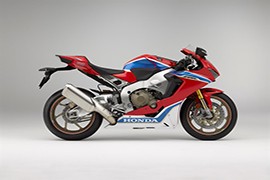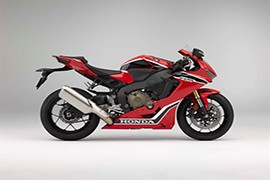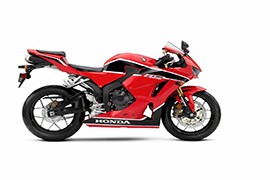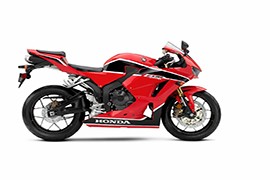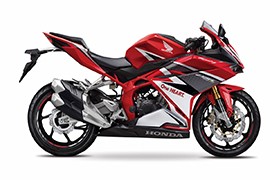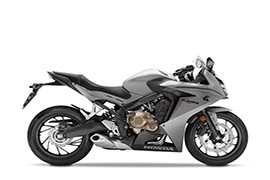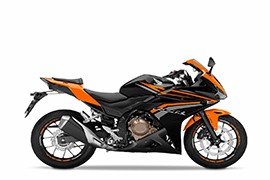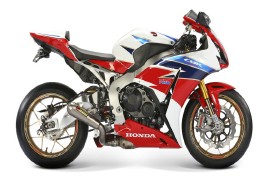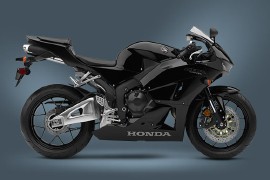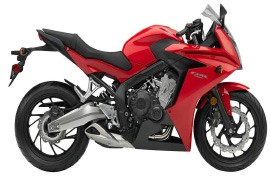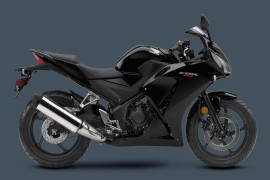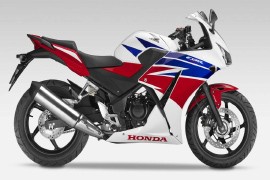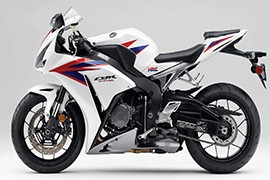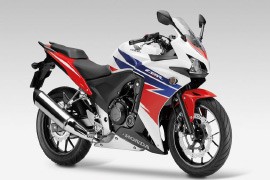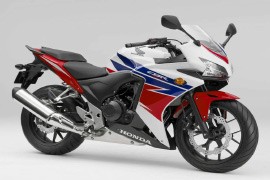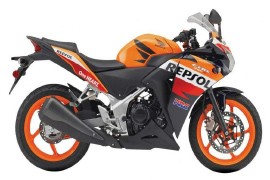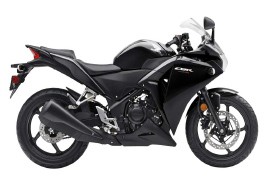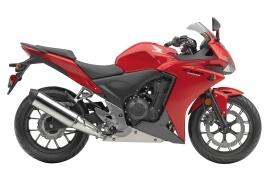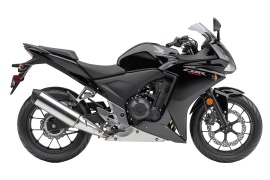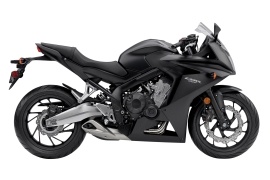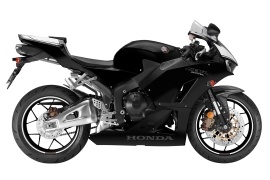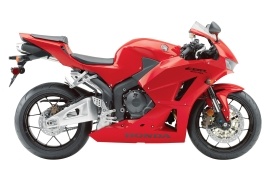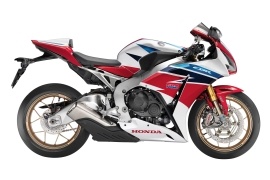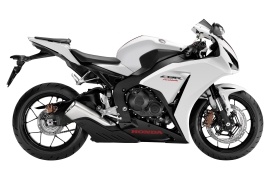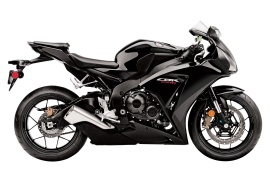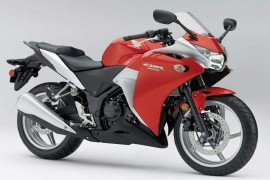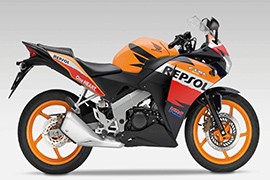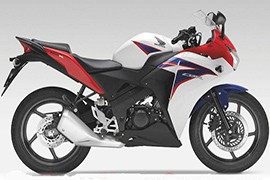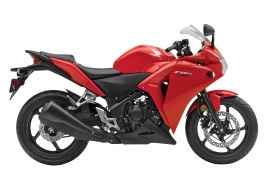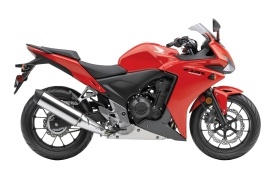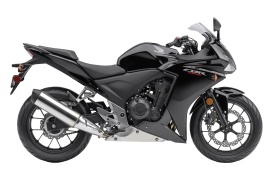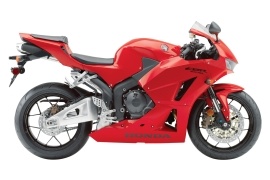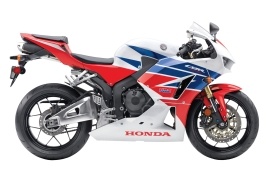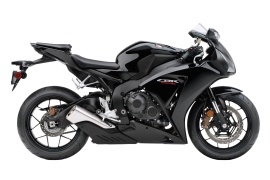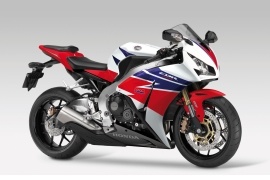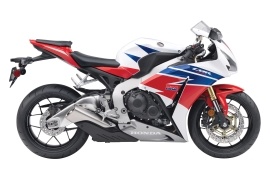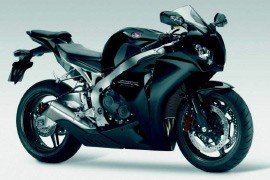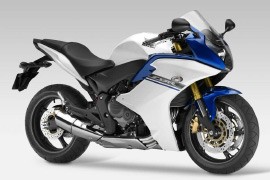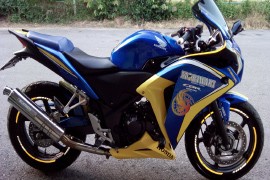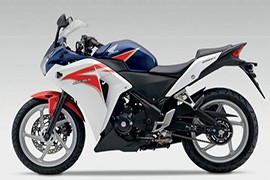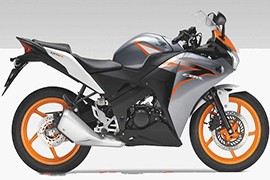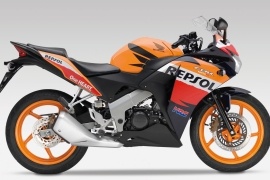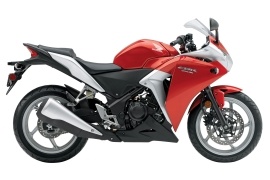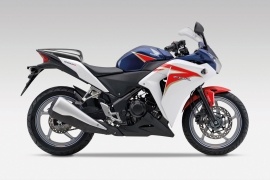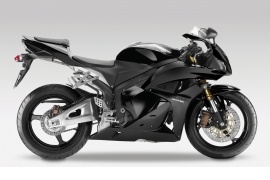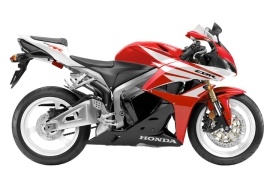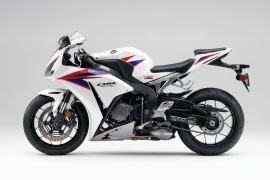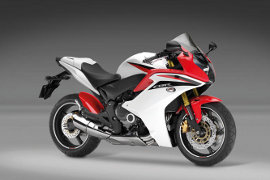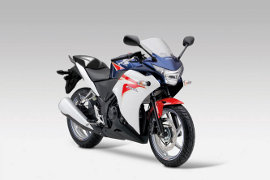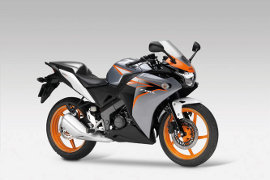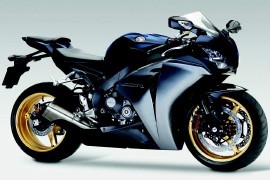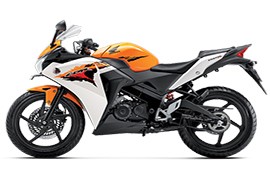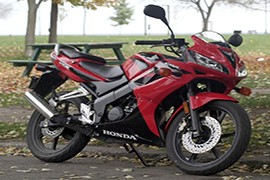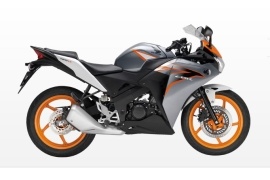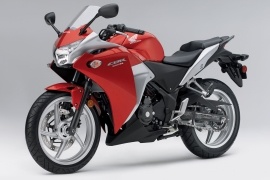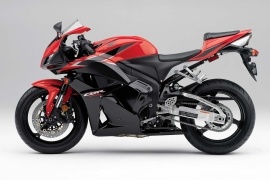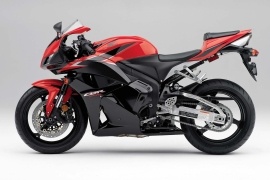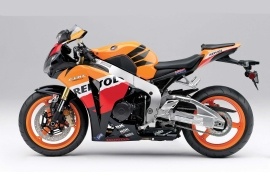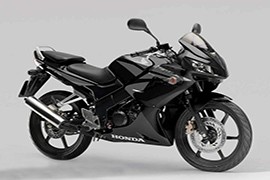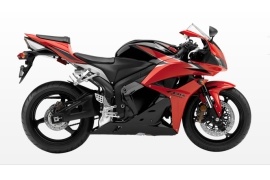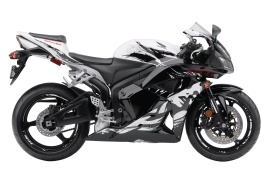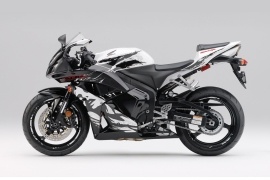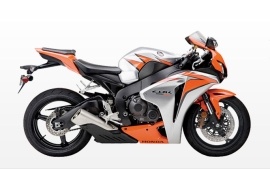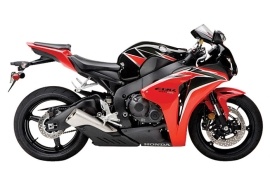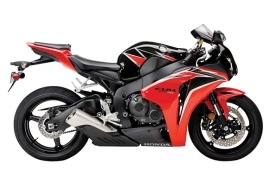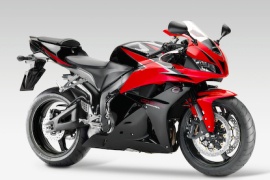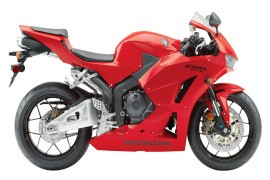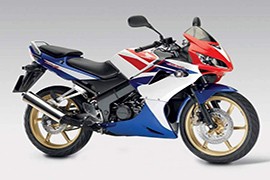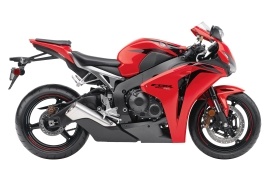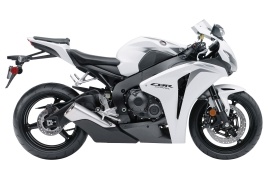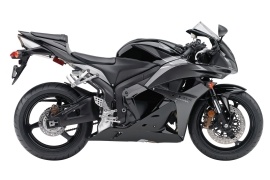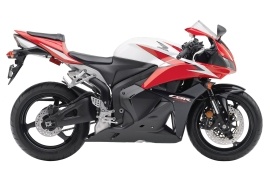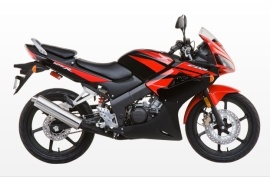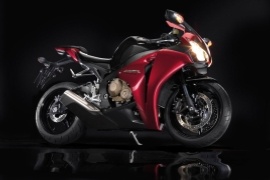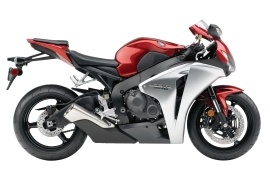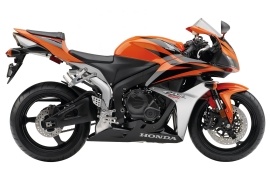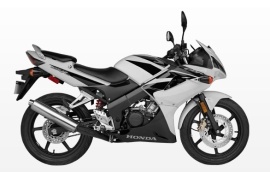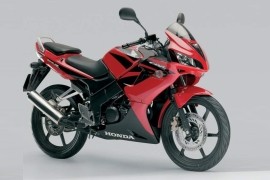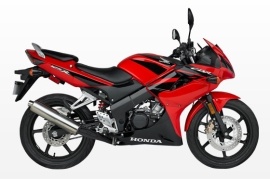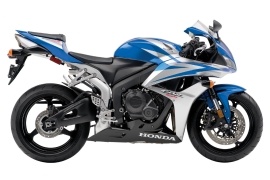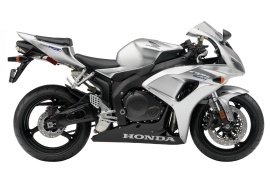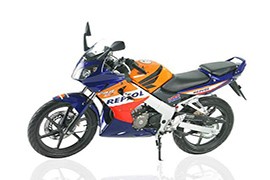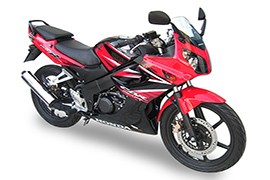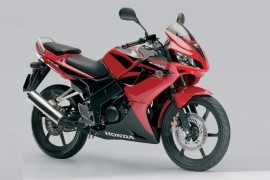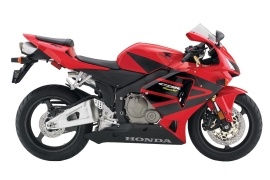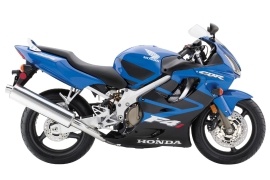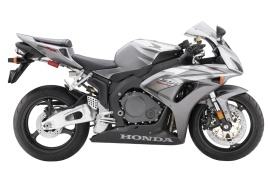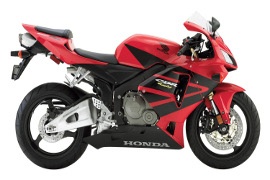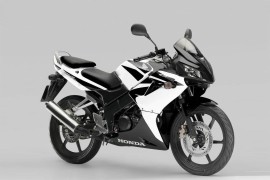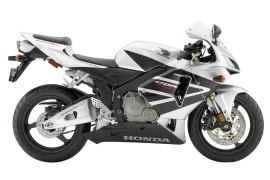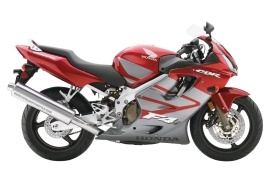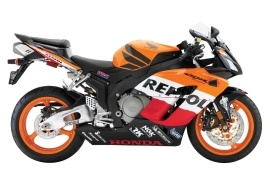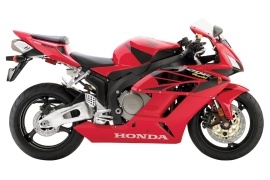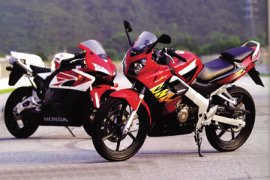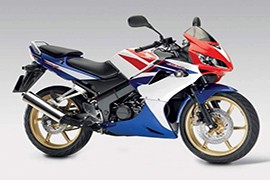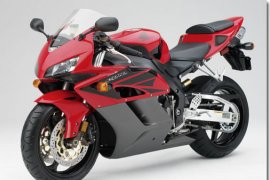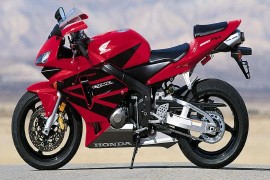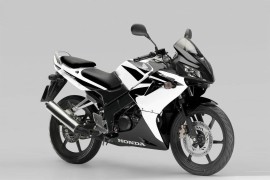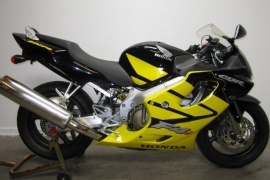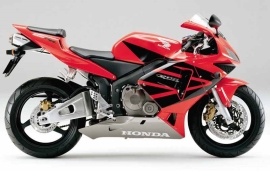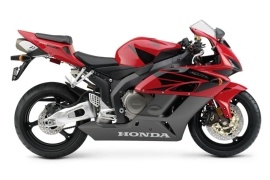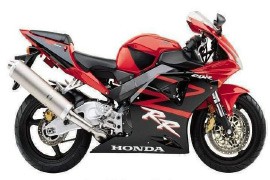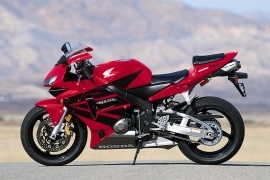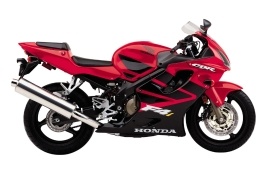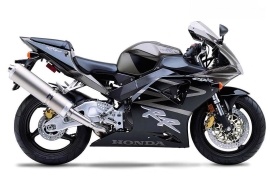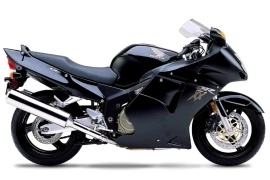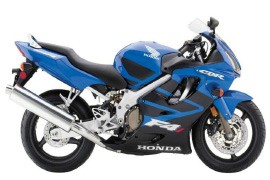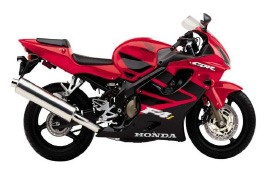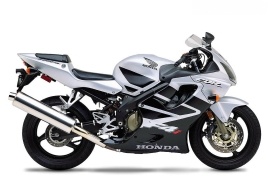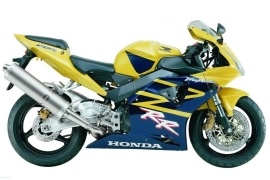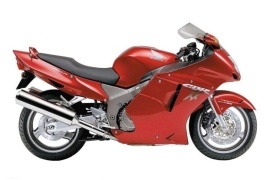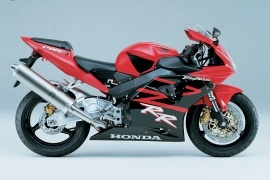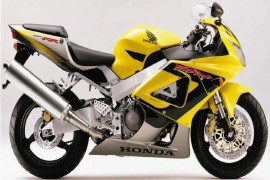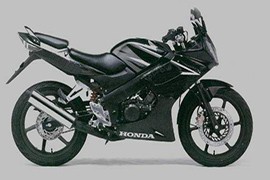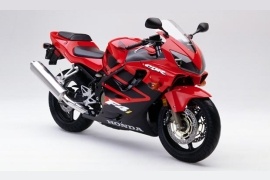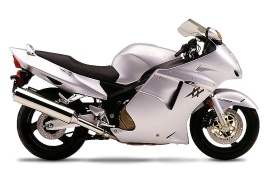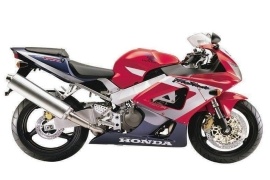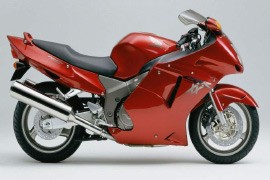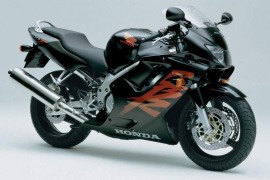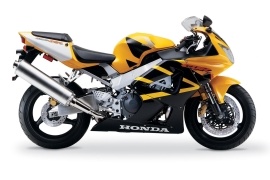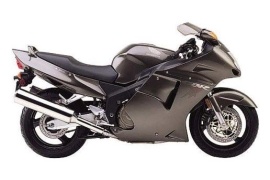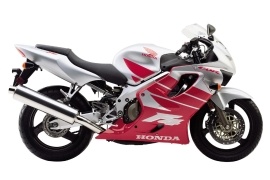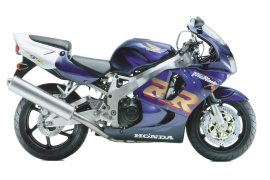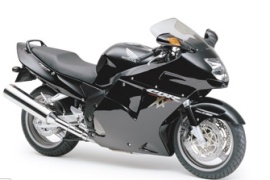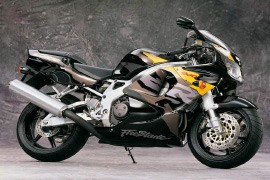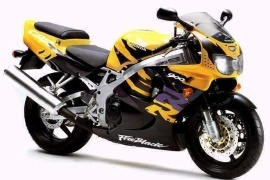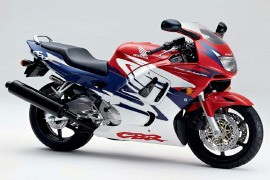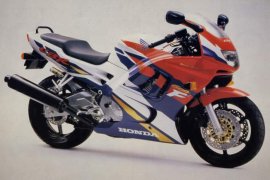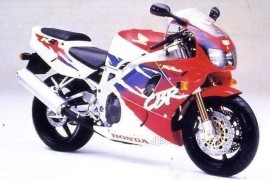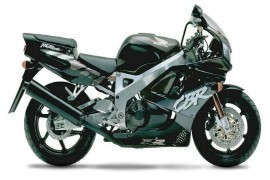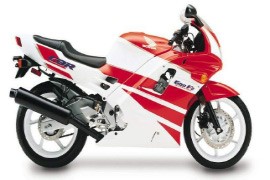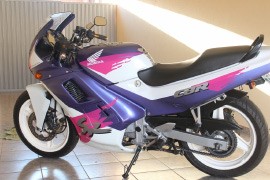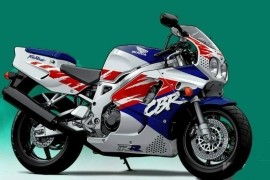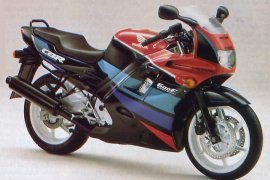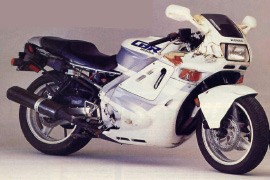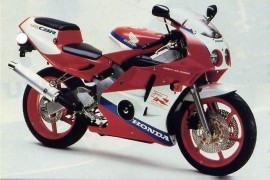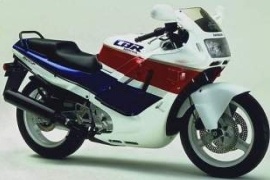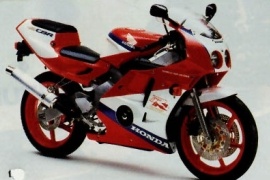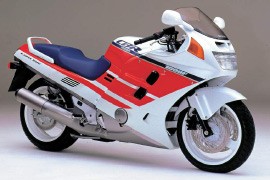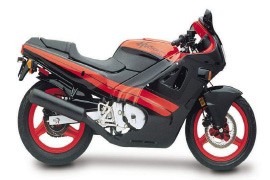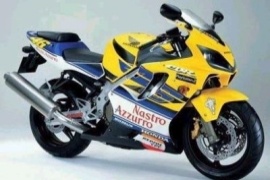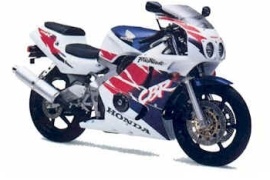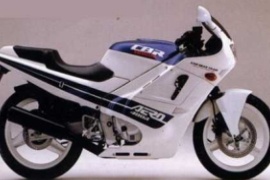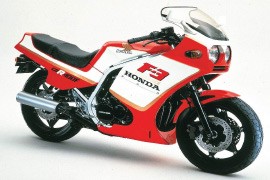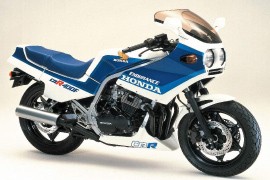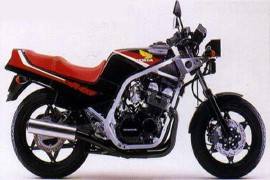HONDA CBR Models/Series Timeline, Specifications & Photos
First production year: 1983
In 2017, the Japanese motorcycle manufacturer launched the Honda CBR1000RR SP, which was the first Honda motorcycle that featured semi-active Ohlins Electronic Control (S-EC) suspension both front and rear but also packed Brembo monobloc four-piston front brake calipers and a titanium fuel tank.
As for electronic aids, the SP version featured three Active Modes and three Manual Modes. When the bike was set in Active Mode, the damping force was controlled and optimized for riding conditions, such as A1 for Fast, A2 for Enjoy, and A3 for Safety, while the Manual Mode, such as M1, M2, and M3 modes allowed the rider to make any required adjustability.
Also, the 2017 Honda CBR1000RR SP was the first motorcycle with a four-cylinder engine made by the Japanese motorcycle manufacturer that feature Throttle by Wire (TBW) control that offered a precise throttle response, derived and developed based on the one used by the RC213V-S machine.
In the performance department, the CBR1000RR SP model had at its core a 999cc four-stroke four-cylinder liquid-cooled engine that featured a Honda Dual Stage Fuel Injection (DSFI) system that helped deliver an output power of 189 hp with a peak at 12,250 rpm and 116 Nm (86 lb-ft) of torque available at 11,000 rpm.
For suspension, the bike packed a 43 mm adjustable inverted Ohlins fork on the front and an adjustable Unit Pro-Link gas-charged Ohlins shock absorber on the rear.
As for braking performance, it packed two 320 mm discs with four-piston radial-mounted Tokico calipers on the front wheel and a 220 mm disc squeezed by a single-piston caliper on the rear wheel.
In 2017, along with the 25th anniversary of the Fireblade, the Japanese motorcycle manufacturer launched the CBR1000RR. The updated flagship model came in an almost completely changed shape and form, with new bodywork and features, such as throttle-by-wire and traction control, that worked in tandem with selectable riding modes.
Besides the base model, Honda also added two special edition models, such as the SP, which featured semi-active Ohlins Electronic Control Suspension (S-EC), Brembo monobloc four-piston front brake calipers, and a titanium fuel tank, while the SP2 version was a more exotic limited production model that came in 500 units and featured Marchesini forged wheels and larger valves.
The 2017 Honda CBR1000RR came with a revised engine that provided 10 hp more than the previous model, a titanium muffler that saved 2.8 kg (6,2 lbs), and a 14 kg (33 lbs) reduction in weight compared with the previous ABS model.
Also, the model featured lots of electronic settings, such as three rider modes, five levels of power delivery, three levels of wheelie control, and three levels of engine braking control.
In the muscle department, the 2017 Honda CBR1000RR had at its core a 999cc four-stroke four-cylinder liquid-cooled engine fitted with a Dual Stage Fuel Injection (DSFI) system that helped deliver an output power of 189 hp with a peak at 13,000 rpm and 114 Nm (84 lb-ft) of torque available at 11,000 rpm.
As for stopping power, the bike packed two 320 mm discs with Tokico four-piston calipers on the front and a 220 mm disc squeezed by a single-piston caliper on the rear wheel.
The Honda CBR600RR was a sports bike part of the CBR series made by the Japanese motorcycle manufacturer Honda since 2003. The bike was marketed as a top-of-the-line middleweight sports bike and a successor to the 2002 Supersport World Championship-winning CBR600F4i.
The bike was based on technologies used by the Honda RC211V MotoGP bike but also with a similar appearance and was the first bike that featured a Unit Pro-Link rear suspension that helped isolate unwanted forces transmitted to the steering head.
In 2005, the bike received a major revision that included a new bodywork, a fully-adjustable inverted fork on the front, radial-mounted four-piston brake calipers, a new aluminum frame, swingarm, and rear shock absorber.
In 2013, the CBR600RR came in a new package that included new 12-spoke aluminum wheels, revised Electronic Control Unit (ECU) settings, a fine-tuned ram air system that increased torque, a new Showa Big Piston Fork (BPF) on the front, a new shock absorber on the rear, and a new bodywork.
In 2017, the Japanese motorcycle manufacturer launched the Honda CBR600RR, which came unchanged since its last revision in 2013.
As for 2018, the Honda CBR600RR featured a Honda Electronic Steering Damper (HESD) that was more sophisticated and detected vehicle speed adjusting damping force and maintaining low-speed maneuverability and offering excellent high-speed handling.
In the power department, the 2018 Honda CBR600RR had at its core a 599cc four-stroke four-cylinder engine that delivered an output power of 118 hp at 13,500 rpm and 66 Nm (49 lb-ft) of torque at 11,250 rpm.
The Honda CBR600RR ABS was a sports motorcycle manufactured by Honda in 2017 that featured race-derived technology gained from the RC212V MotoGP racing program. The 2017 Honda CBR600RR ABS featured the electronically controlled Combined ABS (C-ABS) braking unit that added more safety at hard braking and slippery surfaces.
For suspension, the bike packed a 41 mm inverted Showa Big Piston Fork (BPF) on the front with an electronically controlled steering damper that enhanced high-speed handling and low-speed maneuverability, while a Unit Pro-Link HMAS shock absorber handled the rear suspension.
For braking purposes, the ABS version featured two 310 mm discs with radial-mounted four-piston calipers on the front wheel and a 220 mm disc with a single-piston caliper on the rear wheel that provided optimum stopping power.
Also, the chassis came in a lightweight package that offered great stability, dressed in an aggressive and aerodynamic bodywork that offered 6.5 percent reduced drag force compared to earlier models.
In the performance department, the 2017 Honda CBR600RR ABS was powered by a compact 599cc four-stroke four-cylinder liquid-cooled engine fitted with a Dual Stage Fuel Injection (DSFI) system and delivered an output power of 118 hp at 13,500 rpm and 66 Nm (49 lb-ft) of torque available at 11,250 rpm.
In addition, the bike featured slim turn signals indicators, a centrally-mounted fuel tank, an optional passenger seat cowl, aerodynamic mirrors, and much more.
The Honda CBR250RR was a sports motorcycle made in Indonesia and unveiled in 2016 in Jakarta. The bike was part of the CBR series and was the first and smallest CBR motorcycle that packed a twin-cylinder engine with an RR badge.
Honda claimed that the CBR250RR featured technologies derived from the RC213V MotoGP machine, such as throttle-by-wire technology, three riding modes, and a more compact engine design than its competitors. Also, it was the first motorcycle in its class that featured the TBW system, which offered a more precise throttle response.
The bike was powered by a newly developed engine that offered easy handling in the urban jungle and was just as comfortable on the track. In addition, the throttle-by-wire system, along with the selectable three-way engine modes, allowed the rider to tap into its linear power for superior and solid acceleration.
The 2017 Honda CBR250RR had its soul brought to life by a 249cc four-stroke parallel twin-cylinder liquid-cooled engine that delivered an output power of 36 hp with maximum strength at 12,500 rpm and 23 Nm (17 lb-ft) of torque available at 10,500 rpm.
The newly designed steel pipe truss frame offered both strength and flexibility and packed an inverted telescopic fork on the front and a five-step preload Pro-Link suspension on the rear.
As for braking performance, the bike packed a 310 mm disc with a two-piston caliper on the front wheel and a 240 mm disc squeezed by a single-piston caliper on the rear wheel, which provided strong braking performance.
In 2017, the Japanese motorcycle manufacturer launched the Honda CBR650F, a motorcycle that had the sporting credentials to live up to the CBR designation, with a unique style made by a young team of engineers who wanted to create a modern and unique sports bike.
From the minimalist full fairing that left most of the engine exposed to the sweeping exhaust muffler and the racing aluminum swingarm, the CBR650F was attractive from every angle, plus the frame's color scheme added in 2016, which came in a Red or White color.
Also, for the 2017 model, Honda revised the model with a fresh color scheme, the integration of the EURO4 emission regulations, a crankcase color changed from black to bronze, an LED headlight, an updated air intake flow path, a smaller two-chamber exhaust muffler, Showa Dual Bending Valve (SDBV) front suspension, and ABS as a standard option.
Other than that, the bike packed the same suspension as its predecessor, with a 41 mm conventional telescopic fork on the front and a single shock absorber with preload adjustability on the rear.
The braking power was also carried from its predecessor, with two 320 mm discs with dual-piston calipers on the front and a 220 mm disc with a single-piston caliper on the rear that offered optimum stopping power.
In the engine department, the 2017 Honda CBR650F had its soul brought to life by a 649cc four-stroke four-cylinder liquid-cooled engine fed by an electronically controlled fuel injection system that helped deliver an output power of 86 hp at 11,000 rpm and 63 Nm (46 lb-ft) of torque at 8,000 rpm.
The Honda CBR500R was a motorcycle part of a series of straight-twins motorcycles made by the Japanese motorcycle manufacturer since 2013. The range included the CBR500R, which was the sports model in the series, the CB500F standard or naked machine, and the CB500X adventure tourer bike.
The models were also sold in Japan with a smaller-capacity 399cc engine, while their introduction coincided with the European licensing regulations that established a mid-range class of limited-power motorcycles.
In 2017, the Japanese maker launched the CBR500R sports bike that benefited from the last upgrade in 2016, which included EURO4 compliance with a smaller exhaust system, LED headlight, preload adjustable front suspension, smaller side covers, a larger fuel tank, and Fireblade fairing.
In the performance department, the 2017 Honda CBR500R had its soul brought to life by a 471cc four-stroke parallel-twin liquid-cooled engine fed by a Programmed Fuel Injection (PGM-FI) system and delivered an output power of 47 hp with a peak at 8,500 rpm and 43 Nm (32 lb-ft) of torque available at 7,000 rpm.
For suspension, the bike packed a 41 mm telescopic fork on the front and a Pro-Link single shock absorber on the rear with nine-position spring preload adjustability, while the braking performance was handled by a 320 mm wave disc with a dual-piston caliper on the front and a 240 mm wave disc with a single-piston caliper on the rear wheel.
The Honda CBR1000RR was one of the sportiest motorcycles ever built by the Japanese motorcycle manufacturer at the time, a bike loaded with race-derived features that delivered impressive performance, excellent handling, and massive power.
The 2016 Honda CBR1000RR featured the same modifications brought upon the 2014 model, such as a modified rider position, a new windscreen, and a revised engine that delivered more power and torque.
In the power department, the engine featured a polished combustion chamber, intake, and exhaust ports that improved both the quality and quantity of airflow at high rpm when airflow resistance was much greater, which also increases combustion efficiency and output power.
As for the power figures, the 2016 Honda CBR1000RR was powered by a 999cc four-stroke four-cylinder liquid-cooled engine fitted with a Dual Stage Fuel Injection (DSFI) system that helped achieve an output power of 178 hp with a peak at 12,250 rpm and 114 Nm (84 lb-ft) of torque available at 10,500 rpm.
Also, bolted to the engine, the six-speed manual transmission features a MotoGP-derived Assist Slipper Clutch that provided excellent downshifting and deceleration, while the lever pull was much lighter.
Along with the adjustable Showa suspension and the hollow 12-spoke lightweight aluminum wheels, the bike featured a second-generation Honda Electronic Steering Damper (HESD) that monitored speed and adjusted the damping force automatically, which enhanced stability at high speeds and provided light steering at low speeds.
The Honda CBR600RR was released by the Japanese motorcycle manufacturer in 2016 as a middleweight sports motorcycle that featured race-derived technology with massive performance and comfortable handling.
The bike rolled on a set of 12-spoke cast aluminum wheels fitted on race-derived suspension both front and rear, with a lightweight chassis dressed in an aggressive, aerodynamic bodywork developed using the knowledge gained from the RC212V MotoGP racing program.
For suspension, the bike packed a 41 mm inverted Showa Big Piston Fork (BPF) on the front with spring preload, rebound, and compression adjustability topped by an electronically controlled steering damper that enhanced handling precision and a Unit Pro-Link HMAS shock absorber on the rear.
As for braking performance, the model packed two 310 mm discs with radial-mounted four-piston calipers on the front wheel and a 220 mm disc with a single-piston caliper on the rear wheel that provided optimum stopping power.
In the engine department, the 2016 Honda CBR600RR was powered by a 599cc four-stroke four-cylinder liquid-cooled powerplant that feature a Dual Stage Fuel Injection (DSFI) system and delivered an output power of 118 hp at 13,500 rpm and 66 Nm (49 lb-ft) of torque available at 11,250 rpm.
In addition, the bike featured slim turn signals indicators, a centrally-mounted fuel tank, an optional passenger seat cowl, aerodynamic mirrors, and much more.
The Honda CBR650F was a standard motorcycle part of the CBR series made by the Japanese motorcycle manufacturer since 2013. The lineup of the 650cc class included two models, such as the CB650F, which was a standard machine, and the CBR650F, which was a sports bike that replaced the CB600F Hornet.
In 2016, Honda released the CBR650F, a motorcycle with a unique style created by a team of young engineers, with a minimalist full fairing that left most of the engine uncovered, sweeping exhaust mufflers, and racing arched aluminum swingarm.
The bike offered a great combination of sports bike performance, versatility, and value with the quality and attention to detail that made Honda famous. The bike came in two versions, such as the CBR650F standard machine and the ABS version, which added a touch of safety that suited riders of all levels.
In the performance department, the 2016 Honda CBR650F took its muscles from a 649cc four-stroke four-cylinder liquid-cooled engine fed by an electronically controlled fuel injection system that helped deliver an output power of 86 hp at 11,000 rpm and 63 Nm (46 lb-ft) of torque at 8,000 rpm.
For suspension, the bike packed a 41 mm conventional telescopic fork on the front and a single shock absorber with preload adjustability on the rear, while the braking performance was handled by two 320 mm discs with dual-piston calipers on the front and a 220 mm disc with a single-piston caliper on the rear.
The Honda CBR300R was an entry-level sports bike part of the CBR series in Honda's range that had its debut in 2014 as an upgraded model from the previous CBR250R machine, with an increased engine displacement, horsepower, and torque.
In 2015, the Japanese motorcycle manufacturer launched the Honda CBR300R, a sports bike in its second year of production that came with the same package as the 2014 model and offered the perfect balance of beginner-friendly features and typical Honda refinement.
Compared to the CBR250R machine, the 300R developed more horsepower, from 26 to 31 hp, and more torque, from 23 to 27 Nm. The bike was also available with an Anti-Lock Braking System (ABS) that enhanced safety and handling capabilities.
Other differences included the fairing and headlight, which were restyled to more resemble the CBR RR line, a new exhaust system, new engine mounts, a new seat and side panels that offered an easier reach to the ground, and a slightly more sporty riding position.
Some of the internal changes included new pistons, connecting rods, and crankshaft along with an increased displacement and taller gearing for better cruising, while the tires and suspension remained the same as on the CBR250R model.
In the performance department, the 2015 Honda CBR300R had its soul brought to life by a 286cc four-stroke single-cylinder liquid-cooled engine that delivered an output power of 31 hp at 8,500 rpm and 27 Nm (20 lb-ft) of torque at 7,250 rpm.
In 2013, at the China International Motorcycle Trade Exhibition in Chongqing, the Japanese motorcycle manufacturer announced the longer-stroke CBR300R, an upgraded model from the CBR250R that featured an increased engine displacement. The bike was a response to Kawasaki's Ninja 300 model.
Compared to the CBR250R machine, the 300R developed more horsepower, from 26 to 31 hp, and more torque, from 23 to 27 Nm. The bike was also available with an Anti-Lock Braking System (ABS) that enhanced safety and handling capabilities.
The CBR300R was different from its predecessor in several ways, such as the fairing and headlight, which were restyled to more resemble the CBR RR line, a new exhaust system, new engine mounts, a new seat and side panels that offered an easier reach to the ground, and a slightly more sporty riding position.
Some of the internal changes included new pistons, connecting rods, and crankshaft along with an increased displacement and taller gearing for better cruising, while the tires and suspension remained the same as on the CBR250R model.
For suspension, the bike packed a 37 mm telescopic fork on the front with 120 mm of wheel travel and a five-position preload adjustable shock absorber on the rear with 103 mm of wheel travel.
For stopping power, the bike featured a single 296 mm disc with a two-piston caliper on the front wheel and one 220 mm disc with a single-piston caliper on the rear wheel for optimum braking performance.
As for the power figures, the 2014 Honda CBR300R took its muscles from a 286cc four-stroke single-cylinder liquid-cooled engine that delivered an output power of 31 hp at 8,500 rpm and 27 Nm (20 lb-ft) of torque at 7,250 rpm.
The Honda CBR125R was a sports motorcycle part of the CBR series in Honda's range powered by a 125cc single-cylinder engine. The bike first appeared on the market in 2004 and was manufactured by A.P. Honda in Thailand alongside the similarly designed CBR150R that was targeted for the Far East market.
In 2014, the Japanese motorcycle manufacturer launched the Honda CBR125R, which benefitted from the major upgrade brought upon the 2011 model that came with a new look in line with the 2011 CBR250R, which in turn borrowed from the VRF1200F sports tourer.
The 2014 Honda CBR125R was a lightweight, entry-level machine designed for riders who were just starting out in the world of motorcycling. The bike offered a comfortable riding position and featured a sporty design with aerodynamic bodywork inspired by larger Honda sports bikes.
The bike featured a double cradle steel frame that housed a 31 mm telescopic fork with 109 mm of wheel travel on the front and a monoshock absorber on the rear with 120 mm of wheel travel.
In the braking department, the bike packed a single 276 mm disc with a two-piston caliper and one 220 mm disc squeezed by a single-piston caliper on the rear wheel for optimum stopping power.
As for the power figures, the 2014 Honda CBR125R had its muscles from a 124 cc four-stroke single-cylinder liquid-cooled engine that delivered an output power of 14 hp at 10,000 rpm and 11 Nm (eight lb-ft) of torque at 8,250 rpm.
The Honda CBR500R was a sports motorcycle part of a 500 twin series in Honda's range, first manufactured in 2013 along with the CB500F standard or naked bike and the CB500X adventure touring machine.
The series was also sold in Japan with a smaller-capacity 399cc engine in form of the CB400F, Cb400X, and CBR400R, and their introduction coincided with the European licensing regulations that established a mid-range class of motorcycles with limited power.
The CBR500R offered plenty of performance for the riders who were already familiar with the entry-level CBR250R, as well as more experienced ones who appreciated the bike’s nimble handling. Also, the bike offered great aerodynamic efficiency, with a low drag coefficient and effective engine cooling.
In the performance department, the 2013 Honda CBR500R had its heartbeat set by a 471cc four-stroke parallel-twin liquid-cooled engine fed by a PGM-FI system that helped deliver an output power of 47 hp with maximum strength at 8,500 rpm and 43 Nm (32 lb-ft) of torque available at 7,000 rpm.
For suspension, the bike packed a 41 mm telescopic fork on the front and a Pro-Link single shock absorber on the rear with nine-position spring preload adjustability, while the braking performance was handled by a 320 mm wave disc with a dual-piston caliper on the front and a 240 mm wave disc with a single-piston caliper on the rear wheel.
The CBR400R was a sports motorcycle manufactured by Honda between 2013 and 2016, along with the standard CB400F and adventure touring CB400X models. The bikes were powered by a 399cc engine and sold only in Japan due to the new European licensing regulations.
In other markets, the same versions were sold with a slightly larger engine under the CB500 badge and similar to the earlier CB500 parallel twin bikes discontinued in 2003 but all-new from the ground up. All the models shared the same six-speed transmission along with other cycle parts.
The 2014 CBR400R sports model came with standard features, such as a full fairing with a small windscreen, a blacked-out engine and frame, black-finished 12-spoke cast aluminum wheels, a chromed exhaust system, a two-piece two-up seat, and a side stand.
For suspension, the bike packed a 41 mm telescopic fork on the front and a Pro-Link single shock absorber with nine-position spring preload adjustability, while the stopping power was handled by a 320 mm disc with a dual-piston caliper on the front wheel and a 240 mm disc with a single-piston caliper on the rear wheel.
In the power department, the 2014 Honda CBR400R had its soul brought to life by a 399cc four-stroke parallel-twin liquid-cooled engine fed by an electronically controlled fuel injection system that helped deliver an output power of 49 hp with maximum strength at 9,500 rpm and 38 Nm (28 lb-ft) of torque.
In 2013, the Japanese motorcycle manufacturer launched the Honda CBR250R Repsol, an updated version of the standard model that came only with cosmetic changes, such as a new black exhaust cover and color schemes that included Pearl White with Blue and Red, Red, and Black, and the Repsol treatment.
All CBR250R models manufactured in 2013 were available with Anti-Lock Braking System (ABS) as an option, except for the Repsol edition that packed it as a standard feature, while the 249cc engine made the bike a sporty and manageable machine for new riders.
The Repsol edition was dressed to resemble Casy Stone's, Dani Pedrosa's, and Marc Marquez Honda RC213V MotoGP race bikes. The bike featured the Honda Racing Corporation Logo, the Spanish petroleum Company's colors, and the One Heart motto of Honda's Indonesian joint venture.
In the power department, the 2013 Honda CBR250R Repsol edition motorcycle had its muscles flexed by a 249cc four-stroke single-cylinder liquid-cooled engine that delivered an output power of 26 hp with a peak at 8,500 rpm and 23 Nm (17 lb-ft) of torque available at 6,750 rpm.
The bike was built around a diamond-shaped twin-spar steel frame that housed on the front end a 37 mm telescopic fork and a Pro-Link monoshock absorber on the rear.
As for braking performance, the bike packed two 296 mm discs with two-piston calipers on the front wheel and a single 220 mm disc squeezed by a single-piston caliper on the rear wheel that provided strong stopping power.
In 2013, the Japanese motorcycle manufacturer launched the Honda CBR250R, a sports motorcycle powered by a single-cylinder engine and, with a similar style to the VRF1200F model, with its Y-shaped headlight and prominent middle cowl.
The bike made its way into its third year of production with some cosmetic changes that included a new black exhaust cover and black wheels fitted on every available color scheme, such as Pearl White with Blue or Red, Red, Black, and on the new Repsol livery.
With a narrow design, the diamond-shaped twin-spar steel frame featured on the front end a 37 mm telescopic fork and a Pro-Link monoshock absorber on the rear that offered great handling and suspension performance.
As for braking performance, the bike packed a 296 mm disc with a dual-piston caliper on the front wheel and a 220 mm disc with a single-piston caliper on the rear wheel, which provided strong stopping power.
The Anti-lock Braking System (ABS) was an optional feature for all 2013 Honda CBR250R models, except for the Repsol edition that came with ABS as a standard option.
As for performance, the bike was powered by a 249cc four-stroke single-cylinder liquid-cooled engine that made it a sporty yet manageable machine for new riders and delivered an output power of 26 hp with maximum strength at 8,500 rpm and 23 Nm (17 lb-ft) of torque available at 6,750 rpm.
In 2014, the Japanese motorcycle manufacturer launched the Honda CBR500RA ABS, a sports bike part of a 500 twin series that first appeared in 2013 and came in a better-equipped version of the CBR500R in terms of safety.
The added Anti-Lock Braking System (ABS) provided a shorter stopping distance on dry and slippery surfaces while also minimizing the skid effect when the braking lever was applied hard on less-than-ideal surfaces, such as wet asphalt, concrete, and dusty roads.
In any other department, the ABS version was identical to the standard model, except for the additional weight of the ABS modulator. The bike was a perfect semi-naked machine for beginner riders but also for the more seasoned ones.
The CBR500R ABS offered plenty of performance for the riders who were already familiar with the entry-level CBR250R, as well as more experienced ones who appreciated the bike’s nimble handling. Also, the bike offered great aerodynamic efficiency, with a low drag coefficient and effective engine cooling.
In terms of power, the 2014 Honda CBR500RA ABS had its soul brought to life by a 471cc four-stroke parallel-twin liquid-cooled engine fed by a PGM-FI system that helped deliver an output power of 47 hp with maximum strength at 8,500 rpm and 43 Nm (32 lb-ft) of torque available at 7,000 rpm.
The Honda 500 twins was a series of straight-twin motorcycles manufactured by Honda since 2013 that included the CB500X adventure touring machine, the CB500F standard or naked bike, and the CBR500R sports bike.
The models were also sold in Japan with a smaller-capacity 399cc engine, while their introduction coincided with the European licensing regulations that established a mid-range class of limited-power motorcycles.
In 2014, the Japanese motorcycle manufacturer launched the Honda CBR500R, the sports model in the range that offered plenty of performance for riders who were already familiar with the entry-level CBR250R, as well as more experienced ones who appreciated the bike’s nimble handling.
In the horsepower department, the 2014 Honda CBR500R took its thrust from a 471cc four-stroke parallel-twin liquid-cooled engine fed by a PGM-FI system that helped deliver an output power of 47 hp with maximum strength at 8,500 rpm and 43 Nm (32 lb-ft) of torque available at 7,000 rpm.
For suspension, the bike packed a 41 mm telescopic fork on the front and a Pro-Link single shock absorber on the rear with nine-position spring preload adjustability, while the braking performance was handled by a 320 mm wave disc with a dual-piston caliper on the front and a 240 mm wave disc with a single-piston caliper on the rear wheel.
The Honda 650 standard and sports bikes were part of a range of 650cc motorcycles manufactured by the Japanese maker since 2013, which included two models, such as the CB650F standard or naked bike and the CBR650F sports machine that replaced the CB600F Hornet.
The Honda CBR650F came as a successor to the CBR600F and based on its style with a sports full fairing, a triangle headlight, a high clip-on handlebar, a one-piece seat, and available in a Red with Matt Black livery, while in some markets, it was offered in the iconic Honda tri-color scheme.
The 2014 CBR650F was a new addition to Honda's middleweight sports machines and targeted both young riders and more seasoned ones who were in search of a semi-naked all-rounder with top-drawer performance and excellent versatility.
The bike had evolved from the CBR600F models and brought plenty of power and usable torque in a street fashion with upgraded comfort, a digital instrument panel, a generous fuel tank, and an aggressive style.
For suspension, the bike packed a 41 mm conventional telescopic fork on the front and a single shock absorber with preload adjustability on the rear, while the braking performance was handled by two 320 mm discs with dual-piston calipers on the front and a 220 mm disc with a single-piston caliper on the rear.
In the performance department, the 2014 Honda CBR650F took its muscles from a 649cc four-stroke four-cylinder liquid-cooled engine fed by an electronically controlled fuel injection system that helped deliver an output power of 86 hp at 11,000 rpm and 63 Nm (46 lb-ft) of torque at 8,000 rpm.
The Honda 650 standard and sports bikes were part of a range of 650cc motorcycles manufactured by the Japanese maker since 2013, which included two models, such as the CB650F standard or naked bike and the CBR650F sports machine that replaced the CB600F Hornet.
The Honda CBR650F came as a successor to the CBR600F and based on its style with a sports full fairing, a triangle headlight, a high clip-on handlebar, a one-piece seat, and available in a Red with Matt Black livery, while in some markets, it was offered in the iconic Honda tri-color scheme.
The 2014 CBR650F was a new addition to Honda's middleweight sports machines and targeted both young riders and more seasoned ones who were in search of a semi-naked all-rounder with top-drawer performance and excellent versatility.
The bike had evolved from the CBR600F models and brought plenty of power and usable torque in a street fashion with upgraded comfort, a digital instrument panel, a generous fuel tank, and an aggressive style.
For suspension, the bike packed a 41 mm conventional telescopic fork on the front and a single shock absorber with preload adjustability on the rear, while the braking performance was handled by two 320 mm discs with dual-piston calipers on the front and a 220 mm disc with a single-piston caliper on the rear.
In the performance department, the 2014 Honda CBR650F took its muscles from a 649cc four-stroke four-cylinder liquid-cooled engine fed by an electronically controlled fuel injection system that helped deliver an output power of 86 hp at 11,000 rpm and 63 Nm (46 lb-ft) of torque at 8,000 rpm.
In 2014, the Japanese motorcycle manufacturer released the Honda CBR600RR ABS, a middleweight sports motorcycle that came with the same technical specifications as the base model, except for the addition of the ABS safety feature.
It was a lightweight motorcycle with a compact chassis dressed in an aerodynamic, aggressive-looking bodywork and featured the revolutionary Honda electronically-controlled Combined ABS (C-ABS) braking feature that added more safety on hard braking and slippery surfaces.
A nose-mounted dual-stage ram air intake system offered a high volume of cool air to the air box for linear power delivery and great engine performance, while the fuel was fed to the engine through a Dual Stage Fuel Injection (DSFI) system with 12-hole injectors that provided high-rpm engine performance.
As for the power figures, the 2014 Honda CBR600RR ABS had its heartbeat set by a 599cc four-stroke four-cylinder liquid-cooled engine that delivered an output power of 118 hp at 13,500 rpm and 66 Nm (49 lb-ft) of torque at 11,250 rpm.
For suspension, the bike packed a 41 mm inverted Showa Big Piston Fork (BPF) on the front with spring preload, rebound, and compression adjustability with an electronically controlled steering damper that enhanced handling precision and a Unit Pro-Link HMAS shock absorber on the rear.
The braking power was handled by two 310 mm discs with four-piston calipers on the front wheel and a 220 mm disc with a single-piston caliper on the rear wheel.
The Honda CBR600RR was launched by the Japanese motorcycle manufacturer in 2014 and featured the same updates received by the 2013 model packed in a lightweight package that delivered a high performance with a comfortable experience.
The latest updates brought upon the bike included a set of 12-spoke wheels, revised Electronic Control Unit (ECU) settings, re-tuned ram air system for more torque, a Showa Big Piston Fork (BPF), a revised rear shock absorber, and a more aggressive bodywork.
Honda made use of the knowledge gained from the RC212V MotoGP racing program and improved the aerodynamic efficiency of the bodywork, which resulted in a 6.5 percent decrease in drag force compared with previous models.
For suspension, the bike packed a 41 mm inverted Showa Big Piston Fork (BPF) on the front with spring preload, rebound, and compression adjustability with an electronically controlled steering damper that enhanced handling precision and a Unit Pro-Link HMAS shock absorber on the rear.
For stopping power, the bike was handled by two 310 mm discs with four-piston calipers on the front wheel and a 220 mm disc with a single-piston caliper on the rear wheel.
As for power, the 2014 Honda CBR600RR had its soul in a compact 599cc four-stroke four-cylinder liquid-cooled engine fitted with a Dual Stage Fuel Injection (DSFI) system and delivered an output power of 118 hp at 13,500 rpm and 66 Nm (49 lb-ft) of torque available at 11,250 rpm.
The Honda CBR1000RR SP, introduced as a 2014 model, was as close as possible to the racing machine, it brought to the road game a lot of pro-grade components, such as adjustable Ohlins suspension, race-class Brembo brakes, and hand-picked engine parts for durable and dependable performance.
Fitted on all 2014 models, the bubble-shaped windscreen, along with the revised rider position, provided enhanced wind protection, while only the SP model featured special graphics and a two-tone color scheme that provided a great appearance.
The SP model featured a modified twin-spar aluminum frame to match the Ohlins suspension, and the rigidity balance around the rear suspension was also altered for more flex and traction performance.
Also, on the front, the Sp model featured a second-generation Honda Electronic Steering Damper (HESD) that monitored speed and enhanced stability at high speed with minimized sudden steering angle changes, while at low speeds, the steering was unrestricted.
In the power department, the 2014 Honda CBR1000RR SP was powered by a 999cc four-stroke four-cylinder liquid-cooled engine fitted with a Dual Stage Fuel injection (DSFI_ system that helped deliver an output power of 178 hp at 12,250 rpm and 114 Nm (84 lb-ft) of torque at 10,500 rpm.
The bike rolled on a set of 12-spoke cast aluminum wheels in a gold-colored finish and with a unique pinstripe design shoded with street-legal Pirelli Diablo Supercorsa SP tires that offered excellent grip and handling.
In 2014, the Japanese motorcycle manufacturer released the Honda CBR1000RRA ABS, one of the most sportier bikes ever manufactured by Honda at the time, which like the 2014 base model, received the same modifications, such as a new rider position, a new windscreen, and more power and torque.
For the 2014 ABS model, the engineers focused on the cylinder head, intake, and exhaust ports, and polished the combustion chamber for improved efficiency. The engine was also remapped to match the revised cylinder head and delivered precise fueling and accessible power, especially at low rpm and low speeds.
The model featured a diamond-shaped aluminum twin-spar frame that hoasted the suspension system composed of a 43 mm adjustable inverted Showa Big Piston fork on the front and an adjustable Unit Pro-Link balance-free shock absorber on the rear with a long gull-wing swingarm that delivered excellent traction and rider feedback.
Also, the ABS version rolled on a set of 12-spoke cast aluminum wheels that improved handling performance and were fitted with two 320 mm discs with four-piston calipers on the front and a 220 mm disc with a single-piston caliper on the rear that delivered strong braking performance.
In the muscle department, the 2014 Honda CBR1000RRA ABS was powered by a 998cc four-stroke four-cylinder liquid-cooled that featured a Dual Stage Fuel Injection (DSFI) system that helped deliver an output power of 178 hp with maximum strength at 12,250 rpm and 114 Nm (84 lb-ft) of torque available at 10,500 rpm.
In 2014, the Japanese motorcycle manufacturer launched the Honda CBR1000RR, a sports motorcycle that was part of Honda's CBR series and one of the sportiest motorcycles ever produced by the maker at the time.
The new 2014 model came with several improvements that included a new riding position, a new windscreen for improved wind protection, modifications to the engine and exhaust system that delivered more output power and torque, and a new Pearl White color for the standard and ABS models.
The 2014 base model featured a twin-spar aluminum frame and a fully-adjustable suspension composed of a 43 mm Big Piston Showa fork on the front that offered more response and a smoother ride while on the rear it packed a Unit Pro-Link with a balance-free shock absorber and a double-tube design that delivered smoother response and better traction performance.
As for brakes, the bike packed two 320 mm discs with a couple of four-piston calipers on the front wheel and a 220 mm disc squeezed by a single-piston caliper on the rear wheel.
In the performance department, the 2014 Honda CBR1000RR was powered by a revised 998cc four-stroke four-cylinder liquid-cooled engine that delivered 178 hp with a peak at 12,250 rpm and 114 Nm (84 lb-ft) of torque available at 10,500 rpm.
Also, the bike rolled on a set of 12-spoke rigid cast aluminum wheels that matched the suspension performance and delivered improved handling and enhanced suspension feedback.
The Honda CBR250R was a sports motorcycle, part of the CBR series made by the Japanese motorcycle manufacturer in 2011, which featured a single-cylinder engine and a style borrowed from the VRF1200F model.
The 2012 CBR250R was similar in style to the VRF1200F machine, with its Y-shaped headlight and prominent middle cowl that created a layered look. The bike featured a full fairing cowl and a small windscreen that offered decent weather protection and reduced windblast.
The bike featured a diamond-shaped twin-spar steel frame fitted on the front end with a 37 mm telescopic fork and a Pro-Link single-shock absorber on the rear that offered impressive handling performance and a comfortable ride.
For stopping power, the bike packed a single 296 mm disc with a two-piston caliper on the front wheel and a 220 mm disc squeezed by a single-piston caliper on the rear wheel that provided strong braking performance.
In addition, the bike was available with a bunch of optional equipment, such as a U-lock designed to fit under the seat storage compartment, a carbon-look seat cowl for a more aggressive look, a rear seat bag, a tank pad, and wheel stickers.
As for power, the 2012 Honda CBR250R took its muscles from a 249cc four-stroke single-cylinder liquid-cooled engine fed by a fuel injection system that offered better start-up and fuel efficiency and delivered an output power of 24 hp at 9,900 rpm and 20 Nm (15 lb-ft) of torque available at 6,750 rpm.
The Honda CBR125R was a sports bike made by Honda in 2004, powered by a single-cylinder engine with the smallest displacement in the CBR series. The bike was manufactured to fill the gap in the 125cc market left by the discontinued NSR125 motorcycle.
The bikes manufactured between 2004 and 2006 were powered by a single-cylinder engine fed by a carburetor and resembled the CBR600F4i. Also, in 2005 Honda introduced the Repsol color scheme that was available only for the CBR125RS5/6 models.
In 2007, the CBR125R came in an updated package with redesigned front fairings that resembled the CBR600RR but also featured a black-finished swingarm and front fork. In the engine department, the maker introduced a new PGM-FI fuel injection system, an Idle Air Controle Valve (IACV), and a HECS3 oxygen sensor for EURO3 emission standards.
In 2011, the Honda CBR125R featured its first major revision since its first day of life, with changes to the looks that were brought in line with the 2011 CBR250R, which also borrowed its appearance from the VRF1200F sports tourer.
In 2012, the Japanese motorcycle manufacturer launched the CBR125R Repsol, a motorcycle that featured all the updates accumulated over the years and came in a Repsol Color scheme that enhanced its appearance.
The 2012 CBR125R Repsol motorcycle was powered by a 124cc four-stroke single-cylinder liquid-cooled engine that delivered an output power of 14 hp with maximum strength at 10,000 rpm and 11 Nm (8 lb-ft) of torque available at 8,250 rpm.
In 2012, the Japanese motorcycle manufacturer launched the Honda CBR125R, a small displacement motorcycle that featured the updates brought upon the 2011 model with a bodywork that resembled the big bike looks and improved wind protection.
The bike featured a lightweight diamond twin-spar steel frame that offered exciting handling and a comfortable riding position with a 31 mm telescopic fork on the front and a direct monoshock on the rear end that offered optimum suspension performance.
As for braking performance, the bike packed a set of cast aluminum wheels fitted with a 276 mm disc with a two-piston caliper on the front and a 220 mm disc with a single-piston caliper on the rear wheel that offered optimum stopping power.
The new bodywork offered more wind protection and more comfortable riding, especially on long-distance journeys, with a powerful single headlight and a bright taillight for great visibility.
As for performance, the 2012 Honda CBR125R was powered by a 124cc four-stroke single-cylinder liquid-cooled engine with a fuel injection system that delivered an output power of 14 hp at 10,000 rpm and 11 Nm (8 lb-ft) of torque available at 8,250 rpm.
The bike remained unchanged with its nimble handling from the lightweight chassis, the low-effort controls, the comfortable seat height, and the responsive engine fed by a PGM-FI electronic fuel-injected system.
The Honda CBR250 ABS was released in 2013 by the Japanese motorcycle manufacturer with the additional Anti-lock Braking System (ABS) safety feature for those riders that needed a safer braking performance on hard braking or slippery surfaces.
Also, the model featured the same changes as the standard model, which included a new black exhaust cover, black wheels, and new colors such as Repsol, Pearl White/Blue/Red, and Red and Black.
With a layered style fairing, the CBR250R ABS bodywork was designed for both style and functionality, with the airflow carefully routed for engine cooling and rider comfort, while offering a unique sports bike appearance.
The bike was built around a diamond-shaped twin-spar steel frame that featured a 37 mm telescopic fork on the front and a Pro-Link monoshock absorber on the rear that offered great handling and suspension performance.
As for braking performance, the bike packed a 296 mm disc with a dual-piston caliper on the front wheel and a 220 mm disc with a single-piston caliper on the rear wheel, which provided strong stopping power.
In the power department, the 2013 Honda CBR250R ABS had its soul brought to life by a 249cc four-stroke single-cylinder liquid-cooled fuel-injected engine that delivered an output power of 26 hp with maximum strength at 8,500 rpm and 23 Nm (17 lb-ft) of torque available at 6,750 rpm.
In 2013, the Japanese motorcycle manufacturer launched the Honda CBR250R, a sports motorcycle powered by a single-cylinder engine and, with a similar style to the VRF1200F model, with its Y-shaped headlight and prominent middle cowl.
The bike made its way into its third year of production with some cosmetic changes that included a new black exhaust cover and black wheels fitted on every available color scheme, such as Pearl White with Blue or Red, Red, Black, and on the new Repsol livery.
As for performance, the bike was powered by a 249cc four-stroke single-cylinder liquid-cooled engine that made it a sporty yet manageable machine for new riders and delivered an output power of 26 hp with maximum strength at 8,500 rpm and 23 Nm (17 lb-ft) of torque available at 6,750 rpm.
With a narrow design, the diamond-shaped twin-spar steel frame featured on the front end a 37 mm telescopic fork and a Pro-Link monoshock absorber on the rear that offered great handling and suspension performance.
As for braking performance, the bike packed a 296 mm disc with a dual-piston caliper on the front wheel and a 220 mm disc with a single-piston caliper on the rear wheel, which provided strong stopping power.
The Anti-lock Braking System (ABS) was an optional feature for all 2013 Honda CBR250R models, except for the Repsol edition that came with ABS as a standard option.
In 2013, the Japanese motorcycle manufacturer launched the Honda CBR500RA C-ABS, a motorcycle part of a 500 twin series that also included the CB500F standard or naked bike and the CB500X adventure tourer motorcycle.
The CBR500RA C-ABS was a better-equipped version of the standard CBR500R model and came with an additional safety feature well received even by the most demanding riders.
The 2013 Honda CBR500RA C-ABS retained all the nifty character of the base model and added the Combined Anti-Lock Braking System (C-ABS) that added a touch of safety by combining the branking power of both front and rear braking systems when the lever was engaged.
The bike featured the same technical specifications as the base model and was still powered by the 471cc four-stroke parallel-twin liquid-cooled engine fed by a PGM-FI system and delivered an output power of 47 hp with maximum strength at 8,500 rpm and 43 Nm (32 lb-ft) of torque available at 7,000 rpm.
For suspension, the bike packed a 41 mm telescopic fork on the front and a Pro-Link single shock absorber on the rear with nine-position spring preload adjustability, while the braking performance was handled by a 320 mm wave disc with a dual-piston caliper on the front and a 240 mm wave disc with a single-piston caliper on the rear wheel.
The Honda CBR500R was a sports motorcycle part of a 500 twin series in Honda's range, first manufactured in 2013 along with the CB500F standard or naked bike and the CB500X adventure touring machine.
The series was also sold in Japan with a smaller-capacity 399cc engine in form of the CB400F, Cb400X, and CBR400R, and their introduction coincided with the European licensing regulations that established a mid-range class of motorcycles with limited power.
The CBR500R offered plenty of performance for the riders who were already familiar with the entry-level CBR250R, as well as more experienced ones who appreciated the bike’s nimble handling. Also, the bike offered great aerodynamic efficiency, with a low drag coefficient and effective engine cooling.
In the performance department, the 2013 Honda CBR500R had its heartbeat set by a 471cc four-stroke parallel-twin liquid-cooled engine fed by a PGM-FI system that helped deliver an output power of 47 hp with maximum strength at 8,500 rpm and 43 Nm (32 lb-ft) of torque available at 7,000 rpm.
For suspension, the bike packed a 41 mm telescopic fork on the front and a Pro-Link single shock absorber on the rear with nine-position spring preload adjustability, while the braking performance was handled by a 320 mm wave disc with a dual-piston caliper on the front and a 240 mm wave disc with a single-piston caliper on the rear wheel.
In 2013, the Japanese motorcycle manufacturer launched the Honda CBR600RRA C-ABS, a middleweight sports bike that was equally at home on the street or on the track and came with improvements in both categories.
Honda managed to enhance the RRA personality with improved engine performance, handling, and aerodynamics without messing with its unique ability to be practical and comfortable on everyday riding.
The CBR600RRA featured a new aerodynamic, aggressive bodywork that offered a 6.5 percent reduction in drag force, a new fully-adjustable Showa Big Piston Fork (BPF), 12-spoke wheels borrowed from the CBR1000RRA machine, and an upgraded aluminum frame with a lighter aluminum swingarm that improved handling performance.
Also, the bike featured revised settings in the Programmed Dual Stage Fuel Injection (PGM- DSFI) system that improved engine performance under 7,000 rpm and a re-tuned ram air system that improved torque above 7,000 rpm.
Like its name says, the bike featured the electronically controlled Combined ABS (C-ABS) braking system that offered top-notch stopping power at hard braking and on slippery surfaces.
In the power department, the 2013 Honda CBR600RRA C-ABS was powered by the same 599cc four-stroke four-cylinder liquid-cooled engine used by the base 2013 model and delivered an output power of 118 hp with a peak at 13,500 rpm and 66 Nm (49 lb-ft) of torque at 11,250 rpm.
In 2013, Honda launched the CBR600RR, a middleweight motorcycle loaded with race-derived technologies that featured a sporty, nimble handling performance with a more comfortable ride than the racing version.
The 2013 model came with several improvements, such as a new set of 12-spoke wheels, revised Electronic Control Unit (ECU) settings, a fine-tuned ram air system that increased torque, a new Showa Big Piston Fork (BPF), a re-tuned rear shock absorber, and a new bodywork.
In the bodywork department, Honda made improvements to the aerodynamic performance using knowledge gained from the RC212V MotoGP race program, which resulted in a 6.5 percent decrease in drag force compared to the previous model.
Also, the development and testing used for the 2013 model, which offered more agile handling and improved wind efficiency, led to aerodynamic advancements that were also used on the RC212V MotoGP racing machine at the time.
In addition, the bike was available with a host of Honda Genuine Accessories, such as a sport screen, color-matched passenger seat cowl, carbon fiber-look rear fender, exhaust pipe cover, license plate frame, tank trim, and fuel lid cover, but also racing sticker kit.
As for performance, the 2013 Honda CBR600RR was powered by a compact 599cc four-stroke four-cylinder liquid-cooled engine that featured a Dual Stage Fuel Injection (DSFI) system with 12-hole injectors and delivered an output power of 118 hp at 13,500 rpm and 66 Nm (49 lb-ft) of torque available at 11,250 rpm.
The Honda CBR1000RR was one of the sportiest models ever manufactured by the Japanese maker, with race-derived features that delivered massive performance, great handling, riding, and built quality.
In 2013, Honda released the CBR1000RR C-ABS, a sports bike powered by a 998cc four-cylinder engine and set in motion by a six-speed manual transmission with a slipper clutch, and was offered in two versions, the standard and the C-ABS version.
As its name says, it featured C-ABS, which was a system that combined the traditional ABS with real-wheel lift control that allowed better braking performance and stability either on slippery surfaces or for track purposes.
Some of the key features of the bike were the dynamic styling package composed of the nose, main fairing, and tail section that created an aggressive and dynamic appearance, and the 12-spoke cast aluminum wheels that provided rigidity to match the suspension and also offered improved handling.
Among other race-derived features, the 2013 Honda CBR1000RR C-ABS had at its core a 998cc four-stroke four-cylinder liquid-cooled engine that delivered an output power of 176 hp at 12,000rpm and 115 Nm (85 lb-ft) of torque available at 8,500 rpm.
As for suspension, the bike packed a 43 mm telescopic fork with Showa's Big Piston technology on the front that increased front tire grip and offered better stability under braking and an advanced Showa rear shock system that was first offered on a production model with the 2012 model and offered a more accurate response and improved traction.
The Honda CBR1000RR released by the Japanese motorcycle manufacturer in 2013, was one of the most popular superbikes on the planet at the time and brought even more advanced technology to the track-developed machine.
The bike featured the advanced Showa rear suspension, which was offered for the first time on a production motorcycle in 2012, featuring a double-tube design for smoother and more accurate response, better damping, and improved traction.
At the front, the model packed a 43 mm telescopic fork that featured Showa Big Piston Fork technology with a unique design that reduced internal pressure and offered improved damping, better front tire grip, and more stability under braking.
Also, the bike packed a second-generation Honda Electronic Steering Damper (HESD) that was a must for a lightweight, compact, and powerful machine, which delivered high-speed stability and light, responsive steering at low speeds.
Inside the four-piece aluminum frame that firmly balanced strength, rigidity, and lightness was the soul of the bike that delivered the necessary performance for a race-derived machine that suited both city rides and track performance.
As for the power figures, the 2013 Honda CBR1000RR had its heartbeat set by a 998cc four-stroke four-cylinder liquid-cooled engine that delivered an output power of 176 hp with a peak at 12,000 rpm and 115 Nm (85 lb-ft) of torque available at 8,500 rpm.
The Honda CBR1000RR released by the Japanese motorcycle manufacturer in 2013, was one of the most popular superbikes on the planet at the time and brought even more advanced technology to the track-developed machine.
The bike featured the advanced Showa rear suspension, which was offered for the first time on a production motorcycle in 2012, featuring a double-tube design for smoother and more accurate response, better damping, and improved traction.
At the front, the model packed a 43 mm telescopic fork that featured Showa Big Piston Fork technology with a unique design that reduced internal pressure and offered improved damping, better front tire grip, and more stability under braking.
Also, the bike packed a second-generation Honda Electronic Steering Damper (HESD) that was a must for a lightweight, compact, and powerful machine, which delivered high-speed stability and light, responsive steering at low speeds.
Inside the four-piece aluminum frame that firmly balanced strength, rigidity, and lightness was the soul of the bike that delivered the necessary performance for a race-derived machine that suited both city rides and track performance.
As for the power figures, the 2013 Honda CBR1000RR had its heartbeat set by a 998cc four-stroke four-cylinder liquid-cooled engine that delivered an output power of 176 hp with a peak at 12,000 rpm and 115 Nm (85 lb-ft) of torque available at 8,500 rpm.
In 2011, the Japanese motorcycle manufacturer released the Honda CBR1000RR, a machine ready for both city rides and track performance, with its race-derived features that offered massive performance in a street-legal package.
The bike rewrote the rules for the sporting literbike class and established new standards for lightweight, handling, compact dimensions, and massive performance, with its electronically controlled Combined ABS (C-ABS) that added more safety on track and slippery surfaces and other race-derived features.
The lightweight twin-spar aluminum frame offered perfect balance, while at the front end was a 43 mm inverted HMAS cartridge-type telescopic fork with preload, compression, and rebound adjustment and on the rear, it packed an adjustable Unit Pro-Link HMAS gas-charged shock absorber.
As for braking performance, the model packed two 320 mm discs with four-piston calipers on the front wheel and a 220 mm disc squeezed by a single-piston caliper on the rear wheel that provided strong braking performance.
In the power department, the 2011 Honda CBR1000RR was powered by a 998cc four-stroke four-cylinder liquid-cooled engine fed by MotoGP-derived ram air intake and Dual Stage Fuel Injection (DSFI) systems that delivered an output power of 176 hp with a peak at 12,000 rpm and 115 Nm (85 lb-ft) of torque available at 8,500 rpm.
All that power was converted into speed by a six-speed manual transmission that launched the bike to a top speed of 287 kph (178 mph).
The Honda CBR600F was a sports bike in the CBR series made by the Japanese motorcycle manufacturer Honda, powered by a four-cylinder engine, with the first model sold from 1987 to 1990. The first model was also known as the Hurricane in the U.S. market, while in Austria and Mexico, Honda introduced a smaller version called CBR500F.
The original CBR600F, along with the CBR750F and CBR1000F, was the first four-cylinder, fully-faired sport bike manufactured by Honda with a style influenced by a European trend with a smooth and completely enclosed fairing like the Ducati Paso.
Over the years, in 2011, Honda launched the CBR600F, a model manufactured in Italy for the European market that continued the legacy of the CBR-F line. Also, the maker released a version of the CBR600F called CBR600F LCR that honored the German rider Stefan Bradl, a bike that featured an Arrow titanium exhaust system, Progrip handlebar grips, a rear hugger, a single seat cover, an LCR sticker kit, and Combined ABS.
In the performance department, the 2011 Honda CBR600F had its soul in a 599cc four-stroke four-cylinder liquid-cooled engine with an electronic fuel injection system that helped deliver an output power of 102 hp at 12,000 rpm and 64 Nm (47 lb-ft) of torque available at 10,500 rpm.
For braking power, the bike packed two 296 mm discs with a couple of two-piston calipers on the front wheel and a single 240 mm disc squeezed by a single-piston caliper on the rear wheel.
The Honda CBR250R was a lightweight motorcycle part of the CBR series, powered by a 249cc engine and with the looks of the VRF1200F model, notable for its Y-shaped headlight and prominent middle cowl that created a layered look.
The bike featured a diamond-shaped twin-spar steel frame fitted on the front end with a 37 mm telescopic fork and a Pro-Link single-shock absorber on the rear that offered impressive handling performance and a comfortable ride.
For braking performance, the bike packed a single 296 mm disc with a two-piston caliper on the front wheel and a 220 mm disc squeezed by a single-piston caliper on the rear wheel that provided strong stopping power.
In 2011, the Japanese motorcycle manufacturer launched the Honda CBR250R Moriwaki, an upgraded version of the standard model, tuned by Moriwaki with a performance and visual makeover.
The Moriwaki CBR250R model featured a livery in Moriwaki colors, a custom exhaust system, and rear sets. The two companies, Moriwaki and Mugen, were born in the early years of 70s. While Mugen was formed by the son of Honda founder Soichiro Honda, Moriwaki was formed by the son-in-law of Yoshimura.
In the performance department, The 2011 Honda CBR250R Moriwaki took its muscles from a 249cc four-stroke single-cylinder liquid-cooled engine that delivered an output power of 24 hp with maximum strength at 9,900 rpm and 20 Nm (15 lb-ft) of torque available at 6,750 rpm.
The Honda CBR250R was a sports motorcycle, part of the CBR series made by the Japanese motorcycle manufacturer in 2011, which featured a single-cylinder engine and a style borrowed from the VRF1200F model.
The 2011 CBR250R was similar in style to the VRF1200F machine, with its Y-shaped headlight and prominent middle cowl that created a layered look. The bike featured a full fairing cowl and a small windscreen that offered decent weather protection and reduced windblast.
The bike featured a diamond-shaped twin-spar steel frame fitted on the front end with a 37 mm telescopic fork and a Pro-Link single-shock absorber on the rear that offered impressive handling performance and a comfortable ride.
As for stopping power, the bike packed a single 296 mm disc with a two-piston caliper on the front wheel and a 220 mm disc squeezed by a single-piston caliper on the rear wheel that provided strong braking performance.
In addition, the bike was available with a bunch of optional equipment, such as a U-lock designed to fit under the seat storage compartment, a carbon-look seat cowl for a more aggressive look, a rear seat bag, a tank pad, and wheel stickers.
As for power, the 2011 Honda CBR250R was brought to life by a 249cc four-stroke single-cylinder liquid-cooled engine fed by a fuel injection system that offered better start-up and fuel efficiency and delivered an output power of 24 hp at 9,900 rpm and 20 Nm (15 lb-ft) of torque available at 6,750 rpm.
In 2011, the Japanese motorcycle manufacturer released the Honda CBR125R, a fun and friendly machine that gave beginner riders their first taste of motorcycling excitement. The 2011 model came with a massive update that included new bodywork, which gave it a big bike look with enhanced weather protection and overall rider comfort.
The bike featured a narrow pentagonal-section twin-spar steel frame and a box-section swingarm that reduced unwanted flex for better control with a 31 mm telescopic fork on the front and a direct monoshock on the rear end that offered optimum suspension performance.
It also featured a set of blacked-out cast aluminum wheels fitted with a 276 mm disc with a two-piston caliper on the front and a 220 mm disc with a single-piston caliper on the rear wheel that offered optimum stopping power.
The bike remained unchanged with its nimble handling from the lightweight chassis, the low-effort controls, the comfortable seat height, and the responsive engine fed by a PGM-FI electronic fuel-injected system.
In the performance department, the 2011 Honda CBR125 was powered by a 124cc four-stroke single-cylinder liquid-cooled engine with a fuel injection system that delivered an output power of 14 hp at 10,000 rpm and 11 Nm (8 lb-ft) of torque available at 8,250 rpm.
In addition, the bike featured a new single headlight, revised handlebar, and footpegs location for improved control and comfort, a spacious storage space under the passenger seat, and a larger fuel tank.
In 2012, the Japanese motorcycle manufacturer launched the Honda CBR125R, a small displacement motorcycle that featured the updates brought upon the 2011 model with a bodywork that resembled the big bike looks and improved wind protection.
The bike featured a lightweight diamond twin-spar steel frame that offered exciting handling and a comfortable riding position with a 31 mm telescopic fork on the front and a direct monoshock on the rear end that offered optimum suspension performance.
As for braking performance, the bike packed a set of cast aluminum wheels fitted with a 276 mm disc with a two-piston caliper on the front and a 220 mm disc with a single-piston caliper on the rear wheel that offered optimum stopping power.
The new bodywork offered more wind protection and more comfortable riding, especially on long-distance journeys, with a powerful single headlight and a bright taillight for great visibility.
As for performance, the 2012 Honda CBR125R was powered by a 124cc four-stroke single-cylinder liquid-cooled engine with a fuel injection system that delivered an output power of 14 hp at 10,000 rpm and 11 Nm (8 lb-ft) of torque available at 8,250 rpm.
The bike remained unchanged with its nimble handling from the lightweight chassis, the low-effort controls, the comfortable seat height, and the responsive engine fed by a PGM-FI electronic fuel-injected system.
In 2012, the Japanese motorcycle manufacturer launched the Honda CB250R, a quarter-liter sporty machine intended for both beginning riders and more experienced ones who were in search of a fuel-efficient machine without diminishing the two-wheeled pleasure.
The Honda CB250R was a lightweight motorcycle part of the CB series in Honda's range, powered by a 249cc single-cylinder engine and manufactured since 2011. The bike followed the style of the VRF1200F model, with its Y-shaped headlight and prominent middle cowl that generated a layered look.
The production model was presented at the Thailand International Motor Expo on November 27, 2010, at Hong Kong's General District on November 28, 2010, and at EICMA in 2010. Global models were manufactured by Thai Honda Manufacturing in Thailand and started in 2010 and 2011 in Japan.
In the performance department, the 2012 Honda CB250R had its heartbeat set by a 249cc four-stroke four-cylinder liquid-cooled engine fitted with a Programmed Fuel Injection (PGM-FI) system and delivered an output power of 26 hp at 8500 rpm and 24 Nm (18 lb-ft) of torque available at 7,000 rpm.
For suspension, the bike packed a 37 mm telescopic fork with 130mm of wheel travel on the front and a Pro-Link single shock absorber with preload adjustability and 104 mm of wheel travel on the rear.
As for braking performance, the bike featured a 296 mm disc with a three-piston caliper on the front wheel and a 220 mm disc squeezed by a single-piston caliper on the rear wheel that provided strong braking performance.
The Honda CB250R was a lightweight motorcycle part of the CB series in Honda's range, powered by a 249cc single-cylinder engine and manufactured since 2011. The bike followed the style of the VRF1200F model, with its Y-shaped headlight and prominent middle cowl that generated a layered look.
The production model was presented at the Thailand International Motor Expo on November 27, 2010, at Hong Kong's General District on November 28, 2010, and at EICMA in 2010. Global models were manufactured by Thai Honda Manufacturing in Thailand and started in 2010 and 2011 in Japan.
In 2012, the Japanese motorcycle manufacturer launched the Honda CB250RA ABS, a model that introduced safety-focused anti-lock brakes to the combined braking system for a more secure stopping power in various conditions.
For suspension, the bike packed a 37 mm telescopic fork with 130mm of wheel travel on the front and a Pro-Link single shock absorber with preload adjustability and 104 mm of wheel travel on the rear.
As for braking performance, the bike featured a 296 mm disc with a three-piston caliper on the front wheel and a 220 mm disc squeezed by a single-piston caliper on the rear wheel that provided strong braking performance.
In the performance department, the 2012 Honda CB250RA ABS had its soul brought to life by a 249cc four-stroke four-cylinder liquid-cooled engine fitted with a Programmed Fuel Injection (PGM-FI) system and delivered an output power of 26 hp at 8500 rpm and 24 Nm (18 lb-ft) of torque available at 7,000 rpm.
The Honda CBR600RR was a sports bike part of the CBR series in Honda's range of motorcycles, manufactured in 2003 and marketed as Honda's top-of-the-line middleweight sports machine.
In 2012, the Japanese motorcycle manufacturer launched the Honda CBR600RR C-ABS, a sports machine that benefitted from the major revision brought upon the 2009 model and introduced the Combined ABS (C-ABS) that enhanced safety and reduced the stopping distance.
Besides the C-ABS, the bike benefitted from the changes brought upon the 2009 model, which included updates to the engine, such as the pistons, cylinder head, and exhaust system that increased torque and power delivery.
In the visual department, the bike was the same as its 2008 predecessor apart from some extra moldings added to the mid-section fairing that enhanced stability, while noise emissions were lowered by totally enclosing the clutch and gearbox.
In the performance department, the 2012 Honda CBR600RR C-ABS had its soul brought to life by a 599cc four-stroke four-cylinders liquid-cooled engine fed by an electronic fuel injection system that helped deliver an output power of 118 hp at 13,500 rpm and 66 Nm (49 lb-ft) of torque at 11,250 rpm.
Although the changes involved some additional materials, the weight of the bike remained unchanged from the 2008 model due to weight savings in the engine, exhaust, and chassis departments.
The Honda CBR600RR was a sports bike part of the CBR series in Honda's range of motorcycles, manufactured in 2003 and marketed as Honda's top-of-the-line middleweight sports machine.
In 2012, the Japanese motorcycle manufacturer launched the Honda CBR600RR, a sports machine that benefitted from the major revision brought upon the 2009 model, which carried over to 2012 without any changes whatsoever.
Besides the Combined ABS that became available as an option for the CBR600RA model, the CBR600RR benefitted from changes that included updates to the engine, such as the pistons, cylinder head, and exhaust system that increased torque and power delivery.
The looks were the same as its predecessor, apart from some extra moldings added to the mid-section fairing that enhanced stability, while noise emissions were lowered by totally enclosing the clutch and gearbox.
Although the changes involved some additional materials, the weight of the bike remained unchanged from the 2008 model due to weight savings in the engine, exhaust, and chassis departments.
In the performance department, the 2012 Honda CBR600RR had its soul brought to life by a 599cc four-stroke four-cylinders liquid-cooled engine fed by an electronic fuel injection system that helped deliver an output power of 118 hp at 13,500 rpm and 66 Nm (49 lb-ft) of torque at 11,250 rpm.
In 2012, the Japanese motorcycle manufacturer released the Honda CBR1000RR, a 12th-generation Fireblade motorcycle that celebrated its 20th anniversary and also came with a bunch of redesigned and new features.
Some of the new features included for the 2012 model were the Unit Pro-Link rear suspension that featured a new, patented Balance-Free shock absorber from Showa for more responsive damping and smoother damping action and a new 43 mm Showa Big Piston Fork with a larger damping volume.
Also, the bike featured new 12-spoke cast aluminum wheels that offered more rigidity and improved feedback for the rider, a multi-function LCD instrument cluster, a revised fuel injection system that offered a more linear response, and a revised optional electronic Combined ABS (C-ABS).
In the power department, the 2012 Honda CBR1000RR had its heartbeat set by a 998cc four-stroke four-cylinder liquid-cooled engine that delivered an output power of 176 hp at 12,000 rpm and 115 Nm (85 lb-ft) of torque available at 8,500 rpm.
For braking performance, the bike packed two 320 mm discs with four-piston calipers on the front wheel and a 220 mm disc squeezed by a single-piston caliper on the rear wheel that provided strong braking performance.
Also, the bike was available with some optional features, such as a color-matched passenger seat cowl, carbon fiber accents, carbon fiber license plate frame, outdoor cycle cover, an e-cushion seat for greater comfort, rear tire hugger, and an HRC power kit just for track purposes.
In 2011, the Japanese motorcycle manufacturer launched the Honda CBR600F, a sports motorcycle part of the CBR series that shared most of the components with the Honda CB600F Hornet naked bike, such as the inverted front fork that was 50 mm longer and the aluminum backbone frame.
The bike was dressed in a multi-layered full fairing that offered reduced drag force and enhanced wind protection for the rider but also featured new instruments, a handlebar, and a fuel tank. Also, the model retained a relaxed seating position that reduced rider fatigue and shared the engine of the highly revised 2007 CB600F, which was a detuned version of the engine used on the CBR600RR.
As for power, the 2011 Honda CBR600F was propelled by a 599cc four-stroke four-cylinder liquid-cooled engine fed by an electronic fuel injection system that delivered an output power of 102 hp at 12,000 rpm and 64 Nm (47 lb-ft) of torque available at 10,500 rpm.
The power generated by the engine was transferred to the rear wheel through a six-speed manual transmission that pushed the bike to a top speed of 223 kph (139 mph).
As for braking purposed, the bike was handled by two 296 mm discs with a couple of two-piston calipers on the front wheel and a single 240 mm disc squeezed by a single-piston caliper on the rear wheel.
Also, Honda released a version of the CBR600F called CBR600F LCR that honored the German rider Stefan Bradl, a bike that featured an Arrow titanium exhaust system, Progrip handlebar grips, a rear hugger, a single seat cover, an LCR sticker kit, and a Combined ABS braking system.
The Honda CBR250R was a sports motorcycle, part of the CBR series made by the Japanese motorcycle manufacturer in 2011, which featured a single-cylinder engine and a style borrowed from the VRF1200F model.
The 2011 CBR250R was similar in style to the VRF1200F machine, with its Y-shaped headlight and prominent middle cowl that created a layered look. The bike featured a full fairing cowl and a small windscreen that offered decent weather protection and reduced windblast.
The bike featured a diamond-shaped twin-spar steel frame fitted on the front end with a 37 mm telescopic fork and a Pro-Link single-shock absorber on the rear that offered impressive handling performance and a comfortable ride.
As for stopping power, the bike packed a single 296 mm disc with a two-piston caliper on the front wheel and a 220 mm disc squeezed by a single-piston caliper on the rear wheel that provided strong braking performance.
As for power, the 2011 Honda CBR250R was brought to life by a 249cc four-stroke single-cylinder liquid-cooled engine fed by a fuel injection system that offered better start-up and fuel efficiency and delivered an output power of 24 hp at 9,900 rpm and 20 Nm (15 lb-ft) of torque available at 6,750 rpm.
In addition, the bike was available with a bunch of optional equipment such as a U-lock designed to fit under the seat storage compartment, a carbon-look seat cowl for a more aggressive look, a rear seat bag, a tank pad, and wheel stickers.
In 2011, the Japanese motorcycle manufacturer released the Honda CBR125R, a fun and friendly machine that gave beginner riders their first taste of motorcycling excitement. The 2011 model came with a massive update that included new bodywork, which gave it a big bike look with enhanced weather protection and overall rider comfort.
The bike featured a narrow pentagonal-section twin-spar steel frame and a box-section swingarm that reduced unwanted flex for better control with a 31 mm telescopic fork on the front and a direct monoshock on the rear end that offered optimum suspension performance.
It also featured a set of blacked-out cast aluminum wheels fitted with a 276 mm disc with a two-piston caliper on the front and a 220 mm disc with a single-piston caliper on the rear wheel that offered optimum stopping power.
The bike remained unchanged with its nimble handling from the lightweight chassis, the low-effort controls, the comfortable seat height, and the responsive engine fed by a PGM-FI electronic fuel-injected system.
In the performance department, the 2011 Honda CBR125 was powered by a 124cc four-stroke single-cylinder liquid-cooled engine with a fuel injection system that delivered an output power of 14 hp at 10,000 rpm and 11 Nm (8 lb-ft) of torque available at 8,250 rpm.
In addition, the bike featured a new single headlight, revised handlebar, and footpegs location for improved control and comfort, a spacious storage space under the passenger seat, and a larger fuel tank.
In 2010, the Japanese motorcycle manufacturer launched another version of the RR, the CBR1000RR C-ABS, which like its name says, introduced a safety feature along with the new updates received by the 2010 standard model.
Besides the sharper rear styling with an updated shape and a new taillight with clear lenses, the more appealing exhaust cover, improved inertia mass, and new graphics and colors, the new version received Combined ABS (C-ABS) that brought in excellent force distribution between the front and rear ends packed with the safety-minded Anti-Lock Braking System.
In the performance department, the 2010 Honda CBR1000RR C-ABS was still powered by the 998cc engine fed with cool air through a straight-tunnel ram air system and fueled by the Dual Stage Fuel Injection (DSFI) system.
As for the power figures, the four-stroke four-cylinder liquid-cooled engine delivered an output power of 176 hp available at 12,000 rpm and 115 Nm (85 lb-ft) of torque with a peak at 8,500 rpm, while set in motion by a six-speed manual transmission linked to the rear wheel through a chain drive.
The 2010 Honda CBR1000RR C-ABS motorcycle was available in foul color schemes such as Graphite Black with White and black stripes, Silver Metallic with Pearl Fire Orange, a tricolor version that celebrated 50 years of Honda racing, and a special Graphite Black version that offered a simple and elegant appearance.
The Honda CBR150R was a sports bike part of the CBR series in Honda's range, powered by a 150cc single-cylinder engine and manufactured in 2002 as a successor to the NSR150 machine. It was sold in 2002 in the Thai market and exported to many Asian markets and South Africa.
In 2010, the Japanese motorcycle manufacturer launched the Honda CBR150R, a sports motorcycle that introduced the Programmed Fuel Injection (PGM-FI) system, which delivered lower power than the carbureted version.
In 2012, the Honda CBR250R was updated with the same bodywork design as the CBR300R model, which was inspired by the 2012 CBR1000RR. The design was applied only in the Indonesian market, while in other countries that bike remained unchanged.
In 2016, Honda introduced a fully updated version of the CBR150R that featured a bodywork design inspired by the 2016 CBR500R and a new engine configuration. The 2016 model was manufactured and sold in Indonesia but also exported to the Philippines.
The bike was a great choice for those riders who were looking for a sporty and fun machine, especially for those who preferred a small displacement motorcycle, but also a good option for beginners, with its lightweight and easy-to-handle capabilities.
In the performance department, the 2010 Honda CBR150R had at its core a 149cc four-stroke single-cylinder liquid-cooled engine fed by an electronically controlled fuel injection system that helped deliver an output power of 17 hp with maximum strength at 9,000 rpm and 14 Nm (10 lb-ft) of torque available at 7,000 rpm.
The Honda CBR125R first appeared in 2004 and filled the gap in the 125cc market left by the discontinued NSR125 model. The bike was a single-cylinder sports bike that featured the smallest displacement in the CBR series and was similar in looks to its CBR600RR and CBR1000RR siblings.
In 2011, the Japanese motorcycle manufacturer released the Honda CBR125R, a fun and friendly machine that gave beginner riders their first taste of motorcycling excitement. The 2011 model came with a massive update that included new bodywork, which gave it a big bike look with enhanced weather protection and overall rider comfort.
In 2012, the Japanese motorcycle manufacturer launched the CBR125R Repsol, a motorcycle that featured all the updates accumulated over the years and came in a Repsol Color scheme that enhanced its appearance.
The bike featured a narrow pentagonal-section twin-spar steel frame and a box-section swingarm that reduced unwanted flex for better control with a 31 mm telescopic fork on the front and a direct monoshock on the rear end that offered optimum suspension performance.
It also featured a set of blacked-out cast aluminum wheels fitted with a 276 mm disc with a two-piston caliper on the front and a 220 mm disc with a single-piston caliper on the rear wheel that offered optimum stopping power.
In the performance department, the Honda CBR125 was powered by a 124cc four-stroke single-cylinder liquid-cooled engine with a fuel injection system that delivered an output power of 14 hp at 10,000 rpm and 11 Nm (8 lb-ft) of torque available at 8,250 rpm.
In 2011, the Japanese motorcycle manufacturer released the Honda CBR125R, a fun and friendly machine that gave beginner riders their first taste of motorcycling excitement. The 2011 model came with a massive update that included new bodywork, which gave it a big bike look with enhanced weather protection and overall rider comfort.
The bike remained unchanged with its nimble handling from the lightweight chassis, the low-effort controls, the comfortable seat height, and the responsive engine fed by a PGM-FI electronic fuel-injected system.
The bike featured a narrow pentagonal-section twin-spar steel frame and a box-section swingarm that reduced unwanted flex for better control with a 31 mm telescopic fork on the front and a direct monoshock on the rear end that offered optimum suspension performance.
It also featured a set of blacked-out cast aluminum wheels fitted with a 276 mm disc with a two-piston caliper on the front and a 220 mm disc with a single-piston caliper on the rear wheel that offered optimum stopping power.
In the performance department, the 2011 Honda CBR125 was powered by a 124cc four-stroke single-cylinder liquid-cooled engine with a fuel injection system that delivered an output power of 14 hp at 10,000 rpm and 11 Nm (8 lb-ft) of torque available at 8,250 rpm.
In addition, the bike featured a new single headlight, revised handlebar, and footpegs location for improved control and comfort, a spacious storage space under the passenger seat, and a larger fuel tank.
The CBR250R was a lightweight single-cylinder motorcycle made by Honda from 2011 to 2013 for all Honda markets except Japan and Malaysia, where production started after 2013. The bike was originally intended for the Thailand and Indian markets, but it end up being sold worldwide, including European and American markets.
In 2014, the CBR250R was only available in Japan and Malaysia, but in 2015, Honda introduced a larger displacement version as a successor to the CBR250R for keeping pace with the competitors. The 2015 CBR300R sports bike and the CB300F standard bike were sold in all markets except for Japan, India, and Malaysia where only the CBR250R was present.
The 2011 CBR250R was similar in style to the VRF1200F machine, with its Y-shaped headlight and prominent middle cowl that created a layered look. The bike featured a full fairing cowl and a small windscreen that reduced the windblast and offered decent weather protection.
The bike packed a diamond-type twin-spar steel frame with a 37 mm telescopic fork on the front and a Pro-Link monoshock on the rear that offered optimum suspension performance and outstanding handling.
The bike was also available in a Combined Antilock Braking System (C-ABS) version that offered secure braking performance on hard braking or slippery surfaces.
In the performance department, the 2011 Honda CBR250R was powered by a 249cc four-stroke single-cylinder liquid-cooled engine that delivered an output power of 24 hp with maximum strength at 9,900 rpm and 20 Nm (15 lb-ft) of torque available at 6,750 rpm.
In 2011, the Japanese motorcycle manufacturer launched the Honda CBR250R ABS, a sports motorcycle made by Honda that came with an additional safety feature, such as the ABS, well received by both beginner and experienced riders.
The bike came with a diamond-shaped twin-spar steel frame fitted on the front end with a 37 mm telescopic fork and a Pro-Link single-shock absorber on the rear that offered impressive handling and a comfortable ride.
As for braking performance, the bike packed a 296 mm with a dual-piston caliper on the front wheel and a 220 mm disc squeezed by a single-piston caliper on the rear wheel, which provided optimum stopping power thanks to its ABS.
In the performance department, the 2011 Honda CBR250R ABS was powered by a 249cc four-stroke single-cylinder engine that featured a fuel injection system and delivered an output power of 24 hp at 9,900 rpm and 20 Nm (15 lb-ft) of torque available at 6,750 rpm.
The unique bodywork was designed for style and functionality, while it routed the airflow for both engine cooling and rider comfort and also created a unique sports bike style.
It featured a low seat height that offered riders an easier reach to the ground and was also ready for two-up rides, with a separate passenger seat, integrated grab rail, and standard passenger footpegs.
In addition, the bike featured a multi-function digital instrument panel, a 13-liter fuel tank that offered more than 320 km (199 miles) of range, grabs rails designed to fit gloved hands, and an under-seat storage compartment.
In 2011, the Japanese motorcycle manufacturer launched the Honda CBR600RR ABS, a middleweight machine that mixed race-derived performance, looks, and handling. As a safety feature, the maker introduced on the model the Combined ABS (C-ABS), a system that balanced both front and rear braking power for maximum stability.
In other departments, the ABS version was identical to the 2011 base model, with aerodynamic bodywork and a powerful, compact engine, except for the addition of the C-ABS that enhanced the safety feeling at hard braking or slippery surfaces.
In addition, the model was available with a host of Genuine Honda Accessories, such as a color-matched passenger seat cowl, a U-lock, a CBR racing cycle cover that was only for indoor use, an outdoor cycle cover, a carbon fiber license plate frame, and a lot of other carbon fiber accents.
As for the powerplant, the 2011 Honda CBR600RR was powered by a 599cc four-stroke four-cylinder liquid-cooled engine fitted with a Dual Stage Fuel Injection (DSFI) system and delivered an output power of 118 hp at 13,500 rpm and 66 Nm (49 lb-ft) of torque at 11,250 rpm.
In the braking department, the bike packed two 310 mm discs with four-piston calipers on the front wheel and a 22 mm disc squeezed by a single-piston caliper on the rear wheel, which provided strong braking performance.
As for suspension, the model featured a 41 mm inverted Big Piston Fork (BPF) on the front with spring preload, rebound, and compression damping adjustability and a Unit Pro-Link HMAS adjustable single shock absorber on the rear.
The 2011 Honda CBR600RR featured a nifty mix of sporty performance, great looks, and maneuverability and was one of the most popular middleweight sport bikes in the world that brought the best from all segments into a small, compact, and lightweight package that was able to do a lot more than speed on the track.
The bike remained unchanged from the 2010 model except for the new livery, such as Red with Black and Black paint schemes. Only the Black model was available with the Combined ABS (C-ABS) feature, which, unlike conventional ABS that offered a soft lever feel, the C-ABS provided a more responsive brake-lever feel.
The bike was available with a host of Honda Genuine Accessories, such as a color-matched passenger seat cowl, a U-lock, a CBR racing cycle cover that was only for indoor use, an outdoor cycle cover, a carbon fiber license plate frame, and a lot of other carbon fiber accents.
In the performance department, the 2011 Honda CBR600RR was powered by a 599cc four-stroke four-cylinder liquid-cooled engine that featured a Dual Stage Fuel Injection (DSFI) system and delivered an output power of 118 hp at 13,500 rpm and 66 Nm (49 lb-ft) of torque at 11,250 rpm.
Bolted to the engine, a close-ratio six-speed manual transmission spun the rear wheel through a chain drive to a top speed of 255 kph (159 mph).
As for braking performance, the motorcycle packed two 310 mm discs with four-piston calipers on the front wheel and a 22 mm disc squeezed by a single-piston caliper on the rear wheel, which provided strong braking performance.
In 2011, the Japanese motorcycle manufacturer released the Honda CBR1000RR, a machine ready for both city rides and track performance with its race-derived features that offered massive performance in a street-legal package.
The bike rewrote the rules for the sporting literbike class and established new standards for lightweight, handling, compact dimensions, and massive performance, with its electronically controlled Combined ABS (C-ABS) that added more safety on track and slippery surfaces and other race-derived features.
The lightweight twin-spar aluminum frame offered perfect balance, while at the front end was a 43 mm inverted HMAS cartridge-type telescopic fork with preload, compression, and rebound adjustment and on the rear, it packed an adjustable Unit Pro-Link HMAS gas-charged shock absorber.
As for braking performance, the model packed two 320 mm discs with four-piston calipers on the front wheel and a 220 mm disc squeezed by a single-piston caliper on the rear wheel that provided strong braking performance.
In the power department, the 2011 Honda CBR1000RR was powered by a 998cc four-stroke four-cylinder liquid-cooled engine fed by MotoGP-derived ram air intake and Dual Stage Fuel Injection (DSFI) systems that delivered an output power of 176 hp with a peak at 12,000 rpm and 115 Nm (85 lb-ft) of torque available at 8,500 rpm.
All that power was converted into speed by a six-speed manual transmission that launched the bike to a top speed of 287 kph (178 mph).
In 2009, the Japanese motorcycle manufacturer launched the Honda CBR125R, a single-cylinder engine motorcycle that featured the smallest displacement in the CBR series and the looks of its CBR600RR and CBR1000RR siblings.
As a start-up point, the bike featured a double-cradle steel frame with a narrow appearance in a lightweight package, while on the front end, it packed a 31 mm telescopic fork and a direct monoshock on the rear end that offered optimum suspension performance.
It also featured a set of blacked-out cast aluminum wheels fitted with a 276 mm disc with a two-piston caliper on the front and a 220 mm disc with a single-piston caliper on the rear wheel that offered optimum stopping power.
As for performance, nothing was changed in terms of specifications and characteristics and the bike was still powered by a 124cc four-stroke single-cylinder liquid-cooled engine with a fuel injection system that delivered an output power of 14 hp at 10,000 rpm and 11 Nm (8 lb-ft) of torque available at 8,250 rpm.
In addition, the bike featured a full fairing with a small windscreen, dual headlights, blacked-out cast aluminum wheels, a two-up seat, a passenger grab handle, and an analog instrument cluster.
In 2011, the Honda CBR125R received another major revision since the last one in 2007, which brought its looks in line with the CBR250R model, which also got it from the VRF1200F sports tourer motorcycle.
In 2010, the Japanese motorcycle manufacturer released the Honda CBR600RR ABS, one of the most popular supersport motorcycles in the world that featured technologies derived from Honda's racing program and delivered radical but manageable performance.
The 2010 ABS motorcycle featured the same specifications as the standard model except for the addition of the Combined Abs (C-ABS) braking system that delivered better stopping performance, with the smart distribution of the braking power between both wheels, which reduced the side effects of hard braking on difficult and slippery surfaces.
The C-ABS system worked in tandem with two 310 mm discs with four-piston calipers on the front wheel and a 220 mm disc squeezed by a single-piston caliper on the rear wheel that provided strong braking performance.
For suspension, the bike packed a 41 mm inverted Big Piston Fork (BPF) on the front with spring preload, rebound, and compression damping adjustability and a Unit Pro-Link HMAS adjustable single shock absorber on the rear.
As for power, the 2010 Honda CBR600RR ABS version featured a compact 599cc four-stroke four-cylinder liquid-cooled engine fitted with a Dual Stage Fuel Injection (DSFI) system that helped deliver an output power of 118 hp with maximum strength at 13,500 rpm and 66 Nm (49 lb-ft) of torque available at 11,250 rpm.
The power generated by the engine was converted into speed by a close-ratio six-speed manual transmission that spun the rear wheel through a chain drive to a top speed of 255 kph (159 mph).
In 2010, the Japanese motorcycle manufacturer released the Honda CBR600RR ABS, one of the most popular supersport motorcycles in the world that featured technologies derived from Honda's racing program and delivered radical but manageable performance.
The 2010 ABS motorcycle featured the same specifications as the standard model except for the addition of the Combined Abs (C-ABS) braking system that delivered better stopping performance, with the smart distribution of the braking power between both wheels, which reduced the side effects of hard braking on difficult and slippery surfaces.
The C-ABS system worked in tandem with two 310 mm discs with four-piston calipers on the front wheel and a 220 mm disc squeezed by a single-piston caliper on the rear wheel that provided strong braking performance.
For suspension, the bike packed a 41 mm inverted Big Piston Fork (BPF) on the front with spring preload, rebound, and compression damping adjustability and a Unit Pro-Link HMAS adjustable single shock absorber on the rear.
As for power, the 2010 Honda CBR600RR ABS version featured a compact 599cc four-stroke four-cylinder liquid-cooled engine fitted with a Dual Stage Fuel Injection (DSFI) system that helped deliver an output power of 118 hp with maximum strength at 13,500 rpm and 66 Nm (49 lb-ft) of torque available at 11,250 rpm.
The power generated by the engine was converted into speed by a close-ratio six-speed manual transmission that spun the rear wheel through a chain drive to a top speed of 255 kph (159 mph).
In 2010, the Japanese motorcycle manufacturer launched the Honda CBR600RR, a MotoGp-derived machine that didn't receive any changes except for new colors, such as Pearl Orange with Black and Leyla, while the ABS version was available only in a Red With Black livery.
The bike featured a lightweight and compact chassis and a powerplant that provided impeccable power delivery, which made the 2010 model set new standards for the middleweight class. Also, the bike retained the same specifications brought upon the 2009 model, including changes to the engine and exhaust system and minor improvements to the mid-fairing.
The upgraded engine included changes to the pistons, cylinder head, a new high resistance valve lifter, a popup valve system, and changes to the exhaust system that increased torque delivery between 8000-12,000 rpm.
In the performance department, the 2010 Honda CBR600RR took its thrust from a compact 599cc four-stroke four-cylinder liquid-cooled engine that delivered an output power of 118 hp with maximum strength at 13,500 rpm and 66 Nm (48 lb-ft) of torque available at 11,250 rpm.
For suspension, the bike packed a 41 mm adjustable inverted Big Piston Fork (BPF) on the front and a Unit Pro-Link HMAS adjustable single shock absorber on the rear.
As for braking performance, the bike featured two 310 mm discs with four-piston calipers on the front wheel and a 220 mm disc squeezed by a single-piston caliper on the front wheel.
In 2010, the Japanese motorcycle manufacturer launched the Honda CBR1000RRA, a MotoGP-derived liter-class machine that brought top-drawer racing performance to the street level in a more manageable package for experienced riders.
The bike was loaded with racing-focused technologies, such as Combined ABS (C-ABS) that added a safety touch for the rider, Dual Stage Fuel Injection (DSFI) system, MotoGP-derived twin ram air intake system, a Honda Electronic Steering Damper (HESD), and a Grand Prix derived Unit Pro-Link rear suspension.
When they designed the four-piece frame, the engineers aimed for the perfect balance between strength, rigidity, and lightness required for top superbike performance that offered agile and confident handling, with a long gull-shaped swingarm that provided maximum traction.
As for performance, the 2010 Honda CBR1000RRA was powered by the same 998cc four-stroke four-cylinder liquid-cooled engine of its predecessor that delivered an output power of 176 hp with a peak at 12,000 rpm and 115 Nm (85 lb-ft) of torque available at 8,500 rpm.
At the front end, the bike featured a Honda Electronic Steering Damper (HESD) that automatically adjusted the force according to the speed, which increased high-speed stability and minimized sudden steering changes, while also offering easy steering at low speeds.
For stopping power, the bike packed two 320 mm discs with four-piston calipers on the front wheel and a 220 mm disc with a single-piston caliper on the rear wheel.
In 2010, the Japanese motorcycle manufacturer launched another version of the RR, the CBR1000RR C-ABS, which like its name says, introduced a safety feature along with the new updates received by the 2010 standard model.
Besides the sharper rear styling with an updated shape and a new taillight with clear lenses, the more appealing exhaust cover, improved inertia mass, and new graphics and colors, the new version received Combined ABS (C-ABS) that brought in excellent force distribution between the front and rear ends packed with the safety-minded Anti-Lock Braking System.
In the performance department, the 2010 Honda CBR1000RR C-ABS was still powered by the 998cc engine fed with cool air through a straight-tunnel ram air system and fueled by the Dual Stage Fuel Injection (DSFI) system.
As for the power figures, the four-stroke four-cylinder liquid-cooled engine delivered an output power of 176 hp available at 12,000 rpm and 115 Nm (85 lb-ft) of torque with a peak at 8,500 rpm, while set in motion by a six-speed manual transmission linked to the rear wheel through a chain drive.
The 2010 Honda CBR1000RR C-ABS motorcycle was available in foul color schemes such as Graphite Black with White and black stripes, Silver Metallic with Pearl Fire Orange, a tricolor version that celebrated 50 years of Honda racing, and a special Graphite Black version that offered a simple and elegant appearance.
In September 2009, Honda introduced its 11th generation of the RR as a 2010 model that received some minor tweaks and tricks, such as the increased diameter of the flywheel for more inertia, improved low rpm torque, and smoother running just off idle.
In addition, the 2010 Honda CBR1000RR also received a redesigned license plate assembly for quicker removal when used on the track and a redesigned muffler that improved appearance.
In other departments, the bike remained the same as the 2009 model that set new standards, with the same 998cc powerful and compact engine fed by the advanced Dual Stage Fuel Injection (DSFI) system and set in motion by the same close-ratio six-speed manual transmission.
As for the power figures, the 2010 Honda CBR1000RR was powered by a 998cc four-stroke four-cylinder liquid-cooled engine that delivered an output power of 176 hp with a peak at 12,000 rpm and 115 Nm (85 lb-ft) of torque available at 8,500 rpm.
All that power was converted into speed by the six-speed manual transmission that pushed the bike to a top speed of 287 kph (178 mph).
The braking system remained unchanged, with its two 320 mm discs coupled to a pair of four-piston calipers on the front wheel and a 220 mm disc squeezed by a single-piston caliper on the rear wheel that provided strong stopping power.
As for the suspension, the model packed a 43 mm adjustable inverted HMAS cartridge-type telescopic fork on the front and an adjustable Pro-link gas-charged HMAS shock absorber on the rea.
The Honda CBR600RR was one of the world's most popular supersport motorcycles, featuring radical yet manageable performance derived from Honda's racing program suited on both the street and on track.
In 2009, the Japanese motorcycle manufacturer launched the Honda CBR600RR, a supersport machine that came with several changes in the engine department and with Controlled ABS (C-ABS) as an option.
The 2011 model remained unchanged from the 2010 model except for the new livery, such as Red with Black and Black paint schemes. Only the Black model was available with the Combined ABS (C-ABS) feature, which, unlike conventional ABS that offered a soft lever feel, the C-ABS provided a more responsive brake-lever feel.
The 2013 model came with several improvements, such as a new set of 12-spoke wheels, revised Electronic Control Unit (ECU) settings, a fine-tuned ram air system that increased torque, a new Showa Big Piston Fork (BPF), a re-tuned rear shock absorber, and a new bodywork.
In the bodywork department, Honda made improvements to the aerodynamic performance using knowledge gained from the RC212V MotoGP race program, which resulted in a 6.5 percent decrease in drag force compared to the previous model.
As for the power figures, the Honda CBR600RR took its muscles from a 599cc four-stroke four-cylinder liquid-cooled engine that featured a Dual Stage Fuel Injection (DSFI) system with 12-hole injectors and delivered an output power of 118 hp at 13,500 rpm and 66 Nm (49 lb-ft) of torque available at 11,250 rpm.
In 2008, the Japanese motorcycle manufacturer launched the Honda CBR600RR, a compact and powerful machine loaded with technology developed for Honda's racing program, such as Dual Stage Fuel Injection (DSFI) system, a Unit Pro-link rear suspension, a Honda Electronic Steering Damper (HESD), and many more features engineered to deliver top performance.
For the 2009 model, Honda provided several changes in the engine department and offered Controlled ABS (C-ABS) as an option. Other updates to the bike included the engine, which featured changes to the pistons, cylinder head, and exhaust system that increased torque delivery between 8,000-12,000 rpm with a 3.5 percent increase in torque at 10,000 rpm but also a new high resistance valve lifter and a popup valve system borrowed from the CBR1000RR model.
The 2010 model didn't receive any changes except for new colors, such as Pearl Orange with Black and Leyla, while the ABS version was available only in a Red With Black livery. The bike featured a lightweight and compact chassis and a powerplant that provided impeccable power delivery, which made the 2010 model set new standards for the middleweight class.
Also, the bike retained the same specifications brought upon the 2009 model, including changes to the engine and exhaust system and minor improvements to the mid-fairing.
In the performance department, the 2011 Honda CBR600RR was powered by a 599cc four-stroke four-cylinder liquid-cooled engine that featured a Dual Stage Fuel Injection (DSFI) system and delivered an output power of 118 hp at 13,500 rpm and 66 Nm (49 lb-ft) of torque at 11,250 rpm.
The Honda CBR125R first appeared in 2004 and filled the gap in the 125cc market left by the discontinued NSR125 model. The bike was a single-cylinder sports bike that featured the smallest displacement in the CBR series and was similar in looks to its CBR600RR and CBR1000RR siblings.
In 2008, Honda released the CBR125R motorcycle that featured all the changes brought by the 2007 model in a lightweight, nimble, and rider-friendly package and was best suited for beginner riders as an entry-level sports bike.
The updates included different front fairings to match the looks of the CBR600RR and a blacked-out swingarm and front fork. It also received changes in the engine department that included a PGM-FI fuel injection system, an Idle Air Control Valve (IACV), and a HECS3 oxygen sensor for EURO3 emission standards.
In 2009, the Japanese motorcycle manufacturer launched the Honda CBR125R motorcycle that rolled on a set of blacked-out cast aluminum wheels fitted with a 276 mm disc with a two-piston caliper on the front and a 220 mm disc with a single-piston caliper on the rear wheel that offered optimum stopping power.
As for performance, the bike was powered by a 124cc four-stroke single-cylinder engine fed by a fuel injection system and provided an output power of 14 hp at 10,000 rpm and 11 Nm (8 lb-ft) of torque available at 8,250 rpm.
The 2009 Honda CBR1000RR ABS was released by the Japanese motorcycle manufacturer with identical specifications as the standard version, but as its name says, it introduced an additional safety feature such as the ABS that enhanced riders feeling of being in control.
Also, the CBR1000RR ABS featured Dual Stage Fuel Injection (DSFI) system with two injectors per cylinder, a low-mounted exhaust system that enhanced its overall balance, and a slipper clutch system that featured a cam mechanism for reduced lever pull.
As for the chassis, the bike featured a four-piece twin-spar aluminum frame with the latest MotoGP technologies at the time and a lightweight aluminum rear subframe that was easily removable for easier maintenance.
In the power department, the 2009 Honda CBR1000RR ABS had its soul in a 998cc four-stroke four-cylinder liquid-cooled engine that delivered an output power of 176 hp with a peak at 12,000 rpm and 115 Nm (85 lb-ft) of torque available at 8,500 rpm.
Bolted to the engine, a six-speed manual transmission linked to the rear wheel through a chain drive, helped the engine deliver the power onto the ground and launched the bike to a top speed of 286 kph (178 mph).
As for stopping power, the ABS version packed two 320 mm discs with four-piston calipers on the front wheel and a 220 mm disc squeezed by a single-piston caliper on the rear wheel, which provided strong braking performance.
In 2008, the Japanese motorcycle manufacturer announced the Honda CBR1000RR as a 2009 model that remained unchanged in terms of engine, styling, and performance but with the addition of the factory fitted Combined ABS (C-ABS) system that was also found on the CBR600RR ABS model and lightweight turn signals.
The bike delivered massive power and was loaded with MotoGP-derived technologies, such as the Unit Pro-Link rear suspension, top-drawer racing-class front fork, and an electronic steering damper that increased tracking precision.
Some of the unique features installed on the bike were the Dual Stage Fuel Injection (DSFI) system that used two injectors per cylinder, a low-mounted exhaust system, and a slipper clutch system that featured a cam mechanism for reduced lever pull.
The bike featured a lightweight four-piece twin-spar aluminum frame developed with the latest MotoGP technologies at the time and a lightweight aluminum rear subframe that was easily removable for easier maintenance.
For suspension, the model packed a 43 mm Honda Multi-Action System (HMAS) inverted fork with spring preload, rebound, and compression adjustability, and a MotoGP-derived adjustable Unit Pro-Link rear shock absorber.
In the performance department, the 2009 Honda CBR1000RR was powered by a 998cc four-stroke four-cylinder liquid-cooled engine that delivered an output power of 176 hp with a peak at 12,000 rpm and 115 Nm (85 lb-ft) of torque available at 8,500 rpm.
In 2009, the Japanese motorcycle manufacturer launched the Honda CBR600RR ABS, a supersport motorcycle that added a safety feature for those riders who wanted the ultimate performance in stability.
The 2009 ABS model featured the same upgraded specifications as the standard model, except for the addition of the Combined Abs (C-ABS) braking system that delivered better stopping performance, with the smart distribution of the braking power between both wheels, which reduced the side effects of hard braking on difficult and slippery surfaces.
On the front wheel, the bike packed two 310 mm discs with four-piston calipers, while on the rear, it featured a 220 mm disc squeezed by a single-piston caliper that provided strong braking performance.
In other departments, the bike was the same as the standard model, with changes made to the pistons, cylinder head, and exhaust system that increased torque delivery between 8,000-12,000 rpm but also a new high resistance valve lifter and a popup valve system borrowed from the CBR1000RR model.
As for the power figures, the 2009 Honda CBR600RR ABS had at its core a 599cc four-stroke four-cylinder liquid-cooled engine that featured a Dual Stage Fuel Injection (DSFI) system and delivered an output power of 118 hp with maximum strength at 13,500 rpm and 66 Nm (48 lb-ft) of torque available at 11,250 rpm.
The Honda CBR600RR was one of the most popular supersport motorcycles in the world that featured radical yet manageable performance derived from Honda's racing program suited on both the street and on track.
In 2009, the Japanese motorcycle manufacturer launched the Honda CBR600RR, a supersport machine that came with several changes in the engine department and with Controlled ABS (C-ABS) as an option.
Other updates to the bike included the engine, which featured changes to the pistons, cylinder head, and exhaust system that increased torque delivery between 8,000-12,000 rpm with a 3.5 percent increase in torque at 10,000 rpm but also a new high resistance valve lifter and a popup valve system borrowed from the CBR1000RR model.
In the visual department, the bike was the same as its predecessor except for some extra moldings added to the mid-fairing, which enclosed the clutch and gearbox and resulted in more stability and fewer noise emissions.
As for power, the 2009 Honda CBR600RR motorcycle took its muscles from a compact 599cc four-stroke four-cylinder liquid-cooled engine that featured a Dual Stage Fuel Injection System that helped deliver an output power of 118 hp with maximum strength at 13,500 rpm and 66 Nm (48 lb-ft) of torque available at 11,250 rpm.
All the power generated by the engine, combined with a six-speed manual transmission and a dry weight of 157 kg (345 lbs), resulted in a top speed of 255 kph (159 mph).
In 2009, the Japanese motorcycle manufacturer launched the Honda CBR125R, a great entry-level sports bike that featured the smallest displacement engine in the CBR series and the looks of the CBR600RR and CBR1000RR siblings.
The 2009 model featured the same changes as the 2007 model, including different front fairings, blacked-out swingarm, and front fork. It also received updates in the engine department, such as a PGM-FI fuel injection system, an Idle Air Control Valve (IACV), and a HECS3 oxygen sensor for EURO3 emission standards.
The bike rolled on a set of blacked-out cast aluminum wheels fitted with a 276 mm disc with a two-piston caliper on the front and a 220 mm disc with a single-piston caliper on the rear wheel that offered optimum stopping power.
The skeleton of the bike was made of a double-cradle steel frame with a narrow appearance and a lightweight package that hosted the bike’s suspension composed of a 31 mm telescopic fork on the front and a direct monoshock on the rear.
For performance, the 2009 Honda CBR125R had at its heart a 124cc four-stroke four-cylinder liquid-cooled engine fed by a fuel injection system that helped deliver an output power of 14 hp at 10,000 rpm and 11 Nm (8 lb-ft) of torque available at 8,250 rpm.
In addition, the bike featured a full fairing with a small windscreen, dual headlights, blacked-out cast aluminum wheels, a two-up seat, a passenger grab handle, and an analog instrument cluster.
At the 2007 Paris International Motorcycle Show, the Japanese motorcycle manufacturer introduced an all-new ninth-generation CBR1000RR machine powered by an all-new engine that offered a 13,000 rpm redline.
The engine was fitted with titanium valves, a completely new cylinder block, a head configuration, a crankcase with lighter pistons, and an enhanced bore and reduced stroke. It also packed a new ECU with two separate revised maps, and the ram air was fed to a larger air box through two revised front scoops located under the headlights.
The CBR1000RR came with a lighter and narrower die-cast frame built with a new technique that allowed for very thin wall construction and only four castings that were welded together. Almost every part of the bike was designed to be as light as possible, such as the side stand, front brake hoses, brake discs, battery, and wheels.
In 2009, Honda introduced the tenth generation of the CBR1000RR, which remained the same as its predecessor in terms of engine, styling, and performance, with only two addition that included the Combined ABS (C-ABS) and lightweight turn signals.
In 2017, Honda updated its flagship model with new bodywork and features, such as throttle-by-wire and traction control for the first time with selectable ride modes.
In the performance department, the 2008 Honda CBR1000RR Fireblade took its muscles from a 998cc four-stroke four-cylinder liquid-cooled engine that delivered an output power of 176 hp with maximum strength at 12,000 rpm and 115 Nm (85 lb-ft) of torque available at 8,500 rpm.
In 2007, at the Paris International Motorcycle Show, the Japanese motorcycle manufacturer introduced the Honda CBR1000RR as a 2008 model that featured massive upgrades in almost every department.
Honda wanted to reduce and centralize the overall weight, and they developed a lighter and narrower die-cast frame made using a new technique that allowed the construction of very thin walls and only four parts welded together.
For the 2008 CBR1000RR, almost every part was redesigned to achieve an overall lower weight, which included the side stand, front brake hoses, brake discs, battery, wheels, and new front turn signals integrated into the mirrors.
Some other improvements included a new slipper clutch with a center-cam-assisted mechanism that improved stability under deceleration, a revised Honda Electronic Steering Damper (HESD) system, and the exhaust system that was no longer mounted under the seat but featured a side-slung design for better mass-centralization.
As for the performance department, the 2008 Honda CBR1000RR was powered by a 998cc four-stroke four-cylinder liquid-cooled engine with larger titanium intake valves, coated forged aluminum pistons, iridium spark plugs, and a Dual Stage Fuel Injection (DSFI) system that delivered an output power of 176 hp at 12,000 rpm and 115 Nm (85 lb-ft) of torque at 8,500 rpm.
As for braking performance, the bike packed two 320 mm discs with four-piston calipers on the front and a 220 mm disc squeezed by a single-piston caliper on the rear.
In 2008, the Japanese motorcycle manufacturer launched the Honda CBR600RR, a compact and powerful machine loaded with technology developed for Honda's racing program, such as Dual Stage Fuel Injection (DSFI) system, a Unit Pro-link rear suspension, a Honda Electronic Steering Damper (HESD), and many more features engineered to deliver top performance.
The bike featured the same specifications as the 2007 model, with a smaller, sharper-edged new front upper fairing dominated by a large central ram-air duct and a similarly sharper-edged tail section that featured a restyled under-seat muffler.
As a new feature on the 2008 model, Honda introduced a new braking system called Combined ABS (C-ABS), which integrated combined braking, anti-lock braking, and brake-by-wire systems. The new system was controlled by an Electronic Control Unit (ECU) that ensured the correct balance of front and rear brakes, delaying the engagement of the ABS until the last possible moment.
The suspension was carried unchanged from the 2007 model, with the same 41 mm inverted fork on the front and the Unit Pro-Link rear configuration, coupled with a set of lightweight three-spoke cast aluminum wheels that enhanced the suspension performance.
As for the power, the 2008 Honda CBR600RR had its heartbeat set by a compact 599cc four-stroke four-cylinder liquid-cooled engine that delivered an output power of 118 hp with maximum strength at 13,500 rpm and 66 Nm (49 lb-ft) of torque available at 11,250 rpm.
It all started in 2004 when the Japanese motorcycle manufacturer launched the Honda CBR125R, a sports motorcycle meant to fill the gap in the 125cc market left by the discontinued NSR125. The bike was a single-cylinder sports bike that featured the smallest displacement in the CBR series and was similar in looks to its CBR600RR and CBR1000RR siblings.
The models built between 2004 and 2006 resembled the CBR600F4i and instead of a fuel injection system, were fed by a carburetor. In 2005, the Repsol color scheme was added but available only for the CBR125RS5/6 models.
In 2007, the bike received a major revision that included different front fairings to match the looks of the CBR600RR and a blacked-out swingarm and front fork. It also received changes in the engine department that included a PGM-FI fuel injection system, an Idle Air Control Valve (IACV), and a HECS3 oxygen sensor for EURO3 emission standards.
In 2008, Honda released the CBR125R motorcycle that featured all the changes brought by the 2007 model in a lightweight, nimble, and rider-friendly package and was best suited for beginner riders as an entry-level sports bike.
In the performance department, the 2008 Honda CBR125R was powered by a 124cc four-stroke single-cylinder liquid-cooled engine fed by a fuel injection system and delivered an output power of 14 hp with maximum strength at 10,000 rpm and 11 Nm (8 lb-ft) of torque available at 8,250 rpm.
In 2008, the Japanese motorcycle manufacturer launched the Honda CBR600RR, a compact and powerful machine loaded with technology developed for Honda's racing program, such as Dual Stage Fuel Injection (DSFI) system, a Unit Pro-link rear suspension, a Honda Electronic Steering Damper (HESD), and many more features engineered to deliver top performance.
The bike featured the same specifications as the 2007 model, with a smaller, sharper-edged new front upper fairing dominated by a large central ram-air duct and a similarly sharper-edged tail section that featured a restyled under-seat muffler.
As a new feature on the 2008 model, Honda introduced a new braking system called Combined ABS (C-ABS), which integrated combined braking, anti-lock braking, and brake-by-wire systems.
The new system was controlled by an Electronic Control Unit (ECU) that ensured the correct balance of front and rear brakes, delaying the engagement of the ABS until the last possible moment.
The suspension was carried unchanged from the 2007 model, with the same 41 mm inverted fork on the front and the Unit Pro-Link rear configuration, coupled with a set of lightweight three-spoke cast aluminum wheels that enhanced the suspension performance.
As for the power, the 2008 Honda CBR600RR had its heartbeat set by a compact 599cc four-stroke four-cylinder liquid-cooled engine that delivered an output power of 118 hp with maximum strength at 13,500 rpm and 66 Nm (49 lb-ft) of torque available at 11,250 rpm.
In 2007, the Japanese motorcycle manufacturer released the Honda CBR125R, the smallest member of the CBR series and a downscaled version of the bigger bikes that retained much of their spirit. The bike was the perfect fit for those riders that were new in the two-wheel sport, but also a great economical alternative for the car or big-bore bikes.
The 2007 model came with a major revision that included different front fairings that resembled the look of the CBR600RR and a black-finished swingarm and front fork. Also, the bike featured some changes in the engine department, such as a PGM-FI fuel injection system, an Idle Air Control Valve (IACV) that worked alongside the fuel injection system, and a HECS3 oxygen sensor that complied with EURO3 emission standards.
As for power, the 2007 Honda CBR125R packed the smallest displacement engine in the CBR series, such as a 125cc four-stroke single-cylinder liquid-cooled powerplant that delivered an output power of 14 hp with maximum strength at 10,000 rpm and 11 Nm (8 lb-ft) of torque available at 8,250 rpm.
All the power generated by the engine was combined with a six-speed manual transmission and a dry weight of 127 kg (280 lbs), which resulted in a top speed of 113 kph (70 mph).
The model featured a double cradle steel frame with a 31 mm telescopic fork on the front and a single monoshock absorber on the rear, while the stopping power was handled by a 276 mm disc with a two-piston caliper on the front and a 220 mm disc with a single-piston caliper on the rear.
In 2007, the Japanese motorcycle manufacturer released the Honda CBR125R, the smallest member of the CBR series and a downscaled version of the bigger bikes that retained much of their spirit. The bike was the perfect fit for those riders that were new in the two-wheel sport, but also a great economical alternative for the car or big-bore bikes.
The 2007 model came with a major revision that included different front fairings that resembled the look of the CBR600RR and a black-finished swingarm and front fork. Also, the bike featured some changes in the engine department, such as a PGM-FI fuel injection system, an Idle Air Control Valve (IACV) that worked alongside the fuel injection system, and a HECS3 oxygen sensor that complied with EURO3 emission standards.
The model featured a double cradle steel frame with a 31 mm telescopic fork on the front and a single monoshock absorber on the rear, while the stopping power was handled by a 276 mm disc with a two-piston caliper on the front and a 220 mm disc with a single-piston caliper on the rear.
As for power, the 2007 Honda CBR125R packed the smallest displacement engine in the CBR series, such as a 125cc four-stroke single-cylinder liquid-cooled powerplant that delivered an output power of 14 hp with maximum strength at 10,000 rpm and 11 Nm (8 lb-ft) of torque available at 8,250 rpm.
All the power generated by the engine was combined with a six-speed manual transmission and a dry weight of 127 kg (280 lbs), which resulted in a top speed of 113 kph (70 mph).
The 2007 Honda CBR600RR was the civilian version of the MotoGP racing machine and featured a host of track-derived technologies. Besides that, the 2007 model came with a bunch of changes and redesigns, such as a new engine, frame, and bodywork that resulted in a smaller, lighter, and more powerful machine.
Honda's primary focus of the redesign was weight, which was reflected in the 2007 model as a 9.1 kg (20 lbs) weight loss compared with the previous model. The engineers started with the engine, carefully positioning the internal components for a more compact engine design that resulted in a two kg (4.4 lbs) weight loss.
The frame was lighter and more compact than its predecessor's, with a 22 mm shorter wheelbase and a five mm longer swingarm, which was made possible due to the more compact dimensions of the bike's new engine.
Carried almost unchanged from the 2006 model, the suspension featured the same 41 mm inverted fork on the front and the Unit Pro-Link rear configuration, while the three-spoke cast aluminum wheels were lighter than its predecessor's, which enhanced the suspension performance.
In the power department, the 2007 Honda CBR600RR had at its core a more compact 599cc four-stroke four-cylinder liquid-cooled engine that delivered an output power of 118 hp with maximum strength at 13,500 rpm and 66 Nm (49 lb-ft) of torque available at 11,250 rpm.
In 2007, the Japanese motorcycle manufacturer launched the Honda CBR1000RR, a superbike also known as the Fireblade that came with the same upgrades received by the 2006 model but with additional color options.
Some of the color changes were seen at the rear swingarm, finished in black paint that enhanced its aggressive look, and the new bodywork livery that came in a Black with Metallic Gray and Light Silver Metallic With Red and Black.
Some of the unique features of the model were highlighted by the 998cc engine, MotoGp-inspired aluminum frame, the Honda Electronic Steering Damper (HESD), radial-mounted front brakes, center-up exhaust system, and aggressive styling based on the Championship-winning RC211V MotoGP machine.
In the performance department, the 2007 Honda CBR1000RR had at its core a 998cc four-stroke four-cylinder liquid-cooled engine fed by a high volume ram air system that provided linear power and massive engine performance.
Also, the cool air provided by the ram air system was mixed with fuel delivered by 12-hole injectors and ignited by iridium spark plugs that ultimately resulted in a power output of 172 hp with a peak at 11,250 rpm and 115 Nm (85 lb-ft) of torque available at 10,000 rpm.
The power generated by the engine, combined with a six-speed manual transmission and a dry weight of 176 kg (388 lbs), resulted in a top speed of 278 kph (173 mph).
The Honda CBR150R was a sports bike first manufactured in 2002 as a successor to the NSR150 model, part of the CBR series in Honda's range of motorcycles and powered by a 150cc single-cylinder engine fitted at the core of a retro-styled machine.
In 2005, the Japanese motorcycle manufacturer launched the Honda CBR150R Repsol, a special edition motorcycle in its first generation, with a full Repsol racing livery that packed the iconic Orange, Red, and White colors, along with the Repsol logo on the fairing.
The bike was a great choice for those riders who were looking for a sporty and fun machine, especially for those who preferred a small displacement motorcycle, but also a good option for beginners, with its lightweight and easy-to-handle capabilities.
The CBR150R Repsol machine featured a diamond frame that housed a telescopic fork on the front and a monoshock absorber on the rear for optimum suspension performance and handling.
As for the stopping power, the bike was fitted with a 276 mm disc with a two-piston caliper on the front wheel and one 220 mm disc with a two-piston caliper on the rear wheel for optimum braking performance.
In the performance department, the 2005 Honda CBR150R Repsol had its soul brought to life by a 149cc four-stroke single-cylinder liquid-cooled engine fitted with a carburetor and delivered an output power of 17 hp with maximum strength at 9,000 rpm and 14 Nm (10 lb-ft) of torque available at 7,000 rpm.
The Honda CBR150R was a sports bike part of the CBR series in Honda's range that debuted in 2002 as a successor to the NSR150 model and was powered by a 150cc single-cylinder engine.
In 2006, the Japanese motorcycle manufacturer released the Honda CBR150R, a sports machine with full fairing and dual headlights, a digital instrument cluster, and a sporty seat design. The bike was available in a variety of colors, such as Red, Black, Silver, and Yellow.
In addition, the CBR150R came equipped from the factory with standard features, such as a two-piece dual seat, a front cowl with a small windscreen, a blacked-out steel frame, a side stand, a wide handlebar, and black-finished six-spoke cast aluminum wheels.
The bike was a great choice for those riders who were looking for a sporty and fun machine, especially for those who preferred a small displacement motorcycle but was also a good option for beginners, with its lightweight and easy-to-handle capabilities.
The CBR150R was built around a twin-spar aluminum frame that housed a telescopic fork on the front and a single shock absorber on the rear that offered optimum suspension performance and handling.
In the braking department, the bike packed a single 276 mm disc with a two-piston caliper on the front wheel and one 220 mm disc squeezed by a single-piston caliper on the rear wheel for optimum stopping power.
As for the power figures, the 2005 Honda CBR150R took its muscles from a 149cc four-stroke single-cylinder engine fitted with a carburetor and delivered an output power of 17 hp with maximum strength at 9,000 rpm and 14 Nm (10 lb-ft) of torque available at 7,000 rpm.
In 2006, the Japanese motorcycle manufacturer released the Honda CBR125R, a fully faired sports bike that featured the smallest displacement engine in the CBR series and was styled like its CBR600RR and CBR1000RR siblings.
The model's suspension was provided by a 31 mm telescopic fork on the front and a direct monoshock on the rear that provided optimum suspension, fitted on a double-crade steel frame that came in a narrow and lightweight package.
Also, the stopping power was handled by a single 276 mm disc with a double-piston caliper on the front and a 220 mm disc squeezed by a single-piston caliper on the rear wheel that provided optimum braking performance.
In the power department, the 2006 Honda CBR125R was brought to life by a 124cc four-stroke single-cylinder liquid-cooled engine that delivered an output power of 14 hp with a peak at 10,000 rpm and 11 Nm (8 lb-ft) of torque available at 8,250 rpm.
The power generated by the little engine was sent to the rear wheel through a six-speed manual transmission and a chain drive that pushed the bike to a top speed of 113 kph (70 mph).
In addition, the bike featured a full fairing with a small windscreen, dual headlights, blacked-out cast aluminum wheels, a two-up seat, a passenger grab handle, and an analog instrument cluster.
In 2006, the Japanese motorcycle manufacturer launched the Honda CBR600RR, a street-legal derivation of the supersport machine that dominated tracks around the world. Based on the race track, the CBR600RR kept many of the technologies used by the RC211V, such as the Dual Stage Fuel Injection (DSFI) system, under-seat exhaust, and the Unit Prol-Link rear suspension.
The 2006 model came with the same updates received by the 2005 motorcycle, such as new bodywork, a fully adjustable inverted front fork, radial-mounted four-piston calipers, a new aluminum frame, a new swingarm, and a new rear shock absorber.
Besides the visual and technical updates and fine adjustments to the engine and exhaust system, the bike made its way in 2006 with a new livery, such as an exciting new Pearl Orange with Black Tribal and Light Metallic Silver colors.
Some of the unique features that represented the bike were the Unit Pro-Link rear suspension, the (DSFI) system, the radial-mounted brakes, the 41 mm inverted front fork, a high-revving engine with a redline at 15,000 rpm, and a Championship-winning RC211V MotoGP-inspired bodywork.
In the power department, the 2006 Honda CBR600RR was propelled by a 599cc four-stroke four-cylinder liquid-cooled engine that delivered an output power of 117 hp with a peak at 13,000 rpm and 66 Nm (49 lb-ft) of torque available at 11,000 rpm.
When the power generated by the engine was combined with a six-speed manual transmission and a dry weight of 164 kg (361 lbs), the result was a top speed of 256 kph (159 mph).
In 2006, the Japanese motorcycle manufacturer released the Honda CBR600F4i, a sports motorcycle part of the CBR series in Honda's range that had its debut in 2001. The 2006 model was in its last year of production and came in the same package as its siblings.
Over the years, the bike didn't feature any visual and technical modifications, but one significant update was brought by the 2001 model when the designation changed from F4 to F4i and introduced the Programmed Fuel Injection (PGM-FI) system.
The introduction of the new fuel injection system allowed for more precise fuel metering and delivery over a wider rpm range, better throttle response, and reduced emissions.
The CBR600F4i was dressed in a bodywork with a racy look that provided a three percent reduction in drag force, a front cowl with a dual headlight that used an H7 bulb instead of the H4 used by the previous F4 models, and the mirrors were repositioned higher and closer to the rider.
The model was built around a twin-spar aluminum frame and housed a revised suspension that included a 43 mm fully-adjustable cartridge-type fork on the front and a fully-adjustable gas-charged Pro-Link shock absorber on the rear.
In the braking department, the CBR600F4i packed two 296 mm discs with four-piston calipers on the front wheel and one 220 mm disc with a single-piston caliper on the rear wheel for optimum stopping power.
As for power, the 2006 Honda CBR600F4i had at its core a 599cc four-stroke four-cylinder liquid-cooled engine that delivered an output power of 110 hp at 12,500 rpm and 65 Nm (48 lb-ft) of torque at 10,500 rpm.
In 2006, Honda introduced the CBR1000RR model, which shared racing elements with the MotoGP RC211V sports bike and came with several improvements in the power, handling, and weight departments compared to its previous sibling.
Some of the new improvements for 2006 were the new intake and exhaust ports, higher compression ratio, revised cam timing, a new exhaust system, revised front and rear suspension, a new lighter swingarm, and a higher redline.
In the braking department, the CBR1000RR came with 10 mm larger discs and five mm thinner on the front, resulting in a 300 g weight loss, and featured a smaller and lighter caliper on the rear wheel.
The bike featured a lightweight twin-spar aluminum frame designed with RC211V technology, a new lightweight aluminum subframe that was easily removable for easier maintenance, and the longest aluminum-hybrid rear swingarm in its class that offered better traction under hard acceleration.
For suspension, the bike packed a 43 mm adjustable HMAS inverted cartridge fork on the front and a Pro-link single shock absorber on the rear that featured spring preload, rebound, and compression adjustability.
In the power department, the 2006 Honda CBR1000RR had its heartbeat set by a 998cc four-stroke four-cylinder liquid-cooled engine that featured many improvements and delivered an output power of 172 hp with a peak at 11,250 rpm and 115 Nm (85 lb-ft) of torque available at 10,000 rpm.
In 2006, the Japanese motorcycle manufacturer launched the Honda CBR600RR, a street-legal derivation of the supersport machine that dominated tracks around the world. Based on the race track, the CBR600RR kept many of the technologies used by the RC211V, such as the Dual Stage Fuel Injection (DSFI) system, under-seat exhaust, and the Unit Prol-Link rear suspension.
The 2006 model came with the same updates received by the 2005 motorcycle, such as new bodywork, a fully adjustable inverted front fork, radial-mounted four-piston calipers, a new aluminum frame, a new swingarm, and a new rear shock absorber.
Besides the visual and technical updates and fine adjustments to the engine and exhaust system, the bike made its way in 2006 with a new livery, such as an exciting new Pearl Orange with Black Tribal and Light Metallic Silver colors.
Some of the unique features that represented the bike were the Unit Pro-Link rear suspension, the (DSFI) system, the radial-mounted brakes, the 41 mm inverted front fork, a high-revving engine with a redline at 15,000 rpm, and a Championship-winning RC211V MotoGP-inspired bodywork.
In the power department, the 2006 Honda CBR600RR was propelled by a 599cc four-stroke four-cylinder liquid-cooled engine that delivered an output power of 117 hp with a peak at 13,000 rpm and 66 Nm (49 lb-ft) of torque available at 11,000 rpm.
When the power generated by the engine was combined with a six-speed manual transmission and a dry weight of 164 kg (361 lbs), the result was a top speed of 256 kph (159 mph).
First introduced in 2004, the Honda CBR125R was a single-cylinder motorcycle made by the Japanese motorcycle manufacturer to fill the gap left by the discontinued NSR125. The bike was powered by a single-cylinder engine that featured a carburetor in the fuel system, while all the models manufactured from 2004 to 2006 resembled the CBR600F4i.
The 2005 Honda CBR125R came with the same power specifications and characteristics as the 2004 model, except for the Repsol color scheme that was introduced in 2005 and was available only on the CBR125RS5/6 models.
The bike came on a narrow and lightweight double cradle steel frame with a 31 mm telescopic fork on the front and a direct monoshock on the rear that provided optimum suspension, but also came with super-skinny tires that measured 80 mm width on the front and 100 mm on the rear.
As for braking performance, the bike packed a single 276 mm disc with a double-piston caliper on the front and a 220 mm disc squeezed by a single-piston caliper on the rear wheel that provided strong stopping power.
As for power, the 2005 Honda CBR125R was powered by a 124cc four-stroke single-cylinder liquid-cooled engine that delivered an output power of 14 hp with a peak at 10,000 rpm and 11 Nm (8 lb-ft) of torque available at 8,250 rpm.
With the help of a six-speed manual transmission and a dry weight of 127 kg (280 lbs), the bike was propelled to a top speed of 113 kph (70 mph).
It all started in 2003 when the Japanese motorcycle manufacturer opened a new chapter in the evolution of middleweight Super Sport motorcycle performance with the debut of the CBR699RR, which delivered an exciting blend of top performance and easy handling.
In 2005, Honda launched the CBR600R, a middleweight supersport machine that came in the new year with a major revision that included a new bodywork, a fully adjustable inverted front fork, discs brakes with radial-mounted four-piston calipers, a new aluminum frame, new swingarm, and a new rear shock absorber.
All the technical and visual changes brought upon the bike, along with additional refinements to the engine and exhaust system that increased the mid-range power, also reduced the wet weight by 10 kg (22 lbs) and the dry weight by 4.1 kg ( nine lbs).
In the performance department, the 2005 Honda CBR600RR had at its core a 599cc four-stroke four-cylinder liquid-cooled engine fitted with the Honda Dual Stage Fuel Injection (DSFI) system that helped the bike to achieve an output power of 117 hp with a peak at 13,000 rpm and 66 Nm (49 lb-ft) of torque available at 11,000 rpm.
In its second generation, the new fairing retained its strong visual appearance with the MotoGP racing machine and featured new ram air intake ducts more cleanly integrated into the aggressive lines of the bodywork.
In 2005, the Japanese motorcycle manufacturer launched the Honda CBR600F4i, a sports motorcycle part of the CBR series in its fifth year of production. The bike was unchanged and featured the same visual and technical specifications as the previous models.
The bike debuted in 2001 when the designation was changed from F4 to F4i, which introduced a new Programmed Fuel Injection (PGM-FI) system that allowed for more precise fuel metering and delivery over a wider rpm range, better throttle response, and reduced emissions.
The model was built around a twin-spar aluminum frame and housed a revised suspension that included a 43 mm fully-adjustable cartridge-type fork on the front and a fully-adjustable gas-charged Pro-Link shock absorber on the rear.
For stopping power, the CBR600F4i packed two 296 mm discs with four-piston calipers on the front wheel and one 220 mm disc with a single-piston caliper on the rear wheel for optimum braking performance.
As for the power figures, the 2005 Honda CBR600F4i had its soul brought to life by a 599cc four-stroke four-cylinder liquid-cooled engine that delivered an output power of 110 hp at 12,500 rpm and 65 Nm (48 lb-ft) of torque at 10,500 rpm.
In recognition of Honda's association with MotoGP champion Valentino Rossi and its 500th motorcycle Grand Prix victory, the motorcycle maker made available for Europe and Australia two Rossi Replica versions that were manufactured only in 2001 and 2002.
In 2005, the Japanese motorcycle manufacturer released the Honda CBR1000RR Repsol Replica, a special edition motorcycle that featured the iconic red, black, and orange Repsol colors, which made it an instant head-turner.
In other departments, the Repsol Replica motorcycle featured the same technical specifications as the standard model, with its 998cc powerplant, all-new aluminum frame, Dual Stage Fuel Injection (DSFI) system, and Honda Electronic Steering Damper (HESD).
It featured a new lightweight twin-spar aluminum frame developed with the technology from the RC211V superbike, with a new removable lightweight aluminum rear subframe for easier maintenance, and an aluminum swingarm that was the longest in its class and offered better traction control under hard acceleration.
For suspension, the bike packed a 43 mm adjustable inverted HMAS cartridge fork on the front end of the frame and a Pro-link adjustable single shock absorber on the rear end.
As for braking performance, the model took its braking power from two 310 mm discs with four-piston calipers on the front wheel and a 220 mm disc squeezed by a single-piston caliper on the rear wheel.
As for power, the 2005 Honda CBR1000RR Repsol Replica was powered by a 998cc four-stroke four-cylinder liquid-cooled engine that delivered an output power of 172 hp with a peak at 11,250 rpm and 115 Nm (85 lb-ft) of torque available at 10,000 rpm.
In 2005, the Japanese motorcycle manufacturer launched the Honda CBR1000RR, a motorcycle developed by the same team behind the MotoGP series, with many of the new technologies featured by the CBR600RR, such as a longer swingarm, a Pro-link rear suspension, and Dual Stage Fuel Injection (DSFI) system.
The bike featured a compact engine moved forward in the chassis for more front-end weight balance, which also prevented the bike to raise its front wheel from the ground under hard acceleration.
With this approach, the space between the front wheel and the engine was not enough for a large cooling radiator, so the engineers gave the RR a cylinder incline of 28 degrees and moved the oil filter from its frontal position on the right side of the engine, which allowed the exhaust system to be neatly tucked in closer to the engine.
As for performance, the 2005 Honda CBR1000RR had at its core a 998cc four-stroke four-cylinder liquid-cooled engine that featured lightweight nutless connecting rods, iridium spark plugs for better fuel combustion, and treated forged aluminum pistons for reduced friction.
The CBR1000RR featured a Dual Stage Fuel Injection (DSFI) system, with two injectors per cylinder controlled by an Electronic Control Unit (ECU) that helped deliver an output power of 172 hp at 11,250 rpm and 115 Nm (85 lb-ft) of torque with a peak at 10,000 rpm.
In addition, the bike featured a high-tech instrument cluster, new LED taillights for improved appearance, folding aerodynamic mirrors, and super lightweight aluminum hollow-spoke wheels.
The Honda CBR150R was a sports bike first manufactured in 2002 as a successor to the NSR150 model, part of the CBR series in Honda's range of motorcycles and powered by a 150cc single-cylinder engine fitted at the core of a retro-styled machine.
In 2005, the Japanese motorcycle manufacturer launched the Honda CBR150R Repsol, a special edition motorcycle in its first generation, with a full Repsol racing livery that packed the iconic Orange, Red, and White colors, along with the Repsol logo on the fairing.
In 2010, Honda introduced the CBR150R, a sports motorcycle that came with a significant change, such as the Programmed Fuel Injection (PGM-FI) system, which delivered lower power than the carbureted version.
In 2012, the Honda CBR250R was updated with the same bodywork design as the CBR300R model, which was inspired by the 2012 CBR1000RR. The design was applied only in the Indonesian market, while in other countries that bike remained unchanged.
In 2016, Honda introduced a fully updated version of the CBR150R that featured a bodywork design inspired by the 2016 CBR500R and a new engine configuration. The 2016 model was manufactured and sold in Indonesia but also exported to the Philippines.
The bike was a great choice for those riders who were looking for a sporty and fun machine, especially for those who preferred a small displacement motorcycle but also a good option for beginners, with its lightweight and easy-to-handle capabilities.
As for performance, the 2004 Honda CBR150R had at its core a 149cc four-stroke single-cylinder liquid-cooled engine fed by an electronically controlled fuel injection system that helped deliver an output power of 17 hp with maximum strength at 9,000 rpm and 14 Nm (10 lb-ft) of torque available at 7,000 rpm.
The Honda CBR125R was a single-cylinder sports motorcycle made by Honda, part of the CBR series, first introduced in 2004 to fill the gap left by the discontinued NSR125. The bike was manufactured in Thailand by A.P. Honda alongside the similarly designed CBR150R targeted for the Far East market.
In 2007, the bike came with a major revision that included different front fairings that resembled the look of the CBR600RR and a black-finished swingarm and front fork. Also, the bike featured some changes in the engine department, such as a PGM-FI fuel injection system, an Idle Air Control Valve (IACV) that worked alongside the fuel injection system, and a HECS3 oxygen sensor that complied with EURO3 emission standards.
The 2011 model came with a massive update that included new bodywork, which gave it a big bike look with enhanced weather protection and overall rider comfort.
The bike featured a narrow pentagonal-section twin-spar steel frame and a box-section swingarm that reduced unwanted flex for better control with a 31 mm telescopic fork on the front and a direct monoshock on the rear end that offered optimum suspension performance.
In the performance department, the 2004 Honda CBR125R featured the smallest displacement engine in the CBR series, with a 124cc four-stroke single-cylinder liquid-cooled powerplant that delivered an output power of 14 hp with a peak at 10,000 rpm and 11 Nm (8 lb-ft) of torque available at 8,250 rpm.
The Honda CBR1000RR, also known as the Fireblade in some countries was a superbike introduced by Honda in 2004 as the seventh generation of the CBR series that started with the CBR900RR in 1990.
The same team behind the MotoGP series, designed and developed the CBR1000RR, with many technologies borrowed from the CBR600RR, such as a lengthy swingarm, the Pro-Link rear suspension, and the Dual Stage Fuel Injection (DSFI) system.
The bike came as a successor to the CBR954RR, which shared some of its components, while the engine was a new design, with a different bore and stroke, a race-inspired cassette-type six-speed transmission, an all-new ECU-controlled ram-air system, dual-stage fuel injection system, and a center-up exhaust system with a new computer-controlled butterfly valve.
The eighth generation CBR1000RR was introduced in 2006 and came with lots of changes, such as new intake and exhaust porting, a higher redline, a new exhaust system, a new chassis geometry, larger but thinner brake discs both front and rear, a new lighter swingarm, and a revised front fairing design.
In the performance department, the 2004 Honda CBR1000RR Fireblade had its soul brought to life by a 998cc four-stroke four-cylinder liquid-cooled engine that delivered an output power of 172 kph at 11,250 rpm and 115 Nm (85 lb-ft) of torque at 10,000 rpm.
With a dry weight of 179 kg (395 lbs) and a six-speed manual transmission, the CBR1000RR Fireblade reached a top speed of 284 kph (177 mph).
In 2004, the Japanese motorcycle manufacturer launched the CBR600RR, a sports bike part of Honda's CBR series that packed the same specifications and features as the 2003 model, except for the addition of an oxygen sensor.
Like the predecessor, the bike was based on MotoGP technology also seen in the Honda RC211V racing machine, with a similar appearance. Also, the model featured a Unit Pro-Link rear suspension, a version of the single rear shock absorber with the upper mount connected to the swingarm that isolated unwanted forces transmitted to the steering head.
In 2005, Honda launched the CBR600R, a middleweight supersport machine that came in the new year with a major revision that included a new bodywork, a fully adjustable inverted front fork, discs brakes with radial-mounted four-piston calipers, a new aluminum frame, a new swingarm, and a new rear shock absorber.
The 2006 Honda CBR600RR, was a street-legal derivation of the supersport machine that dominated tracks around the world. Based on the race track, the CBR600RR kept many of the technologies used by the RC211V, such as the Dual Stage Fuel Injection (DSFI) system, under seat exhaust, and the Unit Prol-Link rear suspension.
In the power department, the 2006 Honda CBR600RR was propelled by a 599cc four-stroke four-cylinder liquid-cooled engine that delivered an output power of 117 hp with a peak at 13,000 rpm and 66 Nm (49 lb-ft) of torque available at 11,000 rpm.
The Honda CBR125R was a single-cylinder sports motorcycle made by Honda that was part of the CBR series and first hit the market in 2004 to fill the gap left by the discontinued NSR125. The bike was manufactured in Thailand by A.P. Honda alongside the similarly designed CBR150R targeted for the Far East market.
The bike featured a twin-spar steel frame with a 31 mm telescopic fork on the front and a direct monoshock on the rear that provided optimum suspension, while the braking performance was handled by a 276 mm disc with a two-piston caliper on the front wheel and a 220 mm disc squeezed by a single-piston caliper on the rear wheel.
All the models manufactured from 2004 to 2006 were similar to the CBR600F4i and fed by a carburetor. Also, in 2005, Honda introduced the Repsol color scheme that was only available on the CBR125RS5/6 motorcycle.
In the performance department, the 2004 Honda CBR125R featured the smallest displacement engine in the CBR series, with a 124cc four-stroke single-cylinder liquid-cooled powerplant that delivered an output power of 14 hp with a peak at 10,000 rpm and 11 Nm (8 lb-ft) of torque available at 8,250 rpm.
All the power generated by the engine, combined with a dry weight of 127 kg (280 lbs) and a six-speed manual transmission, resulted in a top speed of 113 kph (70 mph).
The Honda CBR600F4i was a sports motorcycle that had its debut in 2001 and was basically an upgraded F4 model with numerous engine, chassis, and bodywork modifications. It came with a new subframe, which raised the seat by five mm allowing more storage room and improving the tow-up seat.
In 2004, the Japanese motorcycle manufacturer released the Honda CBR600F4i, a motorcycle part of the CBR series in its fourth year of production that didn't bring any significant changes over the years.
One of the most significant changes received in 2001, when the designation changed from F4 to F4i, was the addition of the Programmed Fuel Injection (PGM-FI) system that allowed for a more precise fuel metering, and delivery over a wider rpm range, better throttle response, and reduced emissions.
In the visual department, the CBR600F4i featured a more racy look with a revised bodywork that provided a three percent reduction in drag force, a front cowl with a new dual headlight that used H7 bulbs instead of the H4 used by the previous model, and mirrors repositioned higher and closer to the rider.
The bike packed a twin-spar aluminum frame and housed a revised suspension that included a 43 mm fully-adjustable cartridge-type fork on the front and a fully-adjustable gas-charged Pro-Link shock absorber on the rear.
In the performance department, the 2004 CBR600F4i took its muscles from a 599cc four-stroke four-cylinder liquid-cooled engine that delivered an output power of 110 hp at 12,500 rpm and 65 Nm (48 lb-ft) of torque at 10,500 rpm.
In 2004, the Japanese motorcycle manufacturer launched the CBR600RR, a sports bike part of Honda's CBR series that packed the same specifications and features as the 2003 model, except for the addition of an oxygen sensor.
Like the predecessor, the bike was based on MotoGP technology also seen in the Honda RC211V racing machine, with a similar appearance. Also, the model featured a Unit Pro-Link rear suspension, a version of the single rear shock absorber with the upper mount connected to the swingarm that isolated unwanted forces transmitted to the steering head.
For the frame, Honda used a new Hollow Fine Die-Cast frame technology, with casting molds that were given a ceramic interior coating, which made it possible to reduce the thickness of the five-piece aluminum frame from 3.5 mm to 2.5 mm.
In the performance department, the 2004 Honda CBR600RR had its soul in a 599cc four-stroke four-cylinder liquid-cooled engine fitted with the Honda Dual Stage Fuel Injection (DSFI) system that helped deliver an output power of 117 hp with maximum strength at 13,000 rpm and 64 Nm (47 lb-ft) of torque available at 11,000 rpm.
For suspension, the bike packed a 45 mm adjustable HMAS cartridge fork on the front and an adjustable Unit Pro-Link HMAS single shock absorber on the rear.
As for braking performance, the CBR featured two 310 mm discs with four-piston calipers on the front wheel and a 220 mm disc squeezed by a single-piston caliper on the rear wheel.
The Honda CBR1000RR also known as the Fireblade was a 999cc liquid-cooled superbike introduced by the Japanese motorcycle manufacturer in 2004 as the 7th generation of the CBR series that started back in 1990 with the CBR900RR.
In 2004, Honda released the CBR1000RR motorcycle as a successor to the 2002 CBR954RR, which also shared a few of its parts. A new design on the 2004 CBR was the compact 998cc engine, a six-speed cassette-type gearbox, a new ram-air intake system controlled by an Electronic Control Unit (ECU), a dual-stage fuel injection system, and an exhaust system with a new computer-controlled butterfly valve.
As a first to the industry, the CBR1000RR featured a Honda Electronic Steering Damper (HESD) that helped stability and head shake with its automatic adjustability for high and low-speed steering effort.
The all-new 998cc four-stroke four-cylinder liquid-cooled engine featured lightweight nutless connecting rods, iridium spark plugs that improved fuel combustion and performance, forged aluminum pistons treated for less friction, and tow injectors per cylinder for enhanced performance.
The ram air system provided a high volume of cool air, mixed with gas and ignited by the iridium spark plugs, which resulted in a power output of 172 hp with a peak at 11,250 rpm and 115 Nm (85 lb-ft) of torque available at 10,000 rpm.
As for braking performance, the 2004 Honda CBR1000RR packed two 310 mm discs with four-piston calipers on the front wheel and a 220 mm disc with a single-piston caliper on the rear wheel.
In 2004, the Japanese motorcycle manufacturer launched the CBR600RR, a sports bike part of Honda's CBR series that packed the same specifications and features as the 2003 model, except for the addition of an oxygen sensor.
Like the predecessor, the bike was based on MotoGP technology also seen in the Honda RC211V racing machine, with a similar appearance. Also, the model featured a Unit Pro-Link rear suspension, a version of the single rear shock absorber with the upper mount connected to the swingarm that isolated unwanted forces transmitted to the steering head.
For the frame, Honda used a new Hollow Fine Die-Cast frame technology, with casting molds that were given a ceramic interior coating, which made it possible to reduce the thickness of the five-piece aluminum frame from 3.5 mm to 2.5 mm.
In the performance department, the 2004 Honda CBR600RR had its soul in a 599cc four-stroke four-cylinder liquid-cooled engine fitted with the Honda Dual Stage Fuel Injection (DSFI) system that helped deliver an output power of 117 hp with maximum strength at 13,000 rpm and 64 Nm (47 lb-ft) of torque available at 11,000 rpm.
For suspension, the bike packed a 45 mm adjustable HMAS cartridge fork on the front and an adjustable Unit Pro-Link HMAS single shock absorber on the rear.
As for braking performance, the CBR featured two 310 mm discs with four-piston calipers on the front wheel and a 220 mm disc squeezed by a single-piston caliper on the rear wheel.
The Honda CBR900RR, also known as the Fireblade in some countries, was a sports bike part of the CBR series, introduced in 1992 as the first model in Honda's range that featured the RR suffix, developed and designed by Tadao Baba.
In 2003, the Japanese motorcycle manufacturer launched the Honda CBR900RR Fireblade, a sports motorcycle that benefitted from the latest updates brought upon the 2002 model and included visual and technical revisions.
The CBR900RR was also known as the CBR954RR in the North American and Japanese markets and was powered by a 954cc engine fitted with a Programmed Fuel Injection (PGM-FI) system.
Some of the technical and visual highlights of the CBR900RR included an enlarged bore from 74 to 75 mm that increased the engine capacity from 929 to 954cc, larger fuel injectors, a larger radiator, a re-mapped electronic fuel injection system, and a more powerful Electronic Control Module (ECU).
It also featured restyled bodywork and fairings that gave it a sleeker look, a stronger frame and swingarm, and the footpegs were raised, which allowed greater leaning angles. The front brakes featured larger 330 mm discs, while the dry weight was reduced to 168 kg (370 lbs) and the wet weight to 195 kg (430 lbs).
As for the power figures, the 2003 Honda CBR900RR Fireblade had its heartbeat set by a 954cc four-stroke four-cylinder liquid-cooled engine fed by an electronic fuel injection system and delivered an output power of 154 hp with a peak at 11,250 rpm and 101 Nm (75 lb-ft) of torque available at 9,000 rpm.
The Honda CBR600RR was a sports bike part of the CBR series made by the Japanese motorcycle manufacturer in 2003 and marketed as Honda's top-of-the-line middleweight sports bike that succeeded the 2002 Supersport World Champion CBR600F4i.
The 2003 CBR was based on MotoGP technology used by the Honda RC211V racing machine and featured a similar appearance. The bike was the first Honda motorcycle that featured a Unit Pro-Link rear suspension, a version of the single rear shock absorber with the upper mount connected to the swingarm to isolate unwanted forces transmitted to the steering head.
For the frame, Honda used the new Hollow Fine Die-Cast frame technology, with casting molds that were given a ceramic interior coating, which made it possible to reduce the thickness of the five-piece aluminum frame from 3.5 mm to 2.5 mm.
As for the power department, the 2003 Honda CBR600RR motorcycle was powered by a 599cc four-stroke four-cylinder liquid-cooled engine, which was the first unit that featured Honda's Dual Stage Fuel Injection (DSFI) system, delivering an output power of 117 hp with a peak at 13,000 rpm and 64 Nm (47 lb-ft) of torque available at 11,000 rpm.
In addition, the bike featured a great ergonomic design for maximum rider comfort and minimum fatigue, a more compact instrument panel, attractive hollow three-spoke aluminum wheels, an optional seat cowl, folding aerodynamic mirrors, and a storage compartment under the seat.
In 2002, the Japanese motorcycle manufacturer launched the Honda CBR600F4i, an upgraded version of the CBR600F4 that was first introduced in 2001 and featured numerous engine, chassis, and bodywork modifications.
The Honda CBR600F4i was in its second year of production with the new F4i name and came in the same package as the 2001 model that included a new subframe, which raised the seat by five mm allowing more storage room and improved tow-up seat.
Also, the bike packed a new instrument cluster that included a large analog tachometer and an LCD with a speedometer, odometer, clock, engine temperature read-out, and trip meters. In addition, the bike packed a smaller taillight with a new dual-bulb configuration.
One of the largest improvements was the Programmed Fuel Injection (PGM-FI) system which allowed for more precise fuel metering and delivery over a wider rpm range, better throttle response, and reduced emissions.
In the appearance department, the CBR600F4i was dressed in a new bodywork with a more racy look that provided a three percent reduction in drag force, a front cowl with a new dual headlight that used H7 bulbs instead of the H4 used by the previous model, and mirrors repositioned higher and closer to the rider.
The model was built around a twin-spar aluminum frame and housed a revised suspension that included a 43 mm fully-adjustable cartridge-type fork on the front and a fully-adjustable gas-charged Pro-Link shock absorber on the rear.
As for the power figures, the 2002 Honda CBR600F4i had at its core a 599cc four-stroke four-cylinder liquid-cooled engine that delivered an output power of 110 hp with maximum strength at 12,500 rpm and 65 Nm (48 lb-ft) of torque available at 10,500 rpm.
In 2003, the Japanese motorcycle manufacturer launched the Honda CBR954RR Fireblade, a superbike in its sixth generation that started with the 2002 model and came in the same package as its predecessor.
The Honda CBR900RR, also known as the Fireblade in some countries, was a sports bike part of the CBR series that debuted in 1992 as the first bike of a series of large-displacement models that carried the R.R suffix.
The bike's engine was fitted with larger fuel injectors, a larger radiator, a re-mapped electronic fuel injection system, and a more powerful Electronic Control Module (ECU) that enhanced its overall performance.
Also, the bodywork and fairings were restyled and gave the bike a sleeker look, while the frame and swingarm were strengthened, and the footpegs were raised to allow for greater lean angles.
For suspension, the bike featured a twin-spar extruded aluminum frame that housed a 43 mm HMAS inverted cartridge-type adjustable fork on the front and an HMAS Pro-Link adjustable shock absorber on the rear for optimum suspension performance and handling.
In the braking department, the bike packed two floating 330 mm discs with four-piston calipers on the front wheel and one 220 mm disc squeezed by a single-piston caliper on the rear wheel for optimum braking performance.
As for the power figures, the 2003 Honda CBR954RR Fireblade took its muscles from a 954cc four-stroke four-cylinder liquid-cooled engine that delivered an output power of 154 hp at 11,250 rpm and 102 Nm (75 lb-ft) of torque at 9,000 rpm.
The Honda CBR1100XX Super Blackbird was a motorcycle in the CBR series that first saw the light of day in 1996 as a competitor to the Kawasaki ZX-11, which was the fastest production motorcycle at the time.
Over the years, the bike didn't feature any massive changes, except in 1999 when Honda introduced the Programmed Fuel Injection (PGM-FI) system and small changes to the taillight, air box, RAM air ducts, oil cooler, and clutch. The Black color was kept in the US market, while Blue entered the scene in the European market.
In the European market, Honda kept producing the Blackbird with only color changes, such as the 2004 model that introduced a two-tone Black with Silver color scheme, the 2005 and 2006 models that received a two-tone Silver and two-tone Blue color schemes, and the 2007 model that featured an Iron Nail two-tone livery.
In 2003, Honda launched the CBR1100XX Super Blackbird, a fully-faired sports motorcycle that packed tons of race-derived technology with plenty of power and torque for city rides, highway passes, and even high-thrust turn exits on the track.
In the powerplant department, the 2003 Honda CBR1100XX Super Blackbird was set in motion by a 1,137cc four-stroke four-cylinder liquid-cooled engine that delivered an output power of 152 hp at 10,000 rpm and 119 nm (88 lb-ft) of torque available at 7,250 rpm.
In 2001, the Japanese motorcycle manufacturer launched the CBR600F4i, an upgraded version of the F4 model that featured numerous changes in the engine, chassis, and bodywork departments.
The bike featured a new subframe that raised the seat by five mm, which allowed more storage room and improved two-up capabilities.
The taillight was smaller with a dual-bulb configuration, the new dash layout featured a large tachometer, and the New LCD included a speedometer, odometer, clock, engine temperature gauge, amber shift light, and trip meters.
The largest change besides the styling was the high-pressure 50 psi Programmed Fuel Injection (PGM-FI) system, which was highlighted by the suffix "i" in the name that allowed more precise response and power delivery over a wider rpm range while reducing emissions.
In 2001 and 2002, due to Honda's association with MotoGP champion Valentino Rossi and its 500th motorcycle Grand Prix victory, the CBR600F4i was also made available in Europe and Australia in two Rossi Replica versions.
The bike's bodywork featured a more racy look and offered a 3% reduction in drag force, while the front cowl housed a new dual headlight that used brighter H7 bulbs instead of the earlier H4 bulbs.
As for the power figures, the 2001 Honda CBR600F4i had its soul brought to life by a 599cc four-stroke four-cylinder liquid-cooled engine that delivered an output power of 110 hp with maximum strength at 12,500 rpm and 65 Nm (48 lb-ft) of torque available at 10,500 rpm.
The Honda CBR600F4i was an upgraded version of the F4 model, manufactured between 2001 and 2006, that featured numerous changes in the engine, chassis, and bodywork departments. The bike featured a new subframe that raised the seat by five mm, which allowed more storage room and improved two-up capabilities.
The taillight was smaller with a dual-bulb configuration, the new dash layout featured a large tachometer, and the New LCD included a speedometer, odometer, clock, engine temperature gauge, amber shift light, and trip meters.
The largest change besides the styling was the high-pressure 50 psi Programmed Fuel Injection (PGM-FI) system, which was highlighted by the suffix "i" in the name that allowed more precise response and power delivery over a wider rpm range while reducing emissions.
Also, the weight of the wheels was reduced, while the rotor carriers were moved out closer to the brake calipers for less weight and improved rigidity, however, the braking performance was not equal with other bikes in the class.
The bike's bodywork featured a more racy look and offered a 3% reduction in drag force, while the front cowl housed a new dual headlight that used brighter H7 bulbs instead of the earlier H4 bulbs.
In the power department, the 2002 Honda CBR600F4i Sport featured several changes to the 599cc four-stroke four-cylinder liquid-cooled engine that delivered an output power of 110 hp with maximum strength at 12,500 rpm and 65 Nm (48 lb-ft) of torque available at 10,500 rpm.
In 2002, the Japanese motorcycle manufacturer launched the Honda CBR600F4i, an upgraded version of the CBR600F4 that was first introduced in 2001 and featured numerous engine, chassis, and bodywork modifications.
The Honda CBR600F4i was in its second year of production with the new F4i name and came in the same package as the 2001 model that included a new subframe, which raised the seat by five mm allowing more storage room and improved tow-up seat.
Also, the bike packed a new instrument cluster that included a large analog tachometer and an LCD with a speedometer, odometer, clock, engine temperature read-out, and trip meters. In addition, the bike packed a smaller taillight with a new dual-bulb configuration.
One of the largest improvements was the Programmed Fuel Injection (PGM-FI) system which allowed for more precise fuel metering and delivery over a wider rpm range, better throttle response, and reduced emissions.
In the appearance department, the CBR600F4i was dressed in a new bodywork with a more racy look that provided a three percent reduction in drag force, a front cowl with a new dual headlight that used H7 bulbs instead of the H4 used by the previous model, and mirrors repositioned higher and closer to the rider.
The model was built around a twin-spar aluminum frame and housed a revised suspension that included a 43 mm fully-adjustable cartridge-type fork on the front and a fully-adjustable gas-charged Pro-Link shock absorber on the rear.
As for the power figures, the 2002 Honda CBR600F4i had at its core a 599cc four-stroke four-cylinder liquid-cooled engine that delivered an output power of 110 hp with maximum strength at 12,500 rpm and 65 Nm (48 lb-ft) of torque available at 10,500 rpm.
The Honda CBR900RR, also known as the Fireblade in some countries was a sports bike part of the CBR series that debuted in 1992 as the first bike of a series of large-displacement models that carried the R.R suffix.
In 2002, the Japanese motorcycle manufacturer introduced the sixth generation of the Honda CBR900RR, also known as the CBR954RR in North America and Japan. The bike featured an engine with an enhanced bore from 74 to 75 mm, which increased its capacity to 954cc.
The bike's engine was fitted with larger fuel injectors, a larger radiator, a re-mapped electronic fuel injection system, and a more powerful Electronic Control Module (ECU) that enhanced its overall performance.
Also, the bodywork and fairings were restyled and gave the bike a sleeker look, while the frame and swingarm were strengthened, and the footpegs were raised to allow for greater lean angles.
The bike was built around a twin-spar extruded aluminum frame that housed a 43 mm HMAS inverted cartridge-type adjustable fork on the front and an HMAS Pro-Link adjustable shock absorber on the rear for optimum suspension performance and handling.
As for the stopping power, the bike packed two floating 330 mm discs with four-piston calipers on the front wheel and one 220 mm disc squeezed by a single-piston caliper on the rear wheel for optimum braking performance.
In the power department, the 2002 Honda CBR954RR Fireblade had its soul brought to life by a 954cc four-stroke four-cylinder liquid-cooled engine that delivered an output power of 154 hp at 11,250 rpm and 102 Nm (75 lb-ft) of torque at 9,000 rpm.
In 2002, the Japanese motorcycle manufacturer launched the CBR1100XX Super Blackbird, a sports machine that featured a ton of race-derived technology packed on a street legal machine that offered excellent handling and massive power performance.
The 2002 model didn't come with any changes except for the addition of the Silver color into the US market, but in 2003 when the last CBR1100XX was released, they returned to the initial Black color scheme.
Some key features of the Super Blackbird included the tall windscreen that offered more wind protection, an instrument display that featured a tachometer with a redline starting at 10,800 rpm and a large LCD speedometer, and a fairing with a very sharp nose.
The Super Blackbird was a zero-compromise big-bore machine well suited for seasoned riders who knew how to handle a liter-class bike with some extra neve on tap. The bike was wind-tunnel tested and featured Honda's exceptional finish, but also offered excellent handling, while the race-derived engine provided plenty of power and torque for both casual and race-track fun.
In the horsepower department, the 2002 Honda CBR1100XX Super Blackbird took its muscles from a 1,137cc four-stroke four-cylinder liquid-cooled engine that delivered an output power of 164 hp with a peak at 10,000 rpm and 124 Nm (92 lb-ft) of torque available at 7,250 rpm.
As for braking performance, the model featured two 310 mm discs with three-piston calipers on the front wheel and a 256 mm disc with three-piston calipers on the rear wheel.
The first generation of the Honda CBR900RR, also known as the Fireblade in some countries was manufactured in 1992, and was a 900cc sports bike part of the CBR series and the first large-displacement model manufactured by Honda that featured the "RR" suffix.
In 2002, in its sixth generation, the Honda CBR900RR or CBR954RR in the North American and Japanese markets was introduced with other visual and technical revisions. Also, in 2001, riding a CBR954RR, John McGuinness won the Macau Grand Prix race.
The revisions for the 2002 model included an enlarged bore from 74 to 75 mm that increased the engine capacity from 929 to 954cc, larger fuel injectors, a larger radiator, a re-mapped electronic fuel injection system, and a more powerful Electronic Control Module (ECU).
It also featured restyled bodywork and fairings that gave it a sleeker look, a stronger frame and swingarm, and the footpegs were raised that allowed greater lean angles. The front brakes featured larger 330 mm discs, while the dry weight was reduced to 168 kg (370 lbs) and the wet weight to 195 kg (430 lbs).
In the power department, the 2002 Honda CBR900RR Fireblade had at its core a 954cc four-stroke four-cylinder liquid-cooled engine fed by an electronic fuel injection system and delivered an output power of 154 hp with a peak at 11,250 rpm and 101 Nm (75 lb-ft) of torque available at 9,000 rpm.
In 2001, the Japanese motorcycle manufacturer launched the Honda CBR900RR, also known as the CBR929RR in the North American market, a sports motorcycle part of the CBR series in its fifth generation that came with a completely new engine.
The bike was powered by a new 929cc engine, more oversquare and with lighter internal parts but was also fitted with a new fuel injection system and larger valves set at a narrower angle.
Other improvements included an all-new titanium exhaust system equipped with HTEV, the swingarm mounted directly to the back of the engine, larger 330 mm front discs, larger-diameter wheels from 16-inches o 17-inches, and the front suspension featuring an upside-down fork.
In the performance department, the 2001 Honda CBR900RR had at its core a 929cc four-stroke four-cylinder liquid-cooled engine fitted with a Programmed Fuel Injection (PGM-FI) system with an automatic choke that helped deliver an output power of 152 hp at 10,750 rpm and 103 Nm (76 lb-ft) of torque at 9,000 rpm.
With a dry weight of 172 kg (379 lbs) and set in motion by a six-speed manual transmission, the 2001 CBR900RR reached a top speed of 283 kph (176 mph).
Also, the bike came in three different colors, such as Andes Blue Metallic with Red and White, Black with gunpowder Matte Black, and Lapis Bue Metallic with Yellow and White.
'The Honda CBR150R was a sports bike part of the CBR series in Honda's range, powered by a 150cc single-cylinder engine and manufactured from 2002 as a successor to the NSR150 machine. It was sold in 2002 in the Thai market and exported to many Asian markets and South Africa.
In 2004, the Japanese motorcycle manufacturer launched the Honda CBR150R, a sports bike that featured a full fairing with a sporty design, a clip-on handlebar, and a split seat. The Bike was a great choice for those riders who were looking for a sporty and fun machine, especially for those who preferred a small displacement motorcycle, but also a good option for beginners, with its lightweight and easy-to-handle capabilities.
For suspension, the bike came equipped with a telescopic fork on the front and a single shock absorber on the rear that offered optimum suspension performance and handling.
In the braking department, the bike packed a single 276 mm disc with a two-piston caliper on the rear wheel and one 220 mm disc with a two-piston caliper on the rear wheel for optimum stopping power.
As for the power figures, the 2004 Honda CBR150R had its soul brought to life by a 149cc four-stroke single-cylinder engine fitted with a carburetor and delivered an output power of 17 hp with maximum strength at 9,000 rpm and 14 Nm (10 lb-ft) of torque available at 7,000 rpm.
With a wet weight of 135 kg (298 lbs) and a six-speed manual transmission, the 2004 Honda CBR150R reached a top speed of 130 kph (81 mph).
The Honda CBR600F4i was a sports motorcycle manufactured from 2001 to 2006, an upgraded F4 model with numerous engine, chassis, and bodywork modifications. It came with a new subframe, which raised the seat by five mm allowing more storage room and improving the tow-up seat.
The new instrument cluster included a large analog tachometer and an LCD that included a speedometer, odometer, clock, engine temperature read-out, and trip meters. It also featured a smaller taillight with a new dual-bulb configuration.
Aside from the styling changes, the largest update was the addition of the Programmed Fuel Injection (PGM-FI) system that allowed for a more precise fuel metering and delivery over a wider rpm range, better throttle response, and reduced emissions.
The CBR600F4i featured a new bodywork with a more racy look that provided a three percent reduction in drag force, a front cowl with a new dual headlight that used an H7 bulb instead of the H4 used by the previous model, and the mirrors were repositioned higher and closer to the rider.
The suspension was also altered with a 43 mm fully-adjustable cartridge-type fork on the front and a fully-adjustable gas-charged Pro-Link shock absorber on the rear, offering excellent suspension performance and handling.
In the power department, the 2001 Honda CBR600F4i took its muscles from a 599cc four-stroke four-cylinder liquid-cooled engine that delivered an output power of 110 hp with maximum strength at 12,500 rpm and 65 Nm (48 lb-ft) of torque available at 10,500 rpm.
In 2001, the Japanese motorcycle manufacturer launched the Honda CBR900RR, also known as the CBR929RR in the North American market, a sports motorcycle part of the CBR series in its fifth generation that came with a completely new engine.
The bike was powered by a new 929cc engine, more oversquare and with lighter internal parts but was also fitted with a new fuel injection system and larger valves set at a narrower angle.
Other improvements included an all-new titanium exhaust system equipped with HTEV, the swingarm mounted directly to the back of the engine, larger 330 mm front discs, larger-diameter wheels from 16-inches o 17-inches, and the front suspension featuring an upside-down fork.
In the performance department, the 2001 Honda CBR900RR had at its core a 929cc four-stroke four-cylinder liquid-cooled engine fitted with a Programmed Fuel Injection (PGM-FI) system with an automatic choke that helped deliver an output power of 152 hp at 10,750 rpm and 103 Nm (76 lb-ft) of torque at 9,000 rpm.
With a dry weight of 172 kg (379 lbs) and set in motion by a six-speed manual transmission, the 2001 CBR900RR reached a top speed of 283 kph (176 mph).
Also, the bike came in three different colors, such as Andes Blue Metallic with Red and White, Black with gunpowder Matte Black, and Lapis Bue Metallic with Yellow and White.
The Honda CBR1100XX Super Blackbird was a motorcycle part of the CBR series manufactured from 1996 to 2007 as a competitor to the Kawasaki Ninja ZX-11, which was the fastest production motorcycle at the time. The Blackbird was named after the Lockheed SR-71 aircraft, which was a speed record holder at the time.
The Super Blackbird was a zero-compromise big-bore machine well suited for seasoned riders who knew how to handle a liter-class bike with some extra neve on tap. The bike was wind-tunnel tested and featured Honda's exceptional finish, but also offered excellent handling, while the race-derived engine provided plenty of power and torque for both casual and race-track fun.
In 2001, the Japanese motorcycle manufacturer launched the CBR1100XX Super Blackbird, which came with a digital instrument cluster and a new Silver color for the European market, but also a new Red color for the Us market, which was better received than the Black livery.
As for performance, the 2001 Honda CBR1100XX Super Blackbird was powered by a 1,137cc four-stroke four-cylinder liquid-cooled engine that delivered an output power of 164 hp with a peak at 10,000 rpm and 124 Nm (92 lb-ft) of torque available at 7,250 rpm.
The bike featured an aluminum twin-spar frame that housed a 43 mm HMAS cartridge-type fork on the front and a Pro-Link single shock absorber with spring preload and rebound adjustability on the rear.
As for braking performance, the model featured two 310 mm discs with three-piston calipers on the front wheel and a 256 mm disc with three-piston calipers on the rear wheel.
In 2001, the Japanese motorcycle manufacturer launched the Honda CBR900RR, which from the year 2000 entered its fifth generation and was also known as the CBR929RR in North America. The 2001 model benefitted from the upgrades brought upon last year’s motorcycle and packed an all-new engine.
The bike was powered by a new 929cc engine, more oversquare and with lighter internal parts but was also fitted with a new fuel injection system and larger valves set at a narrower angle.
Other improvements included an all-new titanium exhaust system equipped with HTEV, the swingarm was mounted directly to the back of the engine, larger 330 mm front discs, larger-diameter wheels from 16-inches o 17-inches, and the front suspension featuring an upside-down fork.
The 2001 Honda CBR900RR Fireblade had its muscles from the new 929cc four-stroke four-cylinder liquid-cooled engine fitted with a Programmed Fuel Injection (PGM-FI) system with an automatic choke that helped deliver an output power of 152 hp at 10,750 rpm and 103 Nm (76 lb-ft) of torque at 9,000 rpm.
With a dry weight of 172 kg (379 lbs) and set in motion by a six-speed manual transmission, the 2001 CBR900RR reached a top speed of 283 kph (176 mph).
The bike came in three different colors, such as Andes Blue Metallic with Red and White, Black with gunpowder Matte Black, and Lapis Bue Metallic with Yellow and White.
In the mid-1990s, the Japanese motorcycle manufacturer wanted to produce the world's fastest production motorcycle to take over the bragging rights and marketing impact held by the Ninja ZX-11, which led to the rise of the Super Blackbird.
The Honda CBR1100XX Super Blackbird was a motorcycle part of the CBR series in Honda's range manufactured from 1996 to 2007 as a competitor to the Kawasaki Ninja ZX-11, which was the fastest production motorcycle at the time. The Blackbird was named after the Lockheed SR-71 aircraft, which was a speed record holder at the time.
The Super Blackbird model passed the ZX-11 with a top speed of 314 kph (195 mph), but two years later, the Super Blackbird was left behind by the Suzuki Hayabusa, which reached a top speed of 317 kph (197 mph).
In the performance department, the 1998 Honda CBR1100XX Super Blackbird had its muscles from a 1,137cc four-stroke four-cylinder liquid-cooled engine fed by four Keihin carburetors that helped deliver an output power of 164 hp with maximum strength at 10,000 rpm and 124 Nm (92 lb-ft) of torque available at 7,250 rpm.
The handling was softened by a 43 mm HMAS cartridge-type telescopic fork on the front and a Pro-Link single shock absorber on the rear, while the stopping power was achieved by two 310 mm discs with three-piston calipers on the front wheel and a 256 mm disc with a three-piston caliper on the rear wheel.
The Honda CBR600F was a 600cc four-cylinder motorcycle part of the CBR series made by the Japanese motorcycle manufacturer. The first model of the CBR600F was known as the Hurricane in the US market and was sold between 1987 and 1990.
Also, the Japanese maker made available a range of subsequent models designated as the CBR600F2, F3, and F4i, while in 2011, Honda released a more modern model with the same name.
In 2000, the Japanese motorcycle manufacturer launched the Honda CBR600F4, which was the last model of the CBR600 series that fed the engine through a carbureted fuel system. The bike featured a lighter aluminum twin-spar frame and an engine crankcase that shared the swingarm pivot.
Also, the 2000 model featured a reduction of internal friction, larger valves, shorter stroke, and a bigger bore that resulted in higher revs, while the sparkplug caps were fitted with ignition coils inside, the oil cooler was located by the oil filter, and larger carburetors were added.
In the performance department, the 2000 Honda CBR600F4 had its heartbeat set by a 599cc four-stroke four-cylinder liquid-cooled engine that delivered an output power of 110 hp with maximum strength at 12,500 rpm and 65 Nm (48 lb-ft) of torque available at 10,500 rpm.
As for stopping power, the bike packed two 296 mm discs with four-piston calipers on the front wheel and a 220 mm disc with a single-piston caliper on the rear wheel that offered strong braking performance.
The Honda CBR900RR, also known as the Fireblade in some countries, was a sports bike part of the CBR series that had its debut in 1992 as the first model in Honda's large-displacement series of motorcycles that featured the RR suffix.
In 2000, the Japanese motorcycle manufacturer launched the Honda CBR900RR, also known as the CBR929RR in the North American market, which packed a completely new 929cc engine with lighter internal parts.
In addition, the engine was fitted with a Programmed Fuel Injection (PGM-FI) system and larger valves set to a narrower angle. The gases escaped from the engine through a new titanium exhaust system with HTEV incorporated.
Also, the swingarm was mounted directly to the engine, larger 330 mm discs were mounted on the front wheel, the 16-inch front wheel was replaced by a 17-inch unit, and the front fork featured an upside-down construction.
In the performance department, the 2000 Honda CBR900RR Fireblade took its muscles from a 929cc four-stroke four-cylinder liquid-cooled engine that delivered an output power of 152 hp with maximum strength at 10,750 rpm and 103 Nm (76 lb-ft) of torque available at 9,000 rpm.
With a dry weight of 194 kg (379 lbs) and set in motion by a six-speed manual transmission, the Honda CBR900RR reached a top speed of 283 kph (176 mph).
In 2000, the Japanese motorcycle manufacturer launched the Honda CBR1100XX Super Blackbird, a motorcycle in the CBR series manufactured as a competitor to the Kawasaki Ninja ZX-11, which at the time was the fastest production motorcycle in the world.
The Super Blackbird, named after the LockheedSR-71, which was the fastest aircraft at the time, managed to pass the Ninja ZX-11 with a top speed of 314 kph (195 mph), but only for two years when Suzuki Hayabusa took the title of the worlds fastest production motorcycle with a top speed of 317 kph (197 mph).
The Super Blackbird was a zero-compromise big-bore machine well suited for seasoned riders who knew how to handle a liter-class bike with some extra neve on tap. The bike was wind-tunnel tested and featured Honda's exceptional finish, but also offered excellent handling, while the race-derived engine provided plenty of power and torque for both casual and race-track fun.
In the power department, the 2000 Honda CBR1100XX Super Blackbird had its heartbeat set by a 1,137cc four-stroke four-cylinder liquid-cooled engine fed by a Keihin electronic fuel injection system that helped deliver an output power of 164 hp with maximum strength at 10,000 rpm and 124 Nm (92 lb-ft) of torque available at 7,250 rpm.
In the handling department, the bike packed a 43 mm HMAS cartridge-type telescopic fork on the front and a Pro-Link single shock absorber with spring preload and rebound adjustability on the rear.
As for braking performance, the Super Blackbird machine packed two 310 mm discs with three-piston calipers on the front wheel and a 256 mm disc with a three-piston caliper on the rear wheel that offered strong braking performance.
The Honda CBR600F was a 600cc four-cylinder motorcycle part of the CBR series made by the Japanese motorcycle manufacturer. The first model of the CBR600F was known as the Hurricane in the US market and was sold between 1987 and 1990.
Also, the Japanese maker made available a range of subsequent models designated as the CBR600F2, F3, and F4i, while in 2011, Honda released a more modern model with the same name.
In 2000, the Japanese motorcycle manufacturer launched the Honda CBR600F4, which was the last model of the CBR600 series that fed the engine through a carbureted fuel system. The bike featured a lighter aluminum twin-spar frame and an engine crankcase that shared the swingarm pivot.
Also, the 2000 model featured reduced internal friction, larger valves, shorter stroke, and a bigger bore that resulted in higher revs. The sparkplug caps were fitted with ignition coils inside, and the oil cooler was located by the oil filter, and larger carburetors were added.
In the performance department, the 2000 Honda CBR600F4 had its heartbeat set by a 599cc four-stroke four-cylinder liquid-cooled engine that delivered an output power of 110 hp with maximum strength at 12,500 rpm and 65 Nm (48 lb-ft) of torque available at 10,500 rpm.
As for stopping power, the bike packed two 296 mm discs with four-piston calipers on the front wheel and a 220 mm disc with a single-piston caliper on the rear wheel that offered strong braking performance.
In 1992, The Japanese motorcycle manufacturer released the first generation of the Honda CBR900RR, a sports bike also known as the Fireblade in some countries and the first motorcycle in a series of large-displacement motorcycles that featured the RR suffix.
In 1999, Honda launched the CBR900RR, which didn't feature any changes but benefitted from the last update brought upon by the 1998 model that received subtle refinements in the chassis department.
Some of the improvements included a stiffer frame more like the original one, larger brake discs on the front with larger calipers that improved braking performance and raised footpegs that enhanced ergonomics.
Also, the engine was revised with new internal parts for reduced friction and weight and the cylinders got an aluminum treatment for less friction and new pistons. It also received a larger radiator and a new stainless steel exhaust header.
For suspension, the bike received an adjustable 45 mm Showa cartridge-type fork on the front and a Pro-Link adjustable shock absorber on the rear that offered optimum suspension performance.
As for power, the 1999 Honda CBR900RR took its muscles from a 919cc four-stroke four-cylinder liquid-cooled engine fitted with four Keihin CV carburetors and delivered an output power of 130 hp at 10,500 rpm and 93 Nm (68 lb-ft) of torque available at 10,000 rpm.
In the mid-1990s, the Japanese motorcycle manufacturer wanted to produce the world's fastest production motorcycle to take over the bragging rights and marketing impact held by the Ninja ZX-11, which led to the rise of the Super Blackbird.
The Honda CBR1100XX Super Blackbird was a motorcycle part of the CBR series in Honda's range manufactured from 1996 to 2007 as a competitor to the Kawasaki Ninja ZX-11, which was the fastest production motorcycle at the time. The Blackbird was named after the Lockheed SR-71 aircraft, which was a speed record holder at the time.
The Super Blackbird model passed the ZX-11 with a top speed of 314 kph (195 mph), but two years later, the Super Blackbird was left behind by the Suzuki Hayabusa, which reached a top speed of 317 kph (197 mph).
In the performance department, the 1998 Honda CBR1100XX Super Blackbird had its muscles from a 1,137cc four-stroke four-cylinder liquid-cooled engine fed by four Keihin carburetors that helped deliver an output power of 164 hp with maximum strength at 10,000 rpm and 124 Nm (92 lb-ft) of torque available at 7,250 rpm.
The handling was softened by a 43 mm HMAS cartridge-type telescopic fork on the front and a Pro-Link single shock absorber on the rear, while the stopping power was achieved by two 310 mm discs with three-piston calipers on the front wheel and a 256 mm disc with a three-piston caliper on the rear wheel.
In 1992, Honda released the first generation of the CBR900RR, also known as the Fireblade in some countries, a 900cc sports motorcycle part of the CBR series and the first large-displacement model that featured the "RR" suffix.
In 1997, the Japanese motorcycle manufacturer launched the Honda CBR900RR, a sports machine in its third generation that came with only graphics and color changes, but also benefitted from the major revision received by the 1996 model.
In 1999, Honda launched the CBR900RR, which didn't feature any changes but benefitted from the last update brought upon by the 1998 model that received subtle refinements in the chassis department.
Some of the improvements included a stiffer frame more like the original one, larger brake discs on the front with larger calipers that improved braking performance and raised footpegs that enhanced ergonomics.
Also, the engine was revised with new internal parts for reduced friction and weight, and the cylinders got an aluminum treatment for less friction and new pistons. It also received a larger radiator and a new stainless steel exhaust header.
In the performance department, the Honda CBR900RR had its soul brought to life by a 919cc four-stroke four-cylinder liquid-cooled engine fitted with four Keihin CV carburetors and delivered an output power of 130 hp at 10,500 rpm and 93 Nm (68 lb-ft) of torque available at 10,000 rpm.
In 1992, Honda released the first generation of the CBR900RR, also known as the Fireblade in some countries, a 900cc sports motorcycle part of the CBR series and the first large-displacement model that featured the "RR" suffix.
When the bike was first introduced in 1992, it packed an 893cc four-cylinder engine and set a precedent for light weight in the superbike class, being much lighter than other large-displacement motorcycles at the time.
In 1997, the Japanese motorcycle manufacturer launched the Honda CBR900RR, a sports machine in its third generation that came with only graphics and color changes but also benefitted from the major revision received in 1996.
The 1996 model updates included optimized rigidity of the suspension and chassis, with thinner-walled extrusions used in the swingarm and chassis, revised shock and fork internals, and a raised swingarm pivot.
The handlebar was repositioned 10 mm higher and swept back by five degrees for the improved riding position, one mm (0.04-inches) bore increase that raised the engine displacement to 919cc, while other revisions included a smaller alternator, a throttle position sensor, extra clutch plates, and a larger exhaust system.
As for power, the 1997 Honda CBR900RR Fireblade had at its core a 919cc four-stroke four-cylinder liquid-cooled engine fitted with four Keihin Cv carburetors and delivered an output power of 130 hp with maximum strength at 10,500 rpm and 92 Nm (68 lb-ft) of torque available at 10,000 rpm.
The Honda CBR600F was a 600cc four-cylinder motorcycle part of the CBR series made by the Japanese motorcycle manufacturer. The first model of the CBR600F was known as the Hurricane in the US market and was sold between 1987 and 1990.
From 1991 to 1994, Honda made available the second generation that included the CBR600F2, which replaced the CBR600F and was considered one of the most modern and innovative sports bikes at the time.
The Honda CBR600F3 was the third generation of the CBR600F, manufactured from 1995 to 1998, which replaced the F2 model. The F3 machine featured a modified engine, ram-air intake system, and cartridge forks.
For the 1995 to 1996 machines, Honda revised the CDI ram-air system for a smoother throttle response. The 1997 and 1998 models came with a deeper oil pan, sleeker tail fairings, seat, and taillight, and a revised engine head that offered five hp more than the 1995 to1996 models.
The last 1998 models also came with a revised engine head that provided a small power increase, while in 1999, it was replaced by the Honda CBR600F4.
In the performance department, the 1995 Honda CBR600F3 took its muscles from a 598cc four-stroke four-cylinder liquid-cooled engine, fed by four Mikuni carburetors that helped deliver an output power of 100 hp with maximum strength at 12,000 rpm and 64 Nm (47 lb-ft) of torque available at 10,500 rpm.
The Honda CBR600F was a 600cc four-cylinder motorcycle part of the CBR series made by the Japanese motorcycle manufacturer. The first model of the CBR600F was known as the Hurricane in the US market and was sold between 1987 and 1990.
From 1991 to 1994, Honda made available the second generation that included the CBR600F2, which replaced the CBR600F and was considered one of the most modern and innovative sports bikes at the time.
The Honda CBR600F3 was the third generation of the CBR600F, manufactured from 1995 to 1998, which replaced the F2 model. The F3 machine featured a modified engine, ram-air intake system, and cartridge forks.
For the 1995 to 1996 machines, Honda revised the CDI ram-air system for a smoother throttle response. The 1997 and 1998 models came with a deeper oil pan, sleeker tail fairings, seat, and taillight, and a revised engine head that offered five hp more than the 1995 to1996 models.
The last 1998 models also came with a revised engine head that provided a small power increase, while in 1999, it was replaced by the Honda CBR600F4.
In the performance department, the 1995 Honda CBR600F3 took its muscles from a 598cc four-stroke four-cylinder liquid-cooled engine, fed by four Mikuni carburetors that helped deliver an output power of 100 hp with maximum strength at 12,000 rpm and 64 Nm (47 lb-ft) of torque available at 10,500 rpm.
The first generation of the Honda CBR900RR, also known as the Fireblade in some countries, was a 900cc sports bike part of the CBR series and the first large-displacement model manufactured by Honda that featured the "RR" suffix.
In 1995, the Japanese motorcycle manufacturer released the Honda CBR900RR, a sports motorcycle that brought some visual and technical changes. It also benefitted from the 1994 update with a new shift drum that improved notchy gear shifts.
The bike featured changes in damping and spring rates, while the front fork was updated with a compression adjuster. Also, the upper cowl stay was changed from steel to aluminum, and the cylinder head was changed from aluminum to magnesium.
In the bodywork department, the bike's style was more aggressive, with the independent dual headlight assembly replaced by irregular-shaped multi-reflector lights, known as fox eyes, which were set further back and covered for more aerodynamic efficiency.
The footpegs were firmer and slimmer like the ones used on the RC45 model, and the speed was measured from the countershaft sprocket with an electronic speedometer instead of the front wheel as its predecessor.
In the performance department, the 1995 Honda CBR900RR Fireblade took its muscles from an 893cc four-stroke four-cylinder liquid-cooled engine fed by four Keihin carburetors that helped deliver an output power of 122 hp with a peak at 10,500 rpm and 88 Nm (65 lb-ft) of torque available at 10,000 rpm.
The Honda CBR900RR, also known as the Fireblade in some countries, was a sports bike part of the CBR series, introduced in 1992 as the first model in Honda's range that featured the RR suffix, developed and designed by Tadao Baba.
When the bike was first introduced in 1992, it packed an 893cc four-cylinder engine and set a precedent for light weight in the superbike class, being much lighter than other large-displacement motorcycles at the time.
The bike was based on the CBR750RR, an advanced research stage model, to equal the acceleration of competitors’ flagship sports bikes, which led to the stroke increase of the 750cc engine that raised the displacement to 893cc.
The bike was fitted with standard features, such as an aerodynamic full fairing with a small windscreen, a two-piece dual seat, a set of lightweight black-finished aluminum wheels, a side stand, and a large-diameter muffler.
For suspension, the sports machine packed a 45 mm Showa adjustable cartridge-type fork on the front and an adjustable Pro-Link Showa shock absorber on the rear that offered optimum suspension performance.
In the braking department, the bike packed two 296 mm discs with four-piston calipers on the front wheel and one 220 mm disc squeezed by a single-piston caliper on the rear wheel that generated strong stopping power.
As for power, the 1982 Honda CBR900RR Fireblade took its muscles from an 893cc four-stroke four-cylinder liquid-cooled engine fueled by four Keihin CV carburetors and delivered an output power of 122 hp at 10,500 rpm and 88 Nm (65 lb-ft) of torque available at 10,000 rpm.
The CBR600F was a sports bike part of the CBR series powered by a 600cc inline four-cylinder engine manufactured by Honda in 1987. The first model of the CBR600F was known in the US market as the Hurricane and was sold from 1987 until 1990.
The CBR600F, along with the CBR750F and CBR100F, was Honda's first inline four-cylinder, fully-faired sports bike, with the style influenced by a European trend toward a smooth and fully enclosed fairing like the Ducati Paso.
Also, the Japanese motorcycle manufacturer made available a range of subsequent models designated as the CBR600F2, F3, and F4i.
The Honda CBR600F2 was manufactured from 1991 to 1994, considered one of the most modern and innovative sports bikes at the time, and was introduced to replace the original CBR600F Hurricane.
The development of the F2 started in 1989 when Hurricane LPL Ishikawa was in charge of the new bike, known as the MV9, but also F2, an alphanumeric that led to its official name.
The 1991 F2 machine featured a single cradle steel frame that housed a 41 mm telescopic fork with preload and rebound adjustability on the front and a Pro-link gas-charged shock absorber with preload, rebound, and compression adjustability on the rear.
In the performance department, the 1991 Honda CBR600F2 had its soul brought to life by a 598cc four-stroke four-cylinder liquid-cooled engine that delivered an output power of 100 hp at 12,000 rpm and 64 Nm (47 lb-ft) of torque at 10,500 rpm.
The Honda CBR450SR was a sports motorcycle part of the CBR series in Honda's range that had its debut in 1989 as a result of a survey with dealerships and the public in 1987 to find out what should be improved on the CB400 model.
The bike featured a fully faired bodywork with a modern design for that time and impress with its aesthetic beauty inspired by the Honda CBR250RR version manufactured in 1987, which shared many fairing parts.
Over the years, the CBR450SR didn't feature any mechanical, technical, or design changes, except for the 1991 and 1993 models that came with only graphics changes, such as the 1991 model that featured White, Red, and Blue colors and nicknamed Captain America and the 1983 model that was called Babaloo.
For suspension, the bike packed a 37 mm telescopic fork with 37 mm of wheel travel on the front and a monoshock absorber with 110 mm of wheel travel on the rear that provided optimum suspension performance.
As for braking purposes, the model featured two 275 mm discs with two-piston calipers on the front wheel and a single 220 mm disc with a single-piston caliper on the rear wheel that offered strong stopping power.
In the performance department, the 1992 Honda CBR450SR had its soul brought to life by a 447cc four-stroke four-cylinder liquid-cooled engine that delivered an output power of 47 hp at 8,500 rpm and 40 Nm (30 lb-ft) of torque at 7,000 rpm.
The Honda CBR900RR, also known as the Fireblade in some countries, was a sports bike part of the CBR series, introduced in 1992 as the first model in Honda's range that featured the RR suffix, developed and designed by Tadao Baba.
When the bike was first introduced in 1992, it packed an 893cc four-cylinder engine and set a precedent for light weight in the superbike class, being much lighter than other large-displacement motorcycles at the time.
The bike was based on the CBR750RR, an advanced research stage model, to equal the acceleration of competitors’ flagship sports bikes, which led to the stroke increase of the 750cc engine that raised the displacement to 893cc.
The bike was fitted with standard features, such as an aerodynamic full fairing with a small windscreen, a two-piece dual seat, a set of lightweight black-finished aluminum wheels, a side stand, and a large-diameter muffler.
For suspension, the sports machine packed a 45 mm Showa adjustable cartridge-type fork on the front and an adjustable Pro-Link Showa shock absorber on the rear that offered optimum suspension performance.
In the braking department, the bike packed two 296 mm discs with four-piston calipers on the front wheel and one 220 mm disc squeezed by a single-piston caliper on the rear wheel that generated strong stopping power.
As for power, the 1982 Honda CBR900RR Fireblade took its muscles from an 893cc four-stroke four-cylinder liquid-cooled engine fueled by four Keihin CV carburetors and delivered an output power of 122 hp at 10,500 rpm and 88 Nm (65 lb-ft) of torque available at 10,000 rpm.
-The CBR600F was a sports bike part of the CBR series powered by a 600cc inline four-cylinder engine manufactured by Honda in 1987. The first model of the CBR600F was known in the US market as the Hurricane and was sold from 1987 until 1990.
The CBR600F, along with the CBR750F and CBR100F, was Honda's first inline four-cylinder, fully-faired sports bike, with the style influenced by a European trend toward a smooth and fully enclosed fairing like the Ducati Paso.
Also, the Japanese motorcycle manufacturer made available a range of subsequent models designated as the CBR600F2, F3, and F4i.
The Honda CBR600F2 was manufactured from 1991 to 1994, considered one of the most modern and innovative sports bikes at the time, and was introduced to replace the original CBR600F Hurricane.
The development of the F2 started in 1989 when Hurricane LPL Ishikawa was in charge of the new bike, known as the MV9, but also F2, an alphanumeric that led to its official name.
The 1991 F2 machine featured a single cradle steel frame that housed a 41 mm telescopic fork with preload and rebound adjustability on the front and a Pro-link gas-charged shock absorber with preload, rebound, and compression adjustability on the rear.
In the performance department, the 1991 Honda CBR600F2 had its soul brought to life by a 598cc four-stroke four-cylinder liquid-cooled engine that delivered an output power of 100 hp at 12,000 rpm and 64 Nm (47 lb-ft) of torque at 10,500 rpm.
The Honda CBR600F was a 600cc four-cylinder motorcycle part of the CBR series made by the Japanese motorcycle manufacturer. The first model of the CBR600F was known as the Hurricane in the US market and was sold between 1987 and 1990.
The CBR600F, along with the CBR750F and CBR100F, was Honda's first inline four-cylinder, fully-faired sports bike, with the style influenced by a European trend toward a smooth and fully enclosed fairing like the Ducati Paso.
Also, The Japanese maker made available a range of subsequent models designated as the CBR600F2, F3, and F4i, while in 2011, Honda released a more modern model with the same name.
The 1990 machine featured a single cradle steel frame that housed a 37 mm Showa telescopic fork with air assistance and non-adjustable TRAC on the front and a Pro-Link monoshock with seven-position preload adjustability on the rear that acted as suspension.
As for braking performance, the bike packed two 276 mm discs with two-piston calipers on the front wheel and a 218 mm disc squeezed by a single-piston caliper on the rear wheel that offered optimum stopping power.
In the power department, the 1990 Honda CBR600F took its muscles from a 598cc four-stroke four-cylinder liquid-cooled engine fitted with four Keihin carburetors and delivered an output power of 85 hp at 9,500 rpm and 59 Nm (44 lb-ft) of torque at 8,500 rpm.
In 1990, the Japanese motorcycle manufacturer launched the Honda CBR250RR, a sports motorcycle also known as the Honda MC22, manufactured from 1990 to 1996 as a successor to the CBR250R. The bike was built and designed for racing and high-performance street riding.
The appearance of the CBR250RR included a sleek and aerodynamical look with a full fairing and twin headlight design integrated into the front cowl. The bike also packed a digital instrument panel that included a speedometer, tachometer, and fuel gauge.
In addition, the model was equipped from the factory with standard features, such as a windscreen, dual headlights, a digital instrument panel, a two-piece dual seat, a race-inspired livery, rear-mounted footpegs, and cast aluminum wheels.
The CBR250RR was built around a lightweight aluminum frame that housed a 37 mm inverted fork on the front and a monoshock absorber on the rear for optimum suspension performance and handling.
As for stopping power, the bike packed two 275 mm discs with two-piston calipers on the front wheel and one 220 mm disc with a single-piston caliper on the rear wheel for optimum braking performance.
As for the power figures, the 1990 Honda CBR250RR had its soul brought to life by a 249cc four-stroke four-cylinder liquid-cooled engine that delivered an output power of 45 hp at 14,500 rpm and 24 Nm (17 lb-ft) of torque at 11,500 rpm.
In 1990, the Japanese motorcycle manufacturer launched the Honda CBR600F, a sports motorcycle manufactured from 1987 to 1990, also known as the Hurricane in the US market, until 1991, when the designation changed to CBR600F2.
The original CBR600F, along with the CBR750F and CBR1000F, was Honda's first inline four-cylinder, fully-faired sports bike with the style influenced by a brief European trend toward a smooth and completely enclosed fairing similar to the one packed by the Ducati Paso.
The bike was built around a single cradle frame that housed a 37 mm air-assisted Showa telescopic fork on the front and a seven-way adjustable Pro-Link monoshock on the rear for optimum suspension performance and handling.
As for the braking performance, the bike packed two 276 mm discs with two-piston calipers on the front wheel and a single 218 mm disc squeezed by a single-piston caliper on the rear wheel that offered strong stopping power.
In addition, the bike came equipped from the factory with standard features, such as a fully-faired bodywork, a two-piece dual seat, three-spoke cast aluminum wheels, a blacked-out exhaust system with a black muffler, a rectangular headlight, and a side stand.
The power of the 1990 Honda CBR600F was generated by a 598cc four-stroke four-cylinder liquid-cooled engine that delivered an output power of 85 hp at 9,500 rpm and 59 Nm (44 lb-ft) of torque at 8,500 rpm.
With a dry weight of 182 kg (397 lbs), a six-speed manual transmission, and lots of power generated by the engine, the 1990 machine reached a top speed of 234 kph (145 mph).
The Honda CBR250R was a sports motorcycle manufactured from 1986 to 1996, part of the CBR series in Honda's range of motorcycles, which were designed for racing and high-performance street riding.
In terms of visual appearance, the Honda CBR250S was presented with a sporty look and a full fairing topped by a twin headlight design. The bike also packed a digital instrument cluster that included a speedometer, tachometer, and fuel gauge.
The bike was built around a steel perimeter frame that housed on the front end a telescopic fork and a swingarm with a Pro-Link mono shock absorber on the rear for optimum suspension performance.
In the braking department, the CBR250R packed two discs with hydraulic calipers on the front wheel and a single disc with a hydraulic caliper on the rear wheel for strong stopping power.
In the power department, the 1989 Honda CBR250R took its muscles from a 249cc four-stroke four-cylinder liquid-cooled engine fueled by four carburetors that helped deliver an output power of 40 hp with maximum strength at 14,500 rpm.
All the power generated by the engine was converted into motion by a six-speed manual transmission that spun the rear wheel through a chain drive.
The powerful engine, agile handling, and sporty styling have made the bike a popular choice for those riders who were looking for a smaller and more affordable sports machine.
The Honda CBR1000F was a sport touring motorcycle part of the CBR series manufactured by the Japanese motorcycle manufacturer Honda from 1987 to 1996 in the United States and from 1987 to 1999 in the rest of the world.
The bike was powered by a 998cc DOHC four-cylinder engine along with the CBR750F and CBR600F, which were Honda's first inline four-cylinder and fully-faired sport bikes.
From 1987 to 1996 in the United States and in late 1999 in the rest of the world, the Honda CBR1000F, also known as the Hurricane, went through only three major revisions.
In 1989, the bike came with a cosmetic makeover, a complete redesign of the front fairing, improvements to the front suspension, larger tires, a revised cam chain tensioner for reduced rattle, and slightly more power and weight.
In 1992, the bike received a more modern bodywork and Honda's Dual Combined Braking System (DCBS), first used on the 1983 Gold Wing GL1100 and derived from the 1970s RCB1000 world endurance race bike.
After 1992, no major revisions were made to the machine, and a touring model was briefly launched that offered a larger windscreen and panniers. Since its introduction, the DCBS evolved into a very popular addition to many Honda touring motorcycles.
In the power department, the 1987 Honda CBR1000F took its muscles from a 998cc four-stroke four-cylinder liquid-cooled engine fed by four Keihin carburetors that helped deliver an output power of 132 hp at 9,500 rpm and 104 Nm (77 lb-ft) of torque at 8,500 rpm.
The Honda CBR600F was a sports motorcycle part of the CBR series in Honda's range, manufactured from 1987 to 1990 and powered by a four-cylinder engine. Also, the bike was known as the Hurricane in the US market, while in Austria and Mexico, the bike maker made available a smaller version called CBR500F.
The original CBR600F, along with the CBR750F and CBR1000F, was Honda's first inline four-cylinder, fully-faired sports bike, with the style influenced by a brief European trend toward a smooth and completely enclosed fairing similar to the one packed by the Ducati Paso.
In addition, the 1988 Honda CBR600F Hurricane came equipped with standard features, such as a fully-faired bodywork, a two-piece dual seat, three-spoke cast aluminum wheels, a blacked-out exhaust system with a black muffler, a rectangular headlight, and a side stand.
For suspension, the bike featured a 37 mm air-assisted Showa telescopic fork on the front and a seven-way adjustable Pro-Link monoshock on the rear for optimum suspension performance and handling.
In the braking department, the bike packed two 276 mm discs with two-piston calipers on the front wheel and a single 218 mm disc squeezed by a single-piston caliper on the rear wheel that offered strong stopping power.
As for the power figures, the 1988 Honda CBR600F Hurricane took its muscles from a 598cc four-stroke four-cylinder liquid-cooled engine that delivered an output power of 85 hp at 9,500 rpm and 59 Nm (44 lb-ft) of torque at 8,500 rpm.
The Honda CBR750, also known as the Super Aero, was released in 1987 and resembled the 1000cc model that came out in the same year. The only major difference between the two bikes was the fork, brake discs, and calipers of the CBR750, which were borrowed from the VRF750 model.
In 1987, the Japanese motorcycle manufacturer launched the Honda CBR750, a sports motorcycle that came equipped from the factory with standard features, such as a full fairing, a one-piece dual seat with a passenger grab handle, a small windscreen, a blacked-out exhaust system, and three-spoke cast aluminum wheels.
The Honda CBR750 was a high-performance sports bike very popular among riders in the 1980s, known for its performance and advanced technology. The bike was eventually replaced by the CBR900RR machine.
The bike came equipped with a lightweight aluminum frame that housed a hydraulic telescopic fork on the front and a single shock absorber on the rear for optimum suspension performance and handling.
In the braking department, the bike packed two 296 mm discs with two-piston calipers on the front wheel and one 276 mm disc with a dual-piston caliper on the rear wheel for optimum stopping power.
As for the power figures, the 1987 Honda CBR750 had at its core a 748cc four-stroke four-cylinder liquid-cooled engine fed by four carburetors and delivered an output power of 105 hp at 10,500 rpm and 69 Nm (51 lb-ft) of torque at 6,500 rpm.
The Honda CBR600F was a sports motorcycle part of the CBR series in Honda's range, manufactured from 1987 to 1990 and powered by a four-cylinder engine. Also, the bike was known as the Hurricane in the US market, while in Austria and Mexico, the bike maker made available a smaller version called CBR500F.
The original CBR600F, along with the CBR750F and CBR1000F, was Honda's first inline four-cylinder, fully-faired sports bike, with the style influenced by a brief European trend toward a smooth and completely enclosed fairing similar to the one packed by the Ducati Paso.
In addition, the 1988 Honda CBR600F Hurricane came equipped with standard features, such as a fully-faired bodywork, a two-piece dual seat, three-spoke cast aluminum wheels, a blacked-out exhaust system with a black muffler, a rectangular headlight, and a side stand.
For suspension, the bike featured a 37 mm air-assisted Showa telescopic fork on the front and a seven-way adjustable Pro-Link monoshock on the rear for optimum suspension performance and handling.
In the braking department, the bike packed two 276 mm discs with two-piston calipers on the front wheel and a single 218 mm disc squeezed by a single-piston caliper on the rear wheel that offered strong stopping power.
As for the power figures, the 1988 Honda CBR600F Hurricane took its muscles from a 598cc four-stroke four-cylinder liquid-cooled engine that delivered an output power of 85 hp at 9,500 rpm and 59 Nm (44 lb-ft) of torque at 8,500 rpm.
The Honda CBR400 was a small-capacity sports motorcycle, part of the CBR series, introduced by Honda in 1983 as a Japanese domestic motorcycle that was also the first bike that featured the CBR badge.
In 1998, the Japanese motorcycle manufacturer launched the CBR400RR, which was also known as the Tri-arm, after its racing-inspired braced swingarm, and in 1992 it was referred to as the Baby Blade replica, while in 1994, it was styled to match the look of the CBR900RR and the Fireblade motorcycles.
The CBR400RR featured a standard extruded beam frame, the rear of the seat sloped forward, and the seat unit subframe was totally separated from the main chassis of the bike.
For suspension, the bike packed a 41 mm preload adjustable Showa fork on the front and a Showa gas/oil-charged shock absorber with preload and compression adjustability on the rear that offered optimum suspension performance.
As for braking purposes, the bike featured two 275 mm discs with four-piston calipers on the front wheel and a 220 mm disc squeezed by a dual-piston caliper on the rear wheel, which provided strong braking performance.
In the power department, the 1988 Honda CBR400RR took its muscles from a 399cc four-stroke four-cylinder liquid-cooled engine that delivered an output power of 59 hp with maximum strength at 12,500 rpm and 39 Nm (29 lb-ft) of torque available at 10,000 rpm.
The Honda CBR400, also known as the CBR400R, was a small-capacity Japanese domestic market sports bike part of the CBR series first introduced in 1983 as the first Honda motorcycle that featured the CBR badge.
In 1987, the Japanese motorcycle manufacturer launched the Honda CBR400R, also known as Aero or Jellymould, as it shared its major design features with the rest of the early CBR600F and CBR1000F Hurricane family of machines that included significantly rounded body styling.
The later 1998 CBR400 model was designated as the CBR400RR, which was also known as the Tri-Arm due to its racing-inspired braced swingarm, while the 1992 model was referred to as the Baby Blade replica.
The bike was equipped with a twin-spar frame that housed a 41 mm pre-load adjustable Showa telescopic fork on the front and a preload and compression adjustable Showa shock absorber on the rear for optimum suspension performance and handling.
In the braking department, the bike packed two 275 mm discs with four-piston calipers on the front wheel and one 220 mm disc with a dual-piston caliper on the rear wheel for optimum stopping power.
As for the power figures, the 1987 Honda CBR400R took its muscles from a 399cc four-stroke four-cylinder liquid-cooled engine fed by four carburetors and delivered an output power of 59 hp with maximum strength at 12,500 rpm and 39 Nm (29 lb-ft) of torque at 10,000 rpm.
The Honda CBR400 was a small-capacity sports bike made for the Japanese domestic market, part of the CBR series, which had its debut in 1983 as the first motorcycle that featured the CBR badge.
In 1983, the Japanese motorcycle manufacturer launched the CBR400R naked machine, powered by a DOHC four-cylinder engine that featured a prototype of Honda's VTEC system that changed from two valves into four at 9,500 rpm.
The REV system mechanically disconnected on intake and one exhaust valve from each cylinder at low speeds and made them operational again at high speeds.
In the following two years, Honda released the CBR400F in two new forms, such as semi-faired and fully faired versions with the F3 Endurance designation.
The bike's handling was softened by a conventional telescopic fork on the front and a swingarm coupled to a shock absorber on the rear, while the braking performance was handled by a two-disc braking system with hydraulic calipers on the front wheel and a single disc squeezed by a hydraulic caliper on the rear wheel.
In the performance department, the 1984 Honda CBR400F Endurance F3 had its soul brought to life by a 399cc four-stroke four-cylinder air0cooled engine that delivered an output power of 58 hp with maximum strength at 12,300 rpm and 35 Nm (26 lb-ft) of torque available at 11,000 rpm.
In addition, the bike came with standard features, such as a black-finished exhaust system, black engine, blacked-out cast aluminum wheels, a two-up seat, and two round headlights tucked in the front cowl.
The Honda CBR400 was a domestic Japanese small-capacity sports motorcycle introduced by Honda in 1983 as the first Honda motorcycle that featured the CBR badge and tweaks inside the engine that enhanced its performance.
In the following years, the Japanese motorcycle manufacturer launched the CBR400F Endurance, which came in two versions, such as a semi and fully-faired motorcycle. The semi-faired bike featured a front cowl with two round headlights, six-spoke aluminum wheels, a two-up seat, and a blacked-out exhaust system.
For suspension, the 1983 Honda CBR400F packed a telescopic fork on the front and a shock absorber linked to a swingarm on the rear, while the braking performance was achieved by two discs with hydraulic calipers on the front wheel and a single disc squeezed by a hydraulic caliper on the rear wheel.
The semi-naked machine was powered by a 399cc four-stroke four-cylinder air-cooled engine that featured a rational-speed valve stop mechanism (REV), which was a prototype of Honda's VTEC system that used two valves until it reached 9,500 rpm when the remaining two valves activated.
As for the power figures, the 1985 Honda CBR400F Endurance had its soul brought to life by a 399cc four-stroke four-cylinder air-cooled engine that delivered an output power of 58 hp with a peak at 12,300 rpm and 35 Nm (26 lb-ft) of torque available at 11,000 rpm.
The Honda CBR400 was a domestic Japanese small-capacity sports motorcycle introduced by Honda in 1983 as the first Honda motorcycle that featured the CBR badge and tweaks inside the engine that enhanced its performance.
The naked bike was powered by a 399cc four-stroke four-valve air-cooled engine that featured a rational-speed valve stop mechanism (REV), which was a prototype of Honda's VTEC system that used two valves until it reached 9,500 rpm when the remaining two valves activated.
As for the power figures, the 1983 Honda CBR400F had its soul in a 399cc four-stroke four-cylinder air-cooled engine that delivered an output power of 58 hp with a peak at 12,300 rpm and 35 Nm (26 lb-ft) of torque available at 11,000 rpm.
The CBR featured a 16-inch front wheel with quick steering geometry that allowed it to turn nimbly without messing with the stability, a well-shaped seat with a sport-touring position rather than pure sport, and fairings that offered a decent amount of wind protection.
The only things that created discomfort were the footpegs, which were raised closer to the seat, and cramped taller riders after a few hours in the saddle.
For suspension, the 1983 Honda CBR400F packed a telescopic fork on the front and a shock absorber linked to a swingarm on the rear, while the braking performance was achieved by two discs with hydraulic calipers on the front wheel and a single disc squeezed by a hydraulic caliper on the rear wheel.
